Algeria: The Tuaregs of Algerian Sahara Tour Report 2023
10 July 2023















































































































Portrait of a stunning Tuareg man wearing Tagelmoust (image by Inger Vandyke)

A Tuareg Groom holding his wedding Takouba sword (image by Inger Vandyke)

Bull engravings on a rock pillar in Tadrart (image by Inger Vandyke)

A Tuareg cameleer pulls the head of his camel back as a 'brake' (image by Inger Vandyke)

Our first giraffe engraving on the road to Tadrart (image by Inger Vandyke)

The breathtaking beauty of Erg Admer (image by Inger Vandyke)

Decorative saddles are brought in to prepare for a traditional camel dance (image by Inger Vandyke)

Tuareg reflection (image by Inger Vandyke)

A non-venomous species of Wind Scorpion seeks refuge in a Saharan footprint (image by Inger Vandyke)

One of the rock art sites at Erg Admer (image by Inger Vandyke)
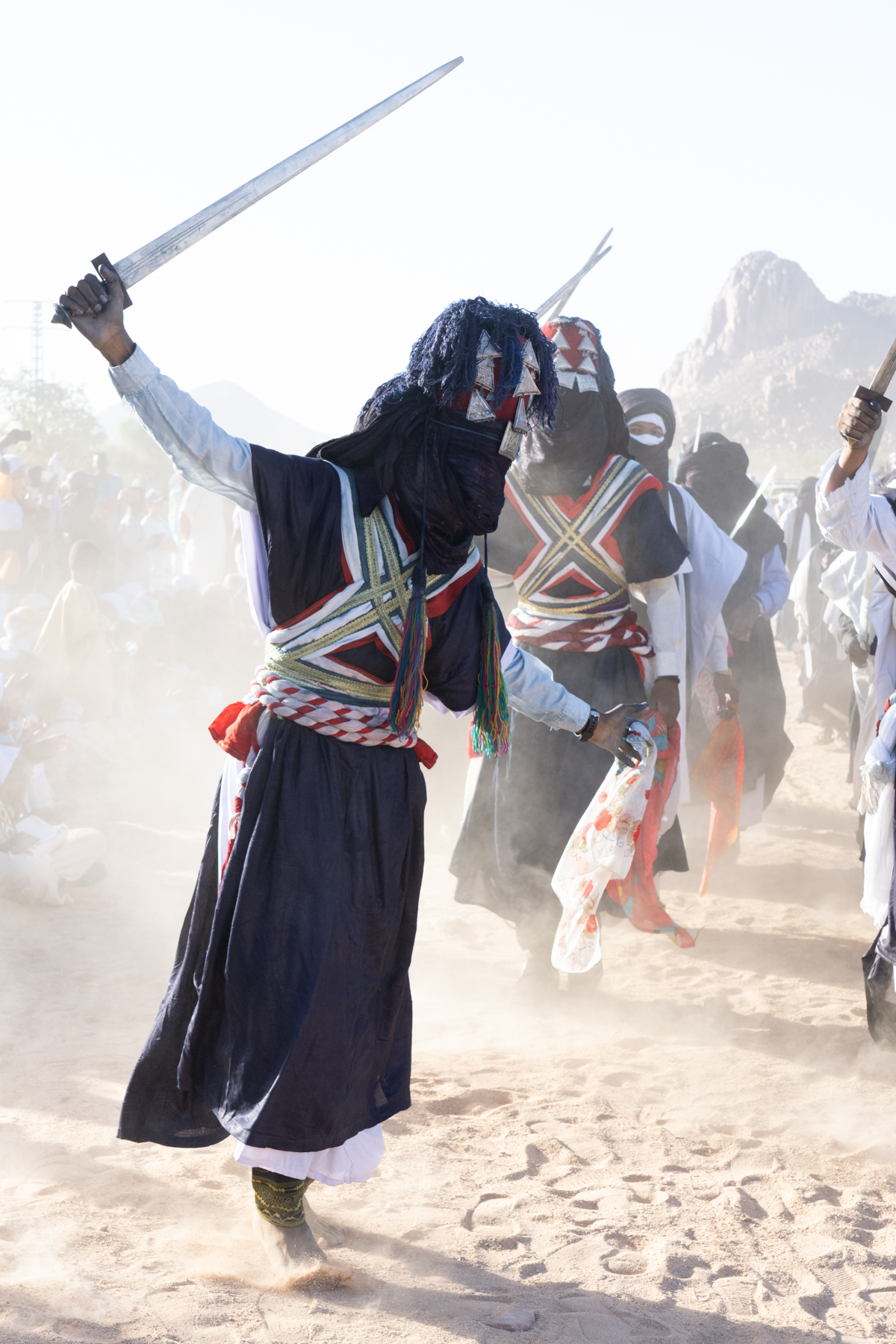
Tuareg men celebrating Sabiba waving their traditional Takouba swords in the air (image by Inger Vandyke)
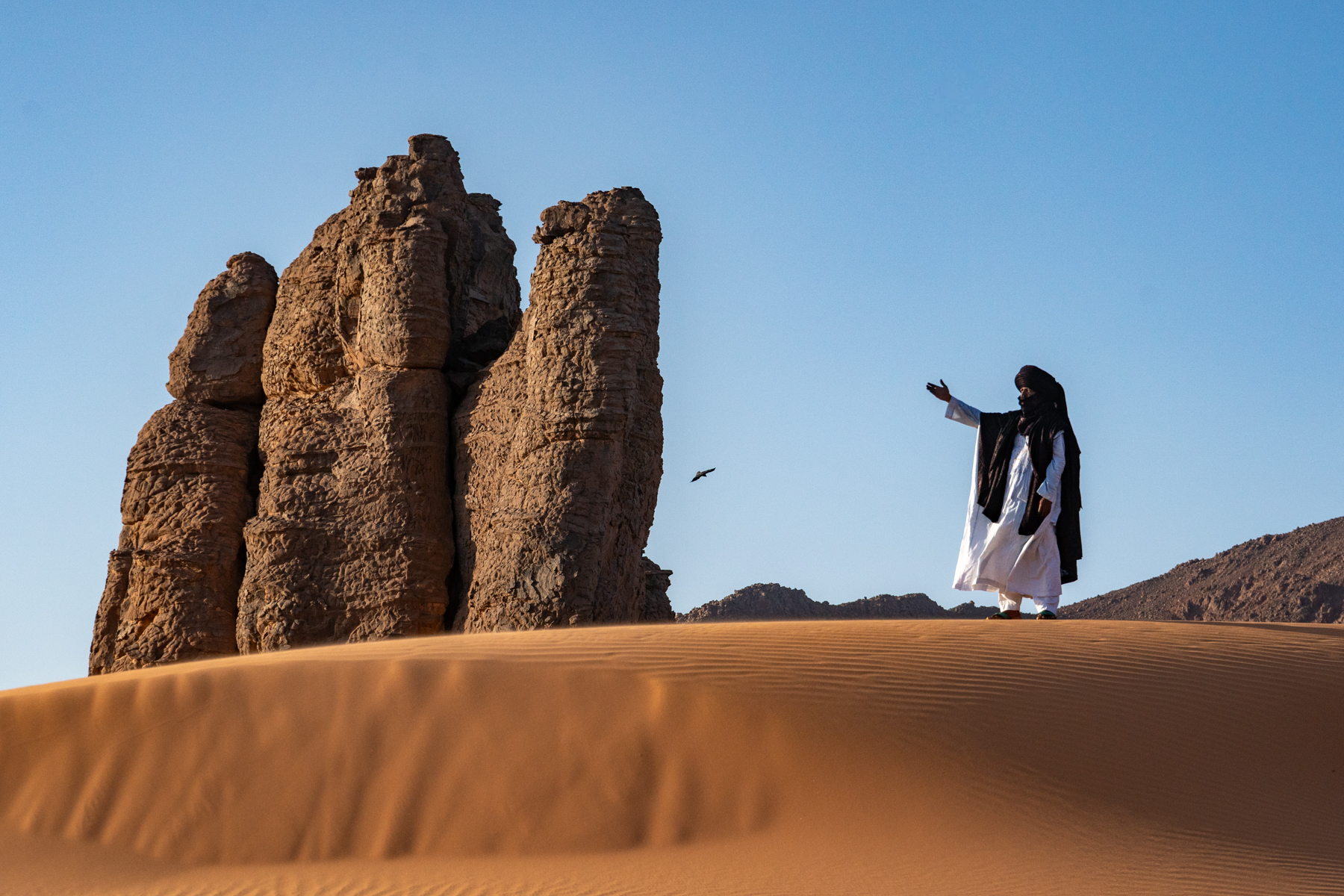
A Tuareg man waves his hand into the air setting a raven into flight in the desert (image by Inger Vandyke)
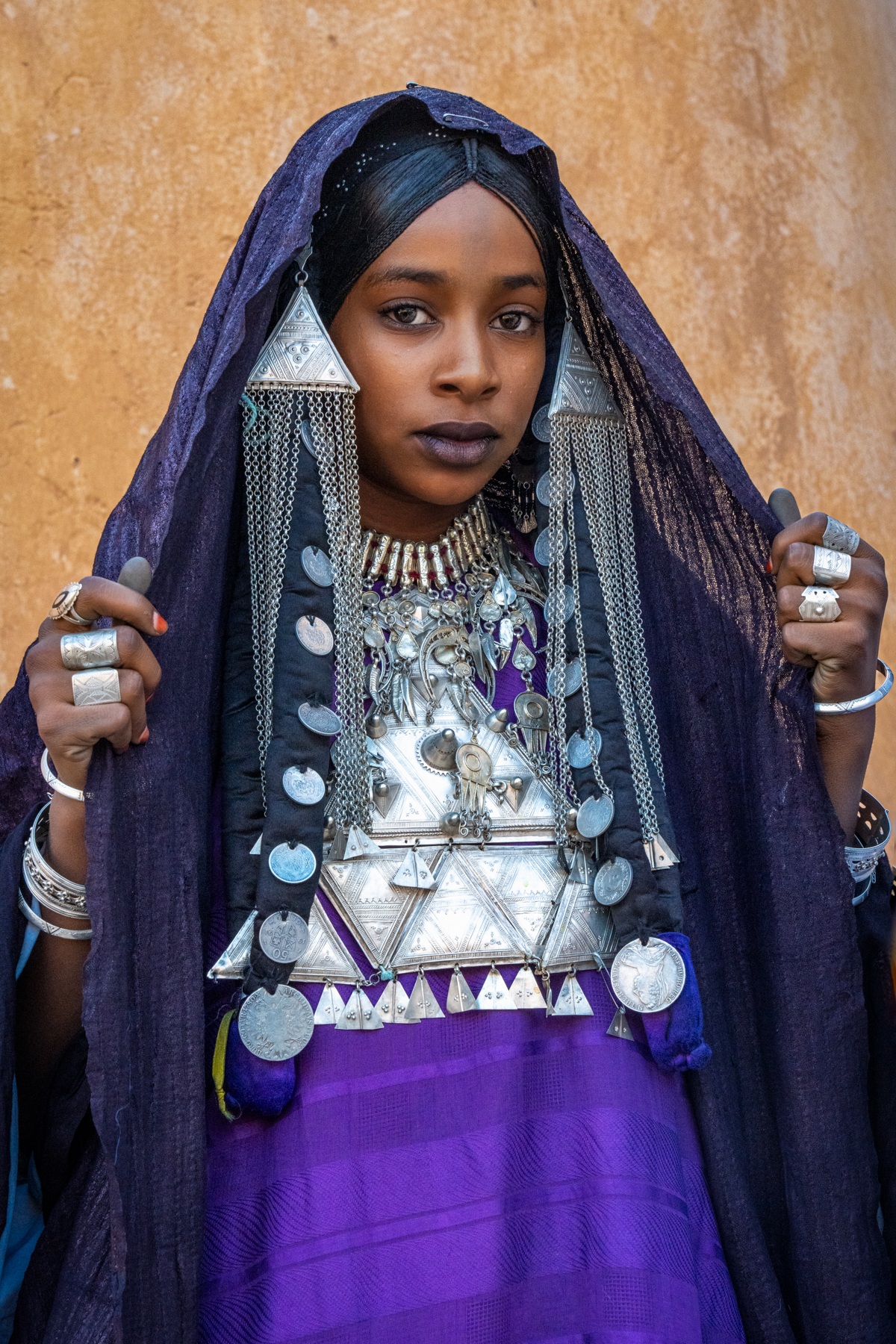
Beautiful Tuareg girl showing her incredible silver jewellery inside the Ksour of Taghorfit, near Djanet (image by Inger Vandyke)

Our Tuareg guide sitting in the spectacular caves of Le Cirque in Tadrart Rouge (image by Inger Vandyke)
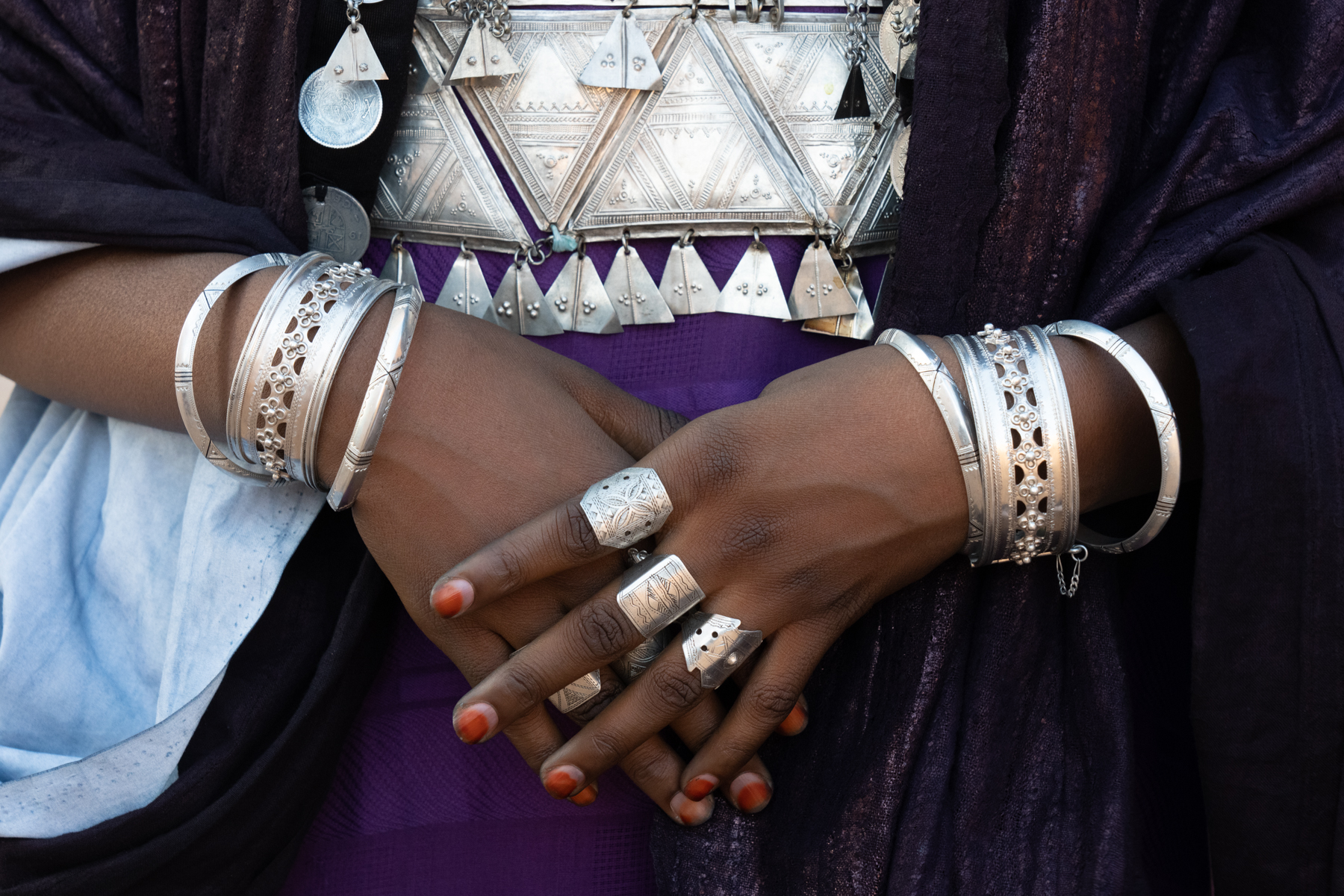
A spectacular selection of Tuareg silver jewellery. Each piece has a special meaning for the wearer (image by Inger Vandyke)
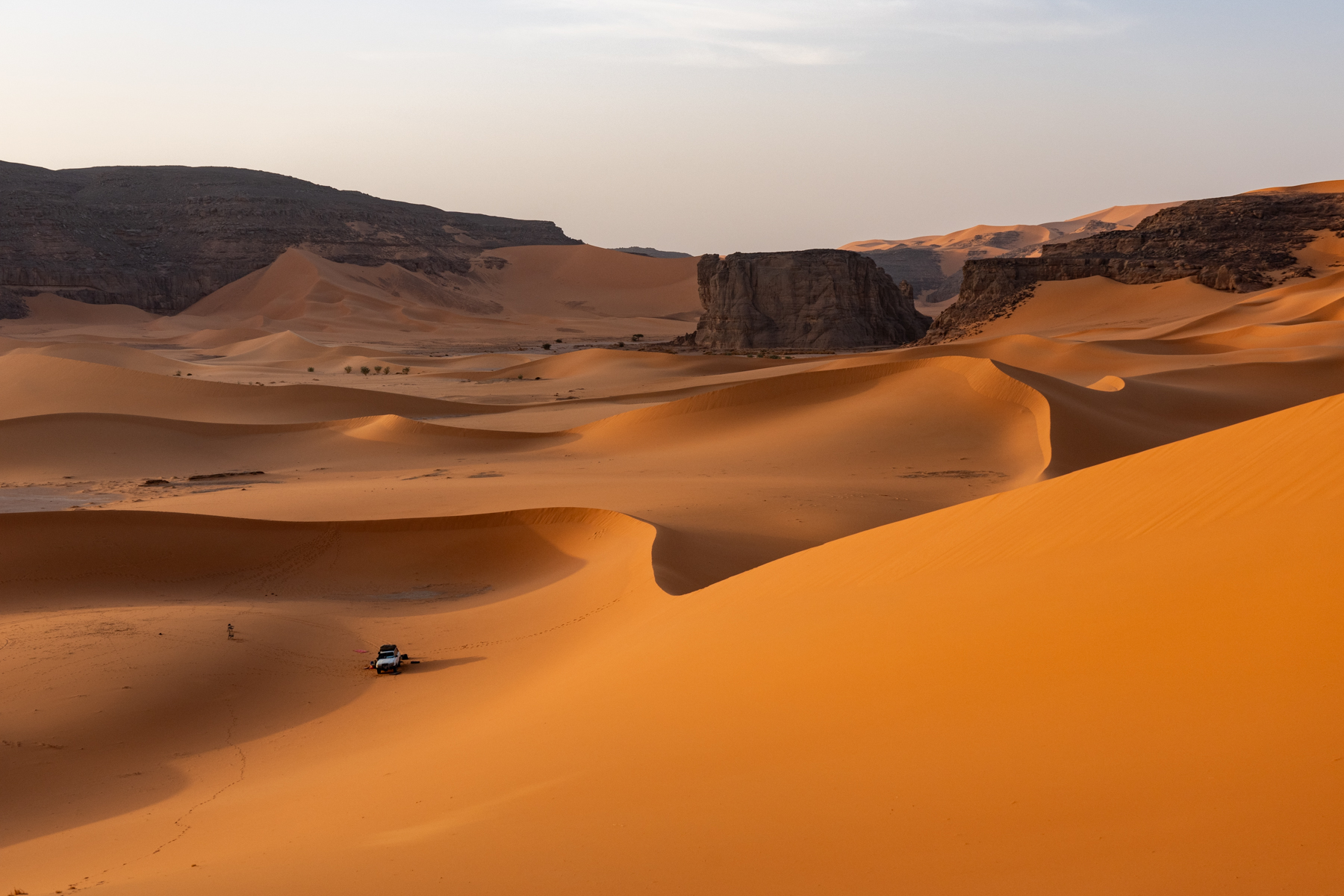
Setting up camp in the dunes of spectacular Moul-Ennaga, Tadrart Rouge (image by Inger Vandyke)

Portrait of a desert matriarch in her finery. She was so elegant and beautiful (image by Inger Vandyke)

The beautiful desert rock that is home to the famous Crying Bulls (image by Inger Vandyke)

Stunning Taghorfit Ksour (image by Inger Vandyke)

The famous Crying Bulls engravings (image by Inger Vandyke)

Preparing a Tuareg page boy (image by Inger Vandyke)

A beautiful young Tuareg boy in the crowd at Sabiba (image by Inger Vandyke)
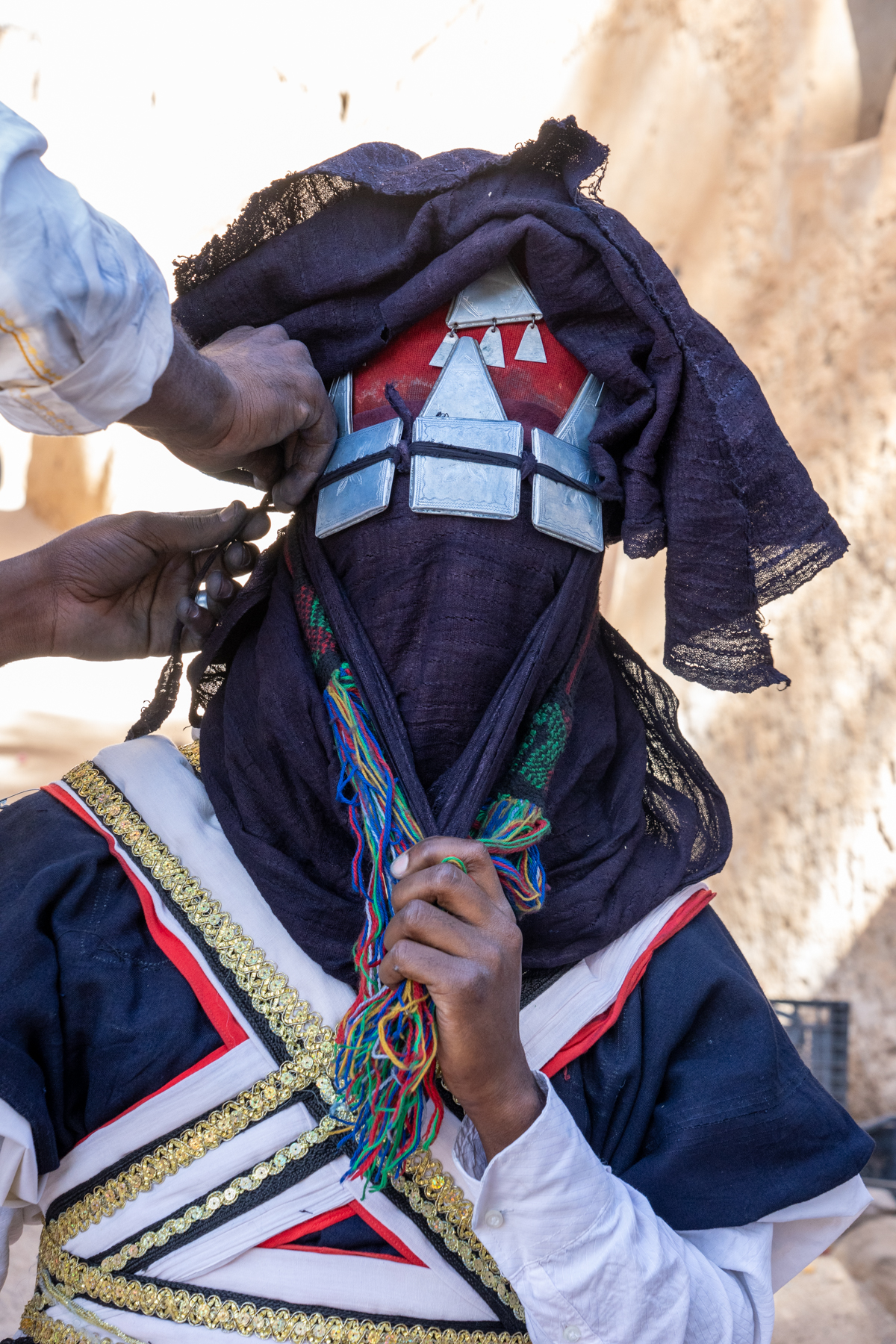
Preparing the warriors for Sabiba is a detailed and intricate process (image by Inger Vandyke)
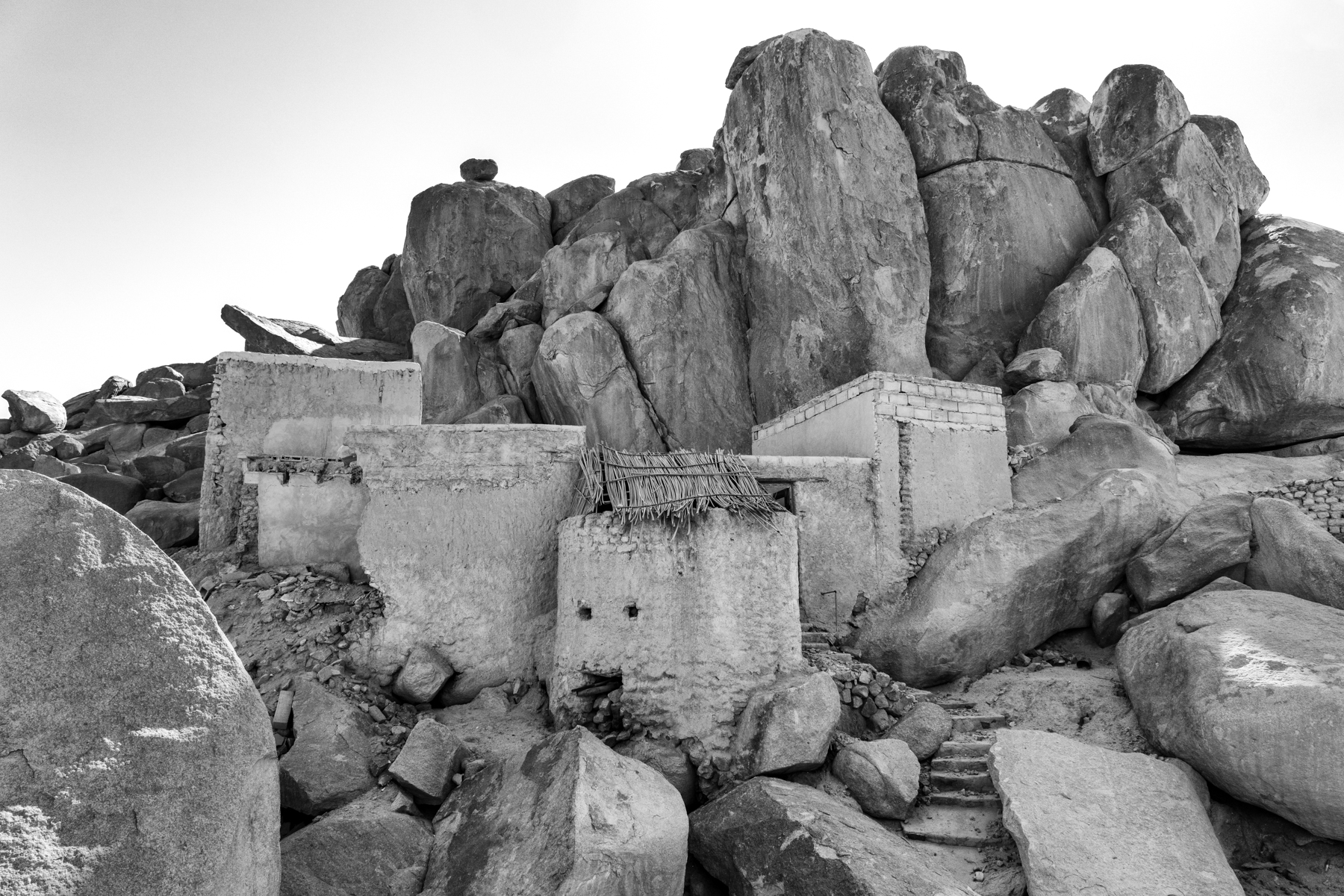
The ruined Ksour of Zalouaz is one of the least preserved in Djanet. It is still photogenic however (image by Inger Vandyke)

The stunning night sky near Djanet (image by Inger Vandyke)
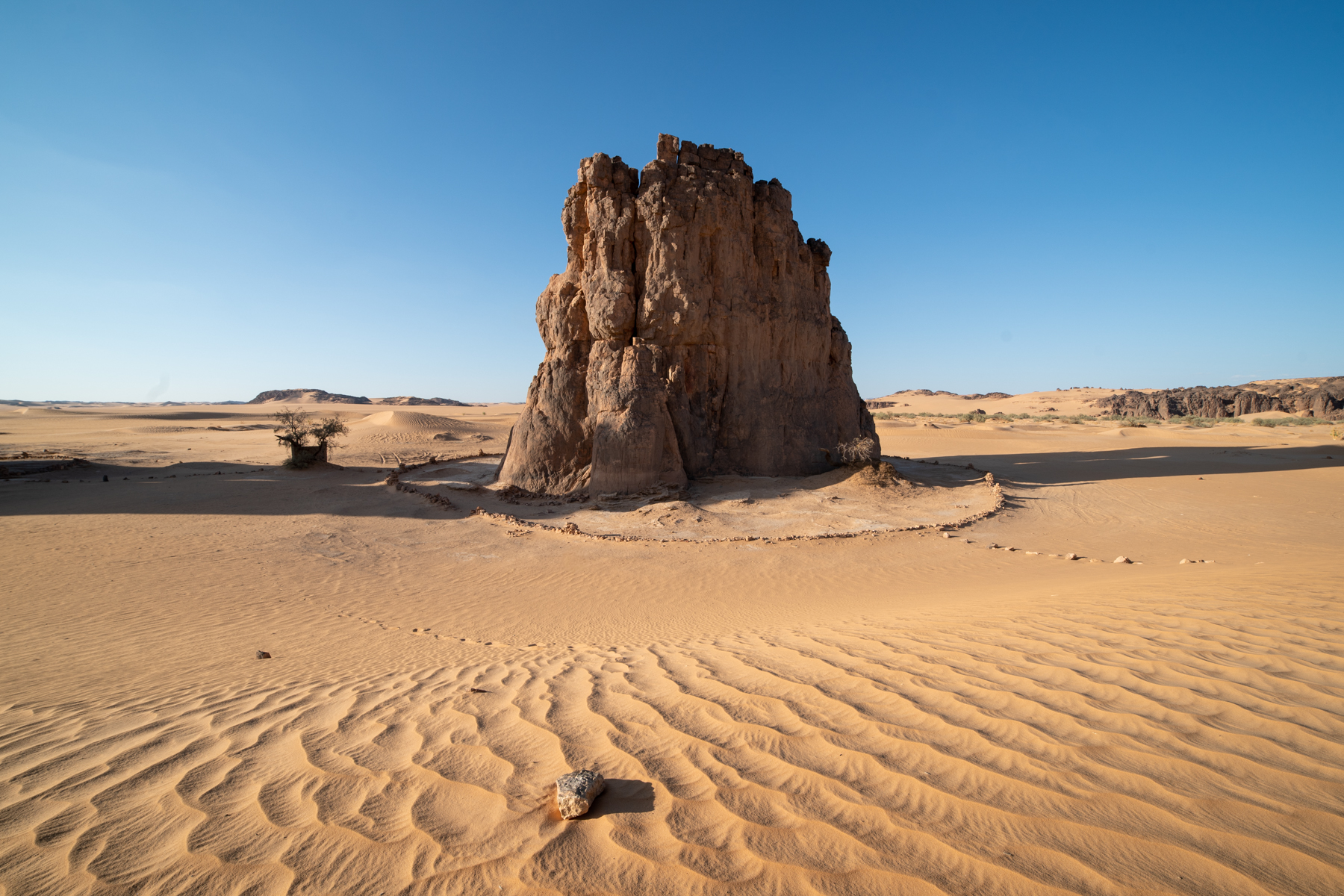
Exloring ancient engraving sites near Djanet (image by Inger Vandyke)
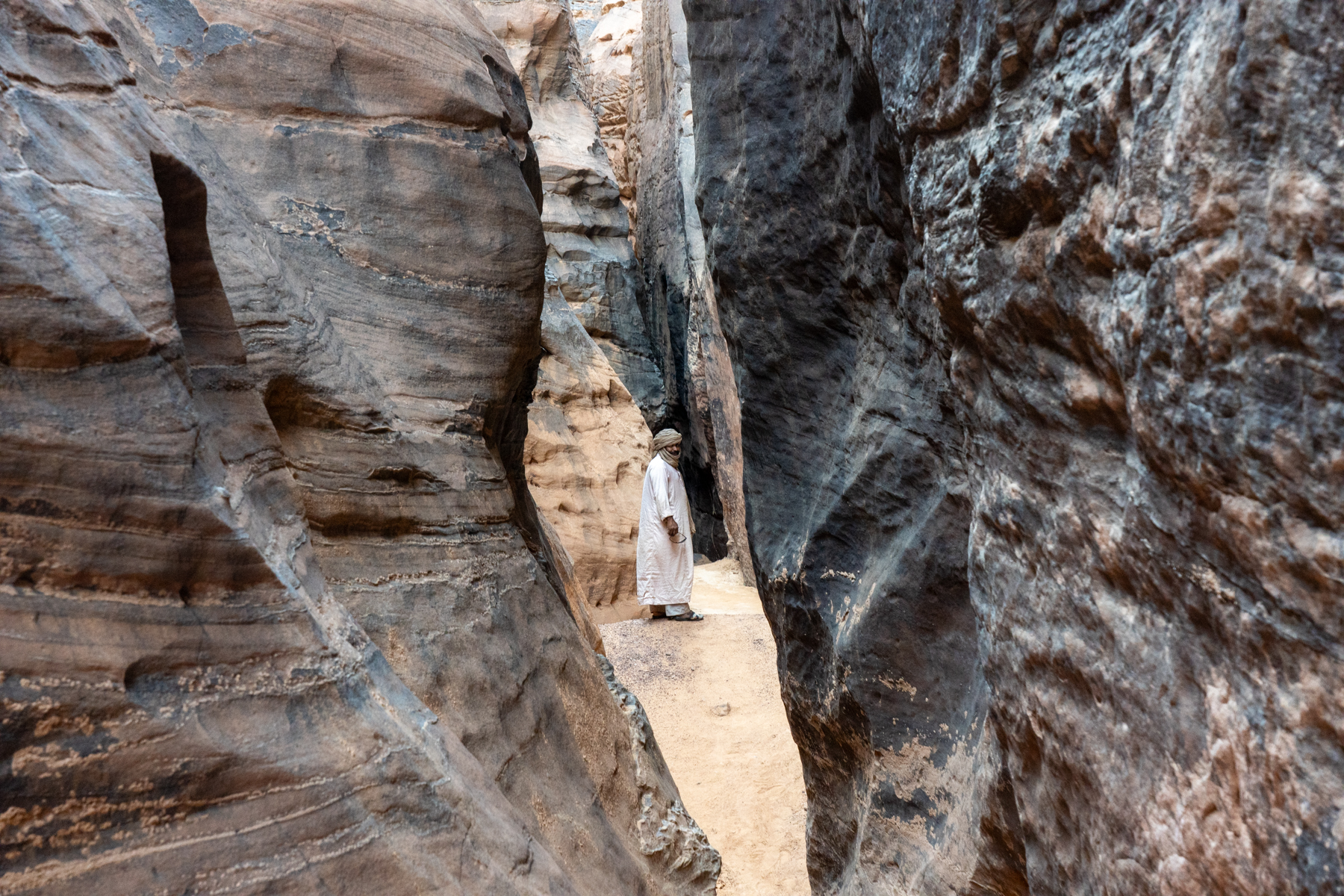
Exploring a gigantic slot canyon in Tadrart Rouge (image by Inger Vandyke)

Two Sabiba warriors (image by Inger Vandyke)
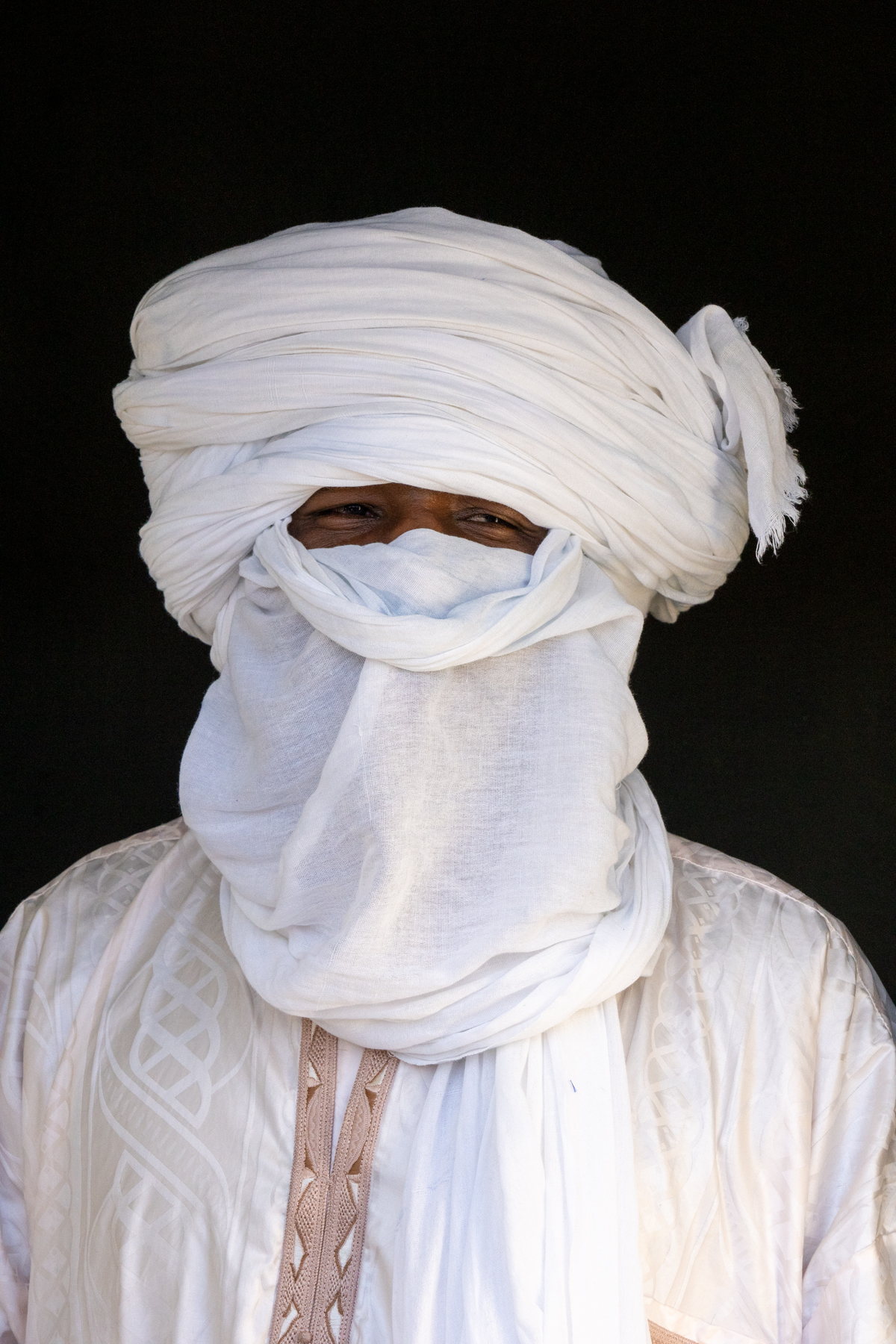
Tuareg man wearing a multi-layered Chech, the everyday wear for men in Tuareg culture (image by Inger Vandyke)
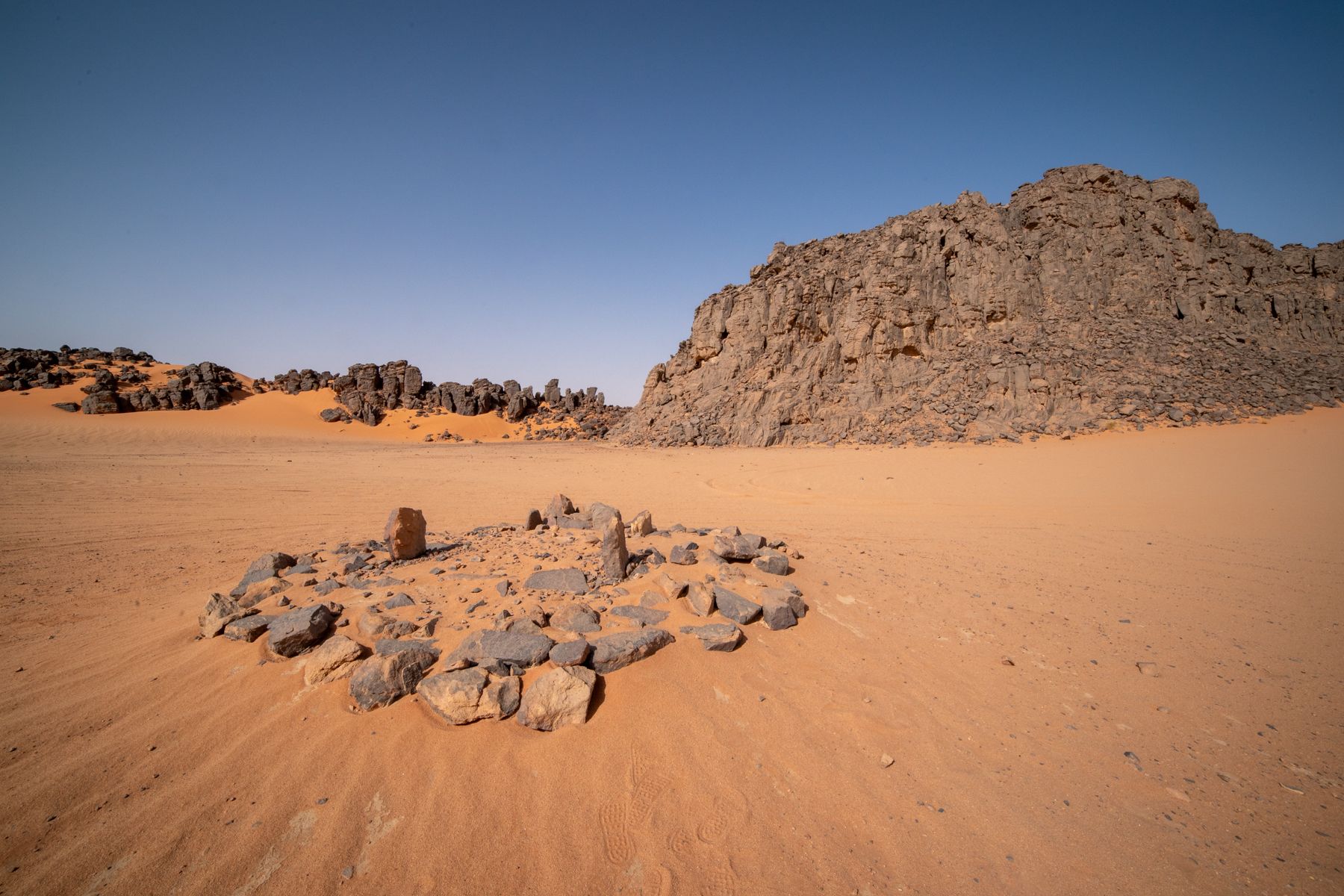
Exploring the grave site of Ghawen, a Chadian trader from Djanet's ancient past (image by Inger Vandyke)

Tuareg grooms adorned in gold for their wedding (image by Inger Vandyke)
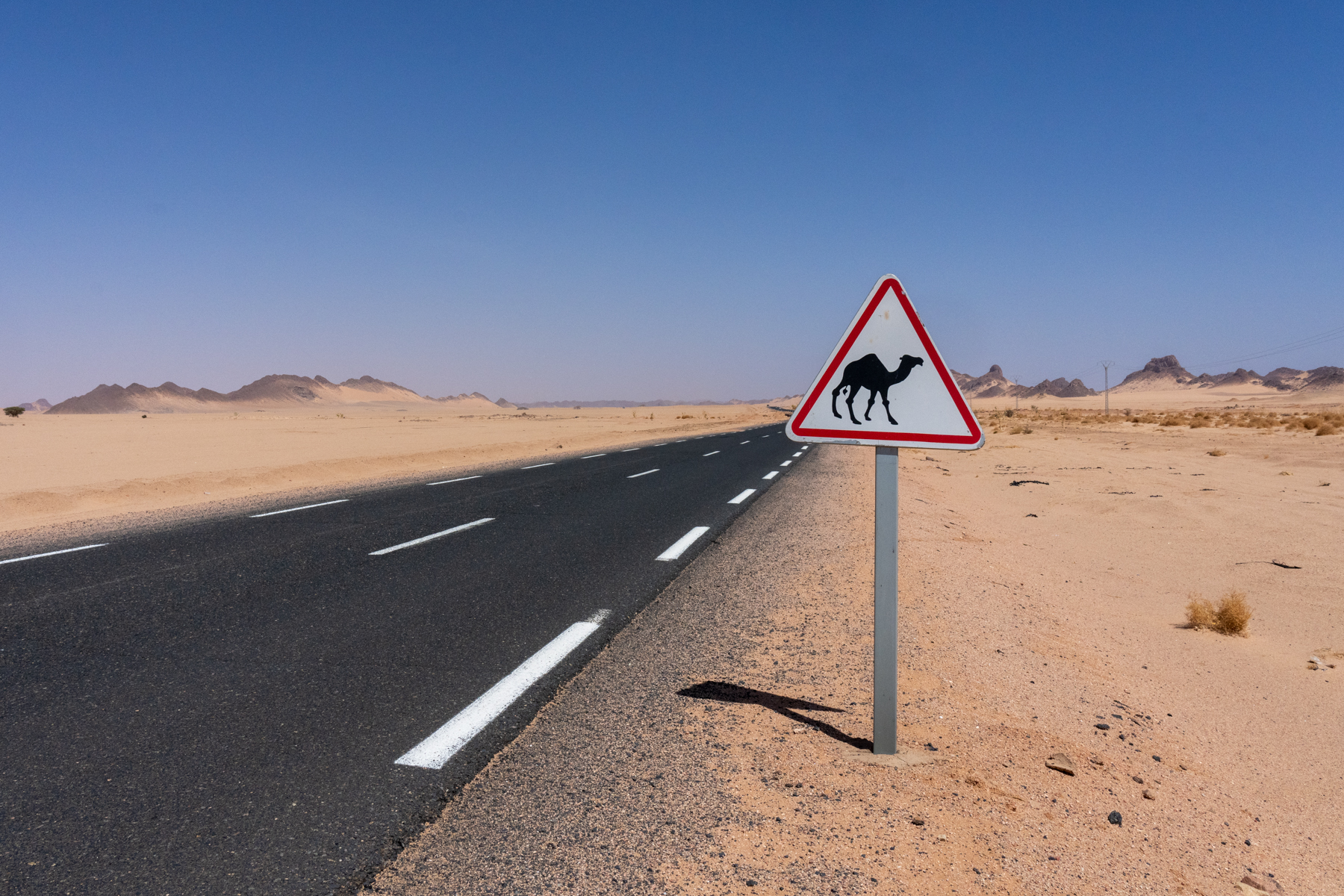
Beware of Camels sign on the road that links Algeria to Niger and Libya (image by Inger Vandyke)
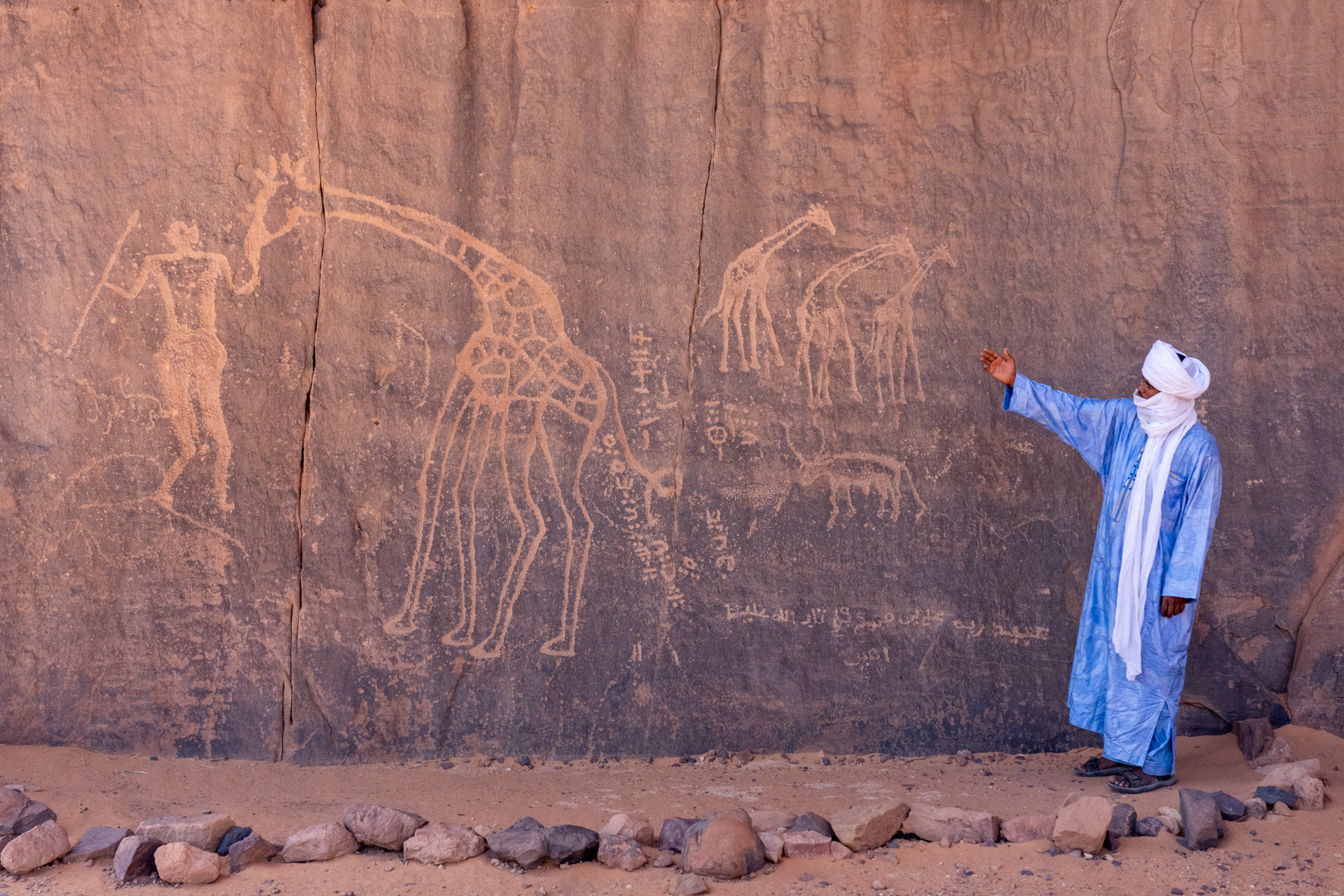
The giraffe engravings at Wan Ahar in Tadrart Rouge (image by Inger Vandyke)

The ancient cemetery at the Ksour of Adjehil (image by Inger Vandyke)
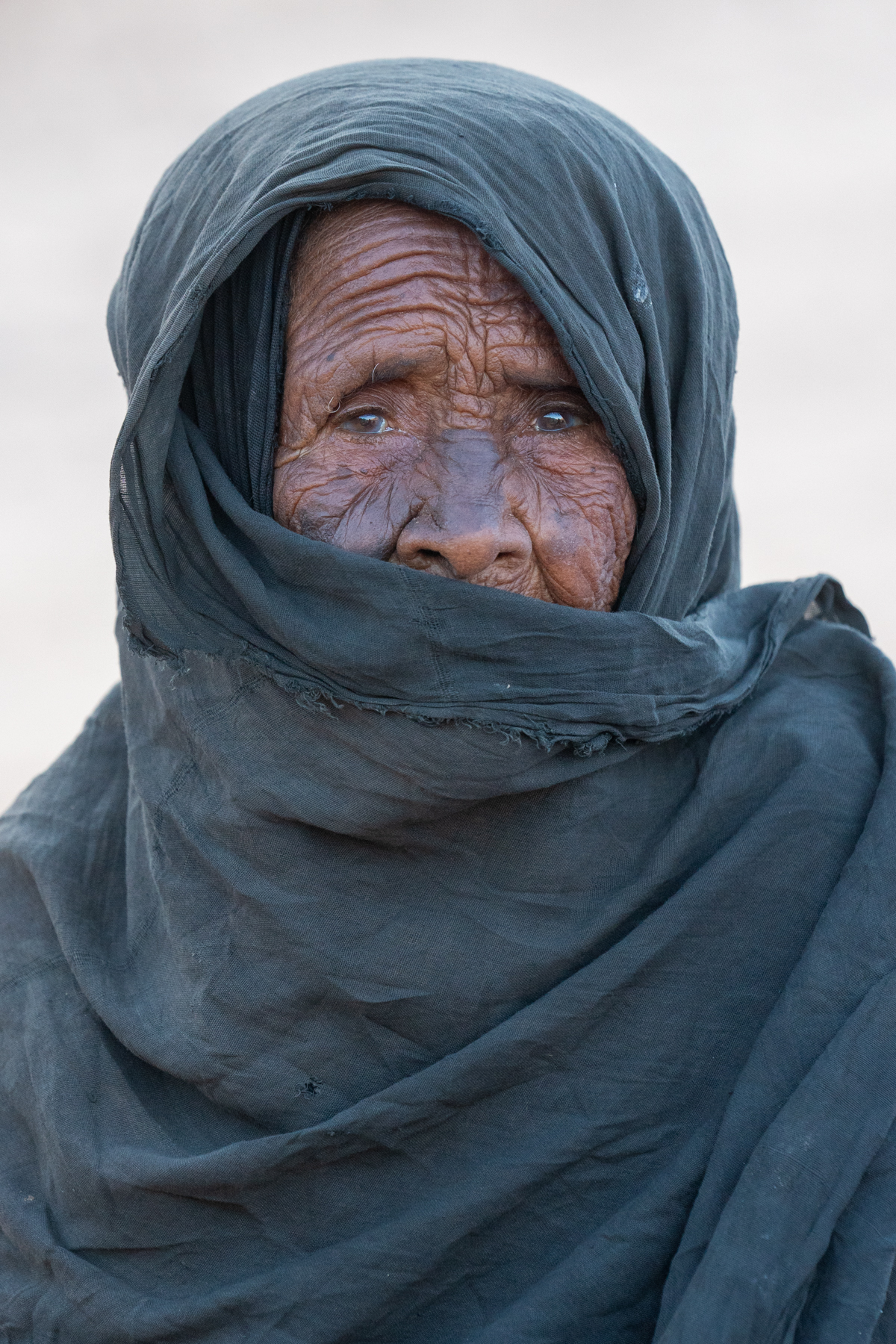
Portrait of an elderly Tuareg woman in the desert (image by Inger Vandyke)
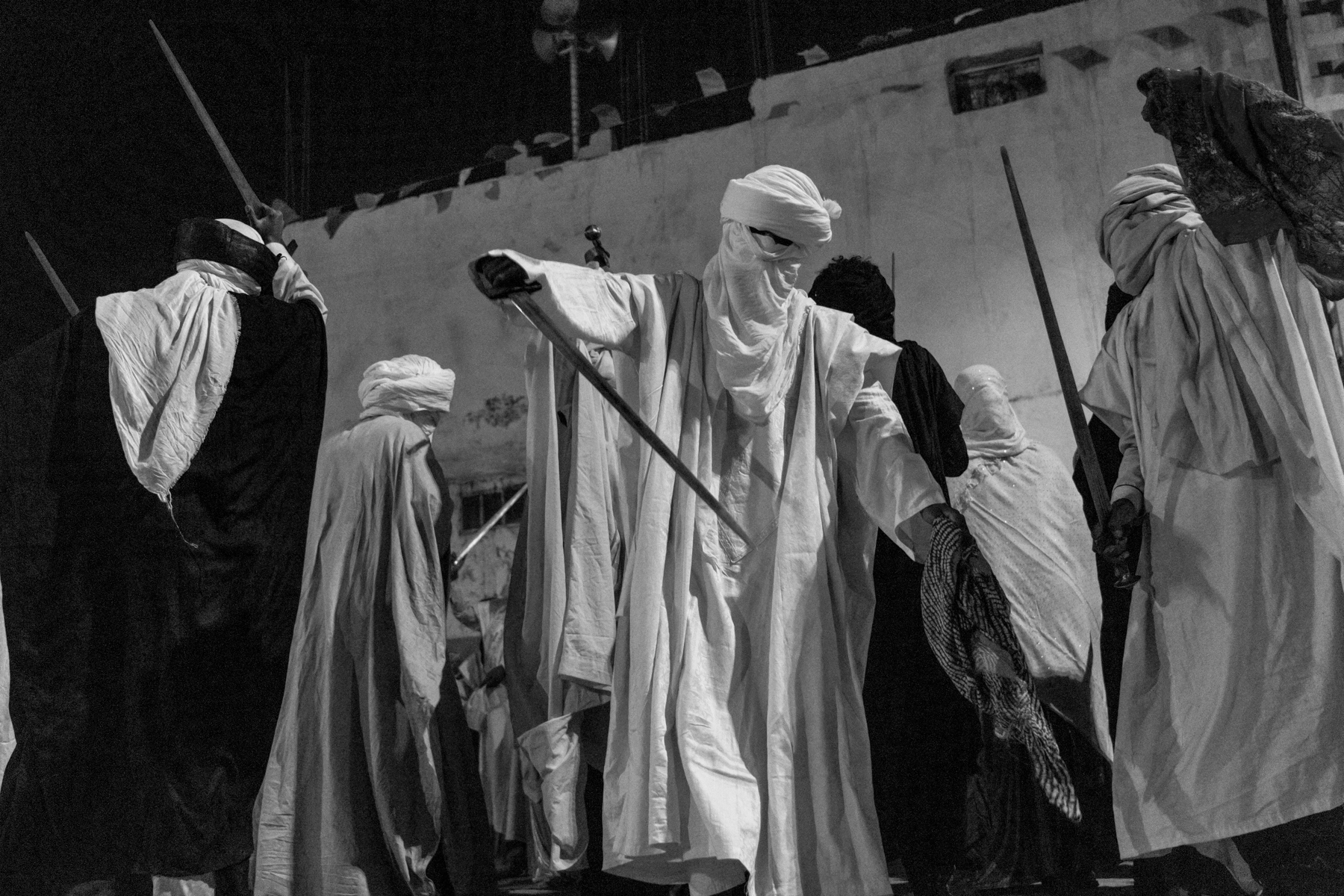
Night time practice (rehearsal) session for Sabiba called Timoulawine (image by Inger Vandyke)
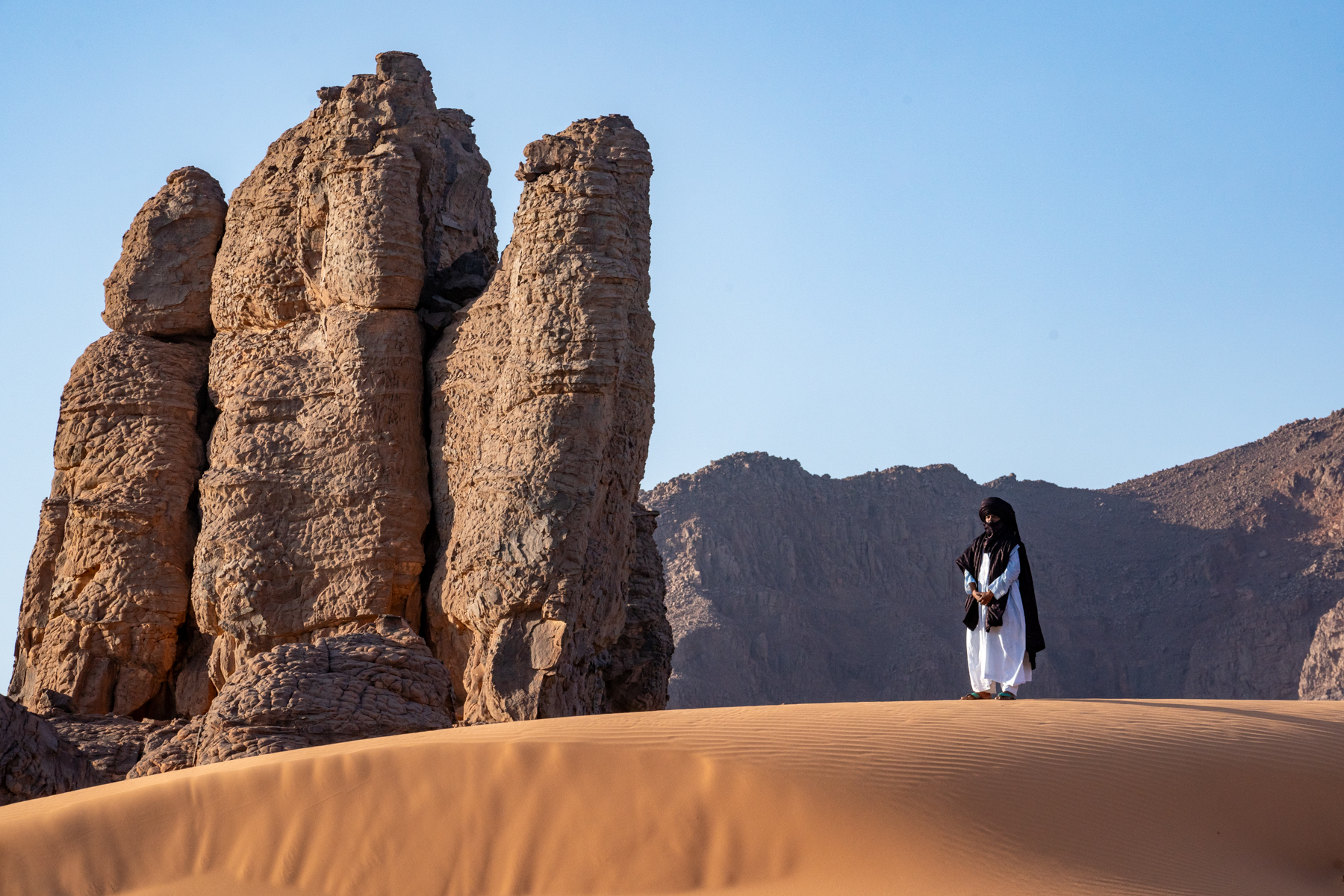
A Tuareg man adorns a spectacular corner of the Sahara close to the town of Djanet in southern Algeria (image by Inger Vandyke)
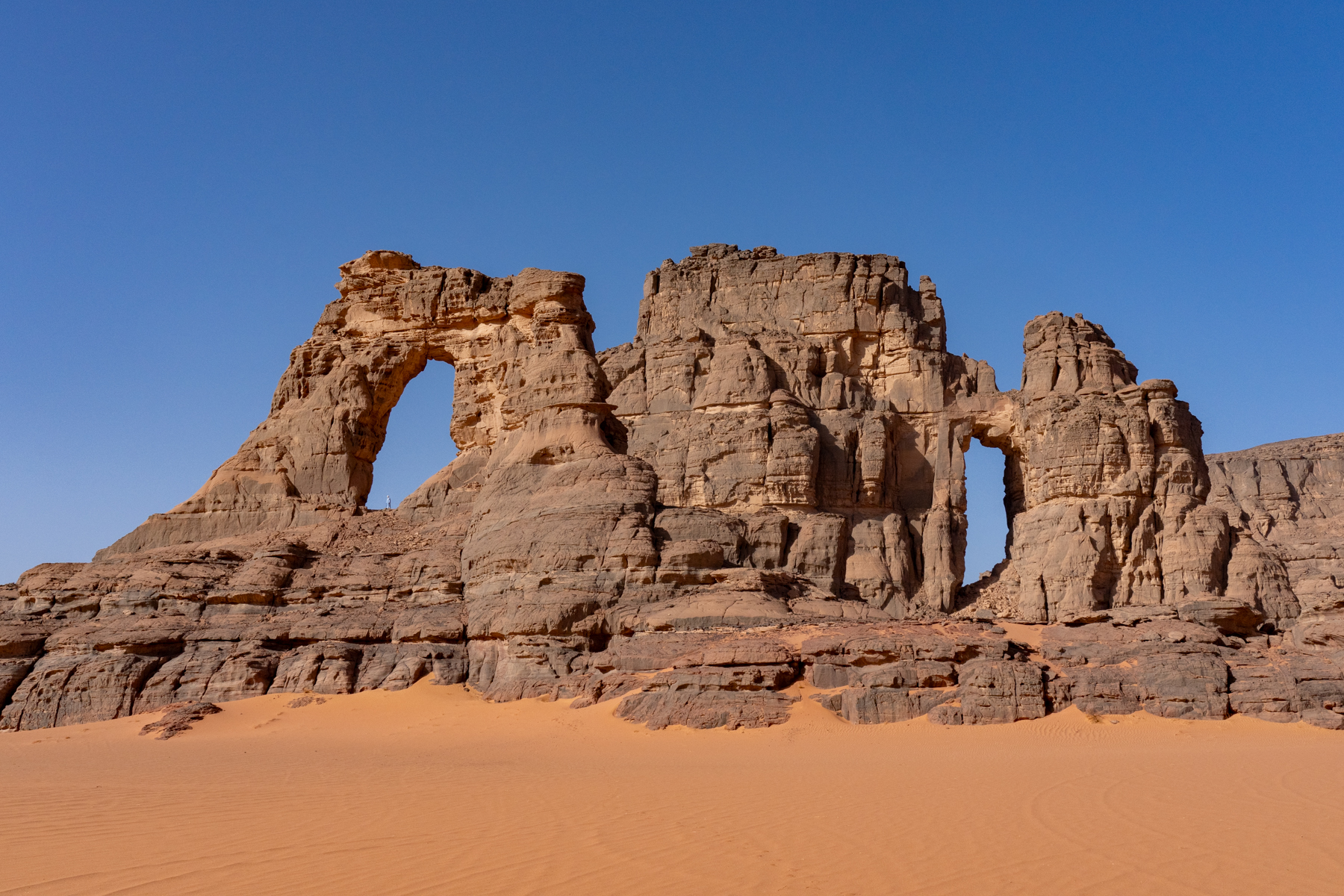
The incredible Timjadawin, the Cathedral of Tadrart Rouge (image by Inger Vandyke)

Tuareg men arrive for a sunset camel dance (image by Inger Vandyke)

A Sabiba warrior concentrates on the ceremony (image by Inger Vandyke)

The last blush of day at Erg Admer (image by Inger Vandyke)

Dunescapes of Tadrart (image by Inger Vandyke)
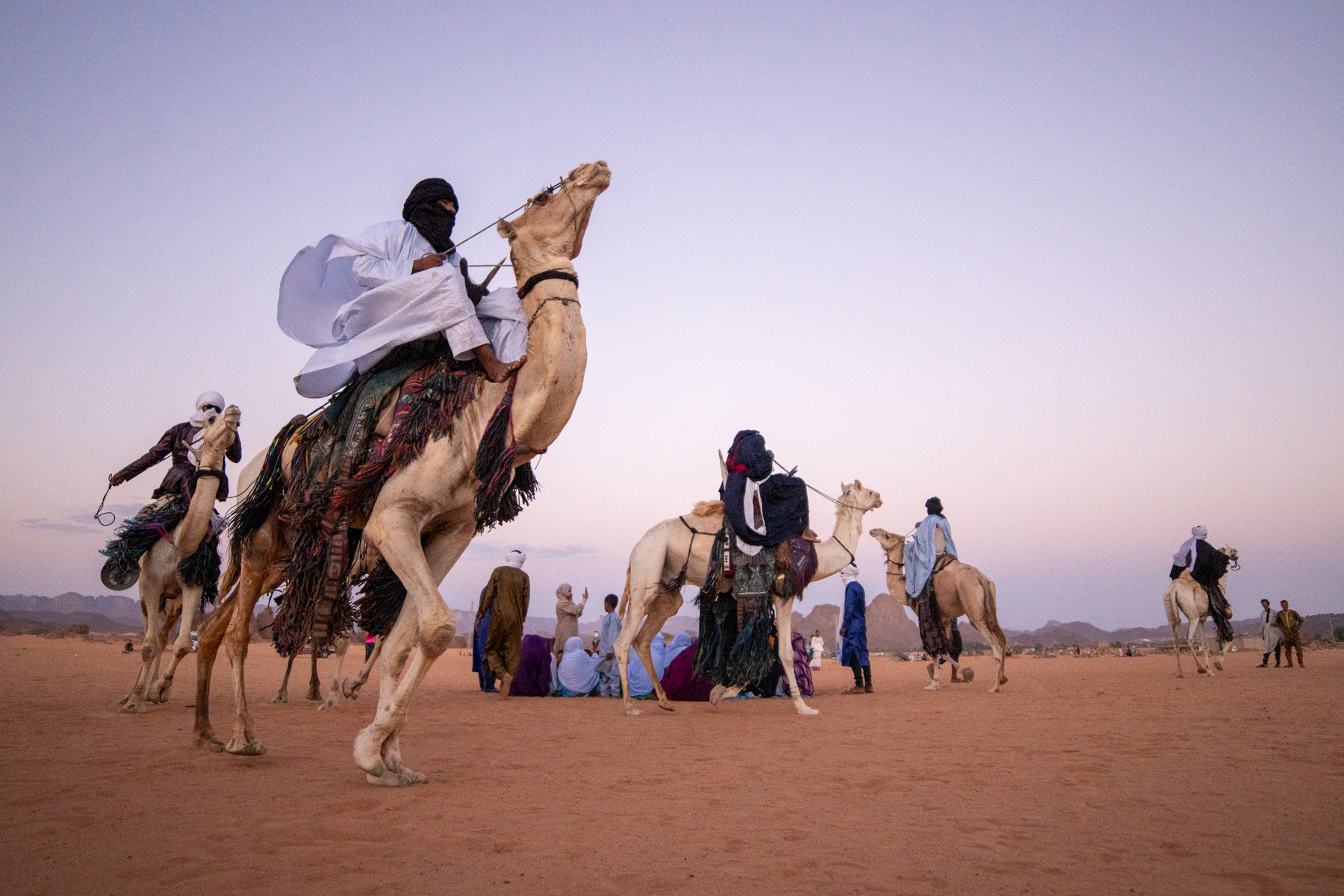
Camel dancers circle a group of singing women at dusk as part of a traditional Tuareg wedding ceremony (image by Inger Vandyke)

Rock pillar named The Hedgehog (image by Inger Vandyke)

Beautiful Tuareg girls (image by Inger Vandyke)
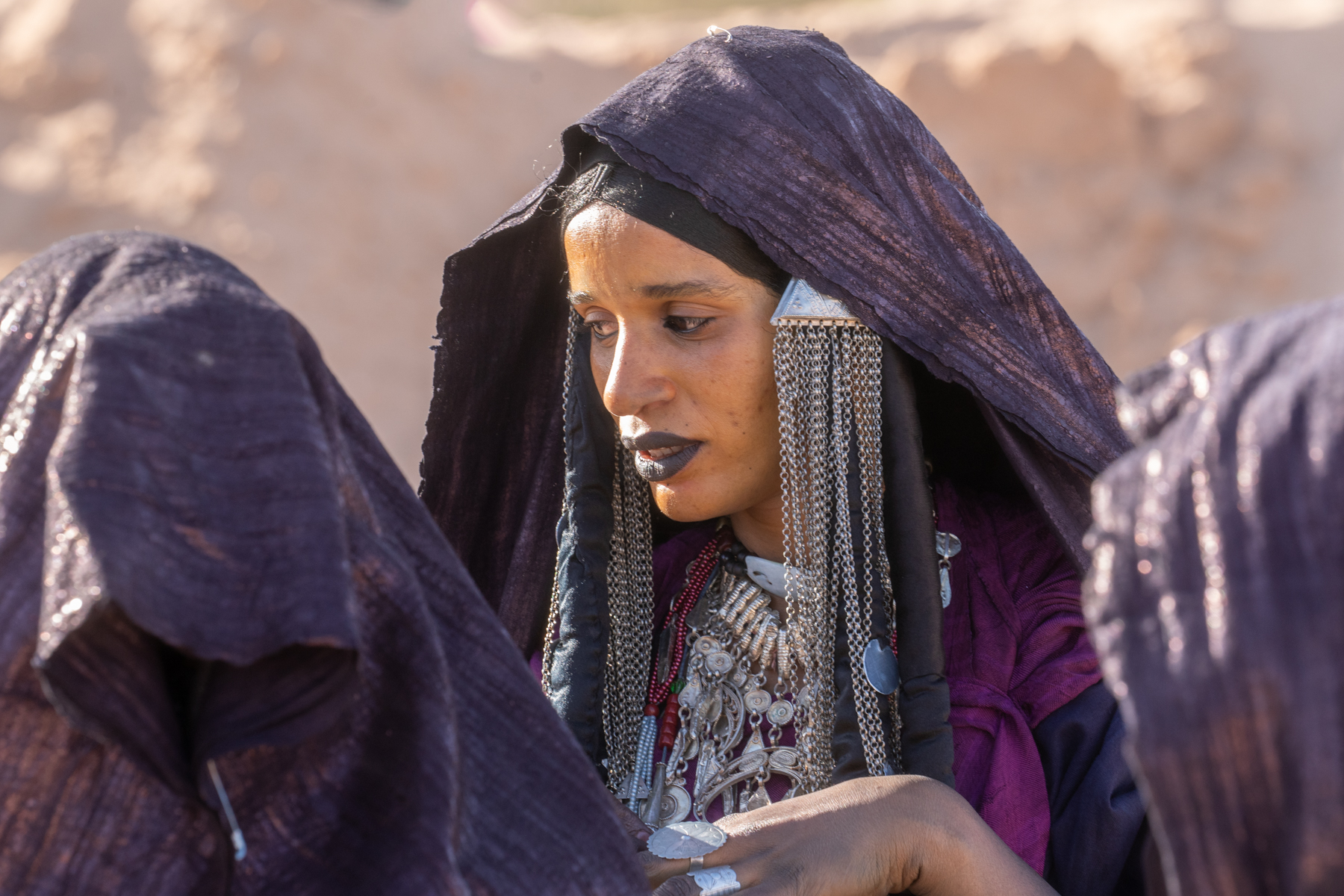
Tuareg women at Sabiba (image by Inger Vandyke)
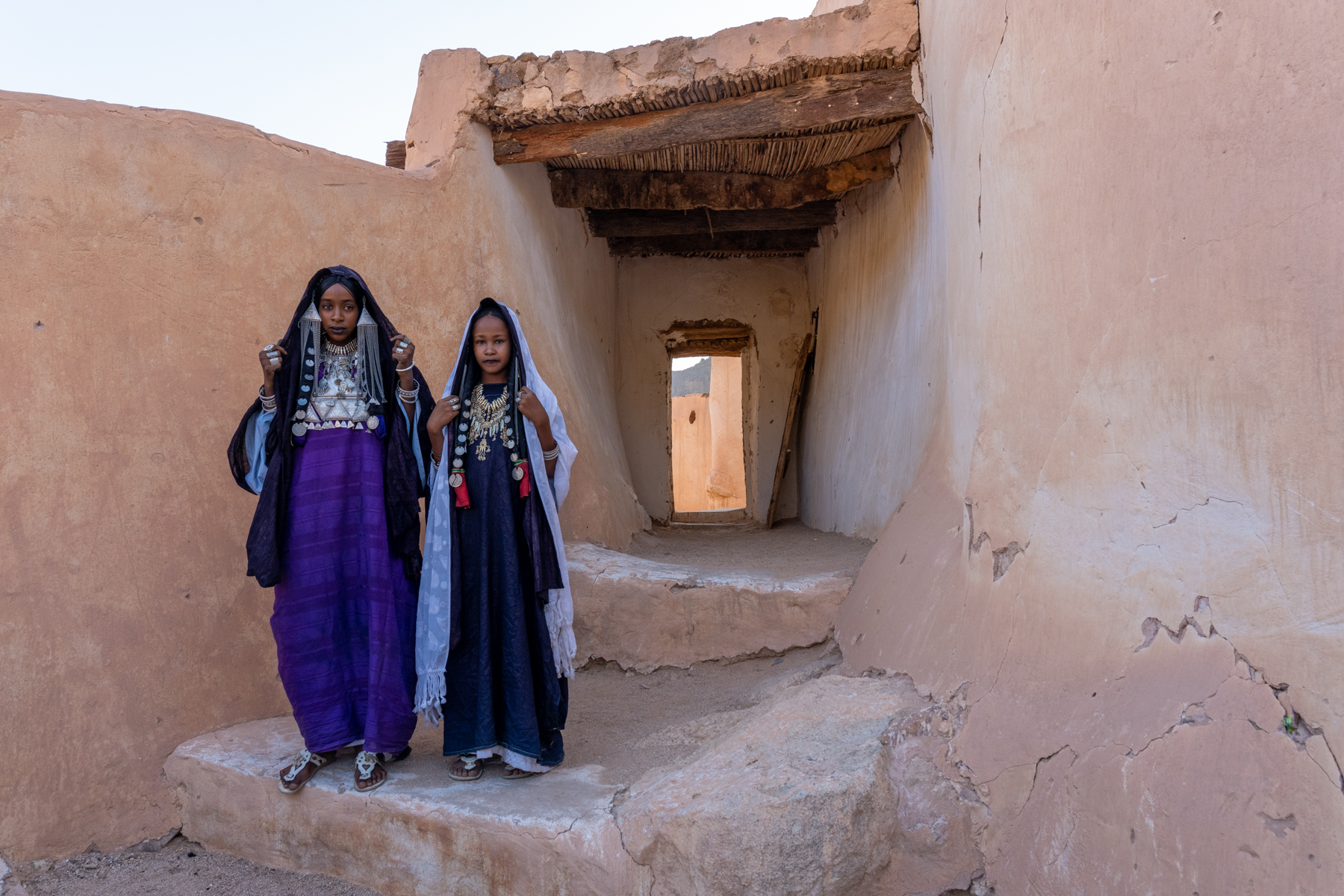
Beautiful young Tuareg girls dressed up in traditional clothes for the celebration of Sabiba (image by Inger Vandyke)
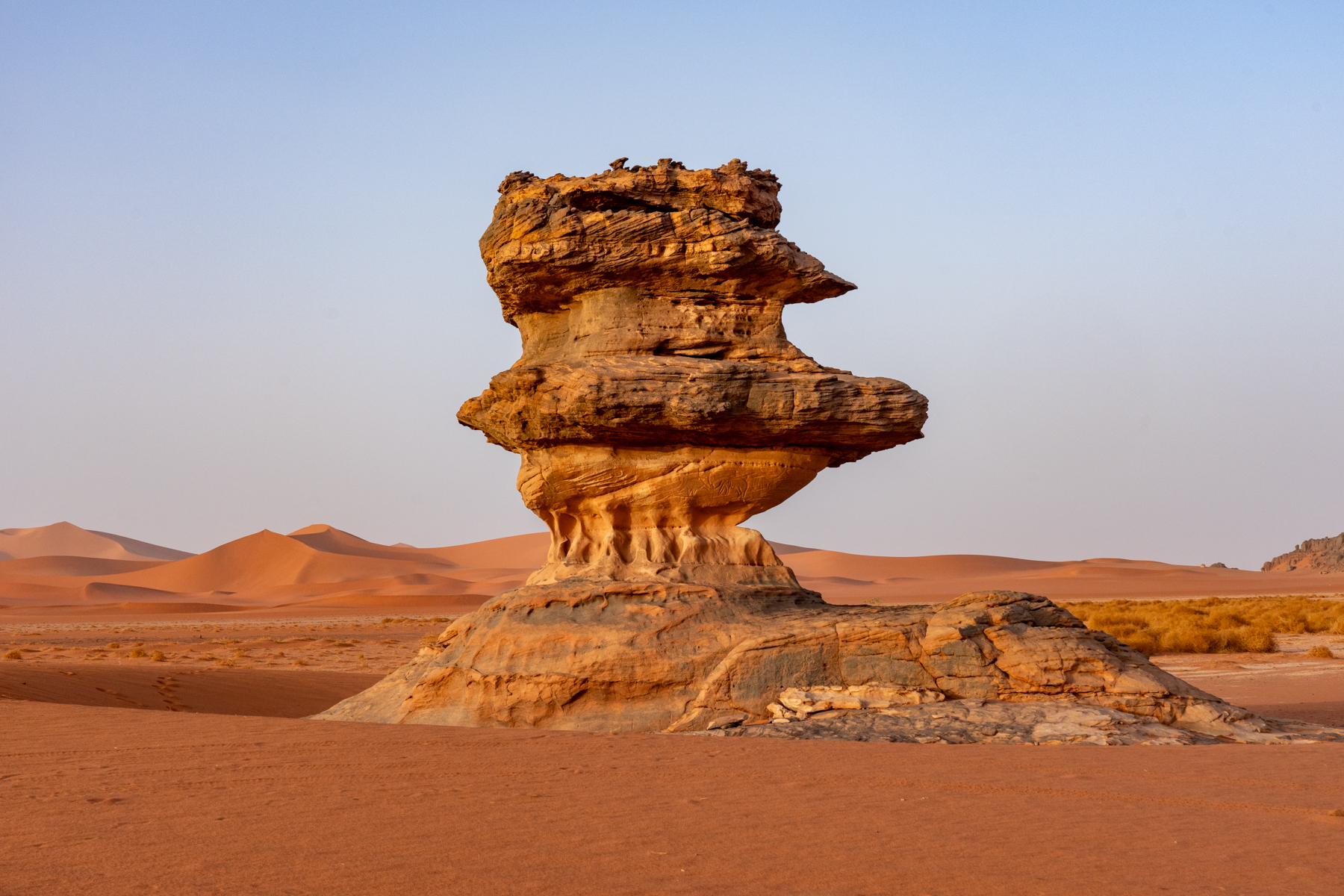
Dotted around Tadrart Rouge is countless wind and water eroded rock pillars. Even this one has an engraving of an elephant under its largest layer (image by Inger Vandyke)

Tuareg arts on display in Taghorfit (image by Inger Vandyke)

Tuareg warriors preparing to dance (image by Inger Vandyke)

Fossilised lion footprints in Tadrart (image by Inger Vandyke)
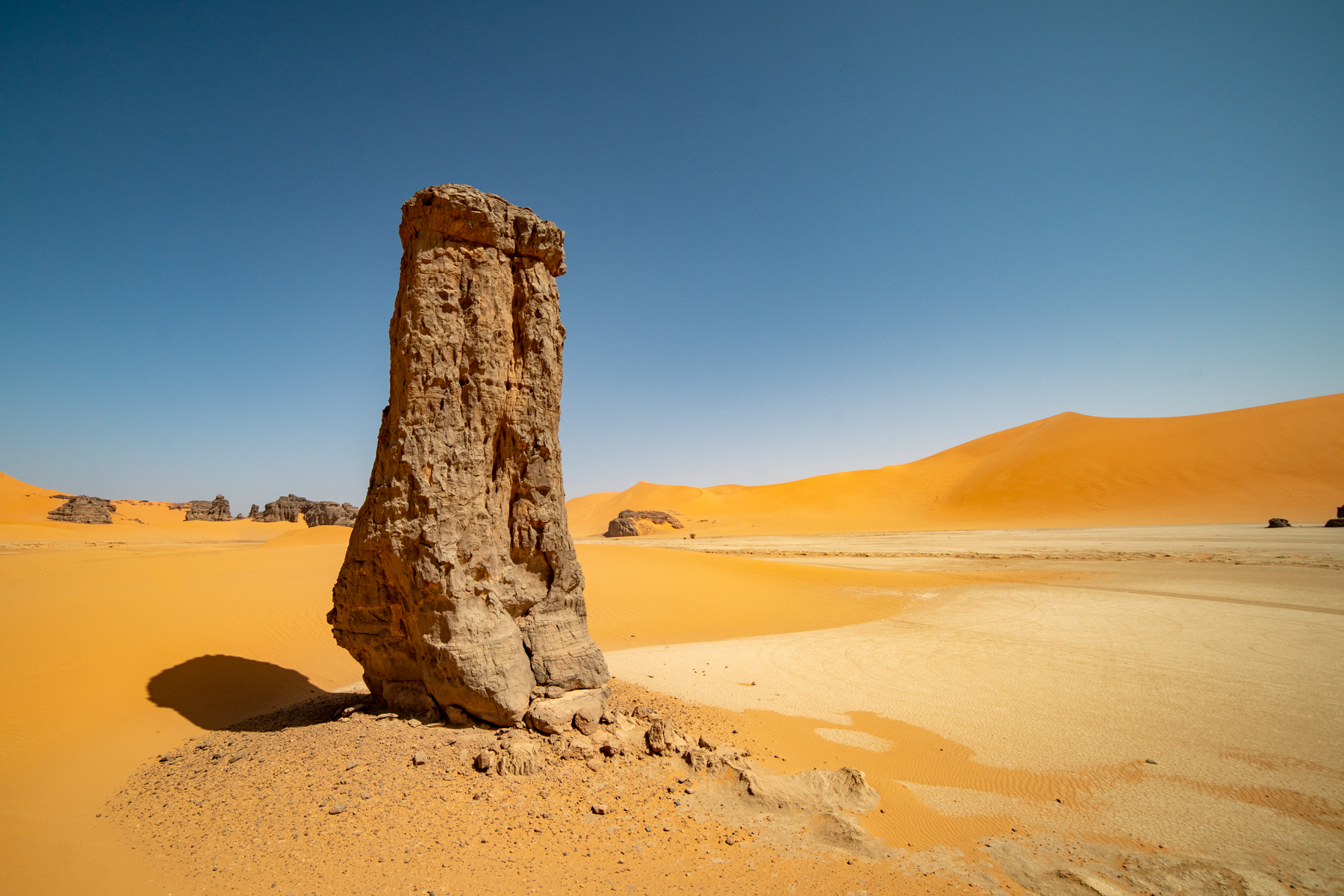
Rock island in a sea of sand at Tadrart (image by Inger Vandyke)

Tuareg people cherish their camels and there is no better way to understand this relationship than watching them prepare for a camel dance (image by Inger Vandyke)
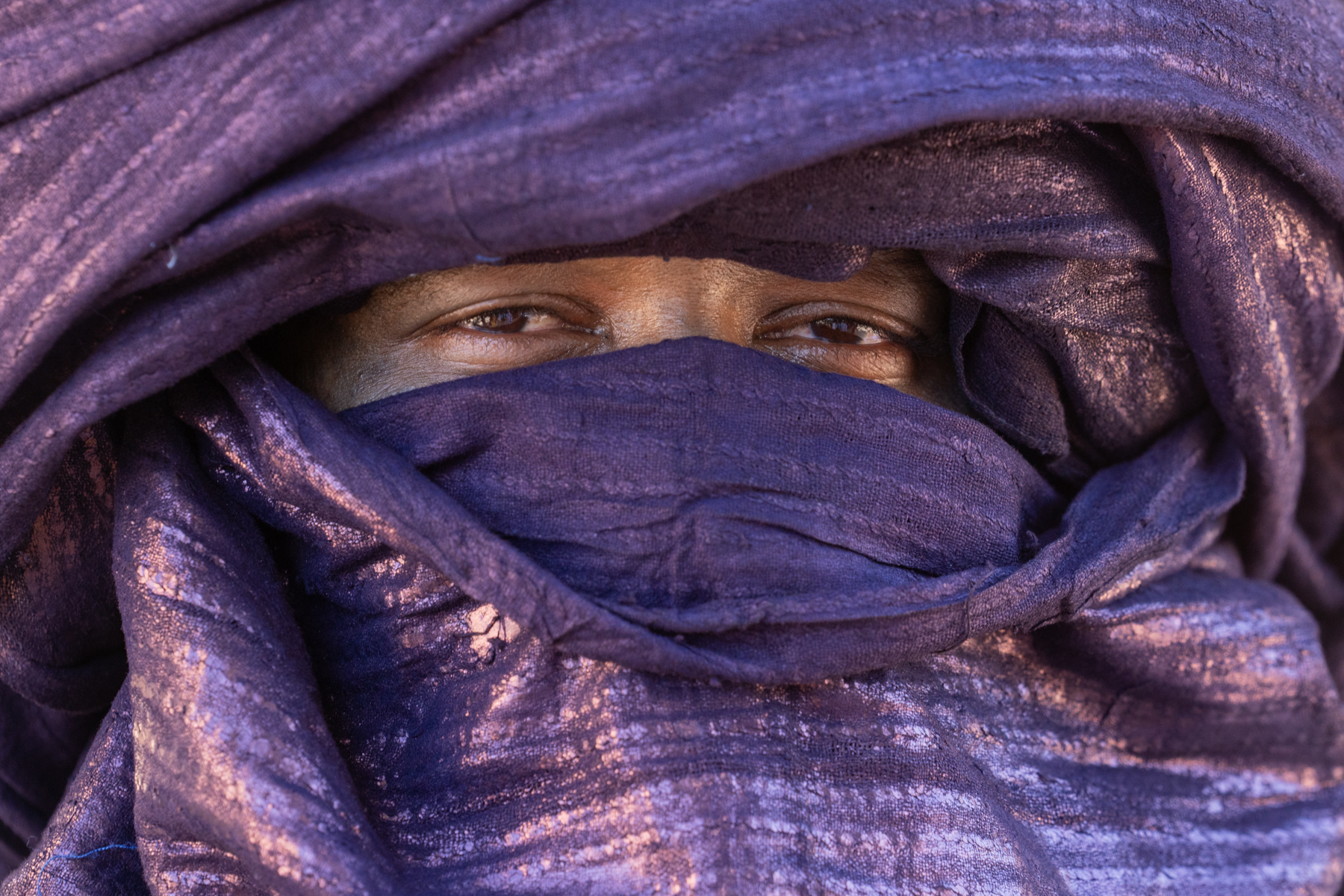
Swathed in indigo, Tuareg men are truly the Blue Men of the Sahara (image by Inger Vandyke)

Composite image of a large crescent moon in the night sky near Djanet (image by Inger Vandyke)
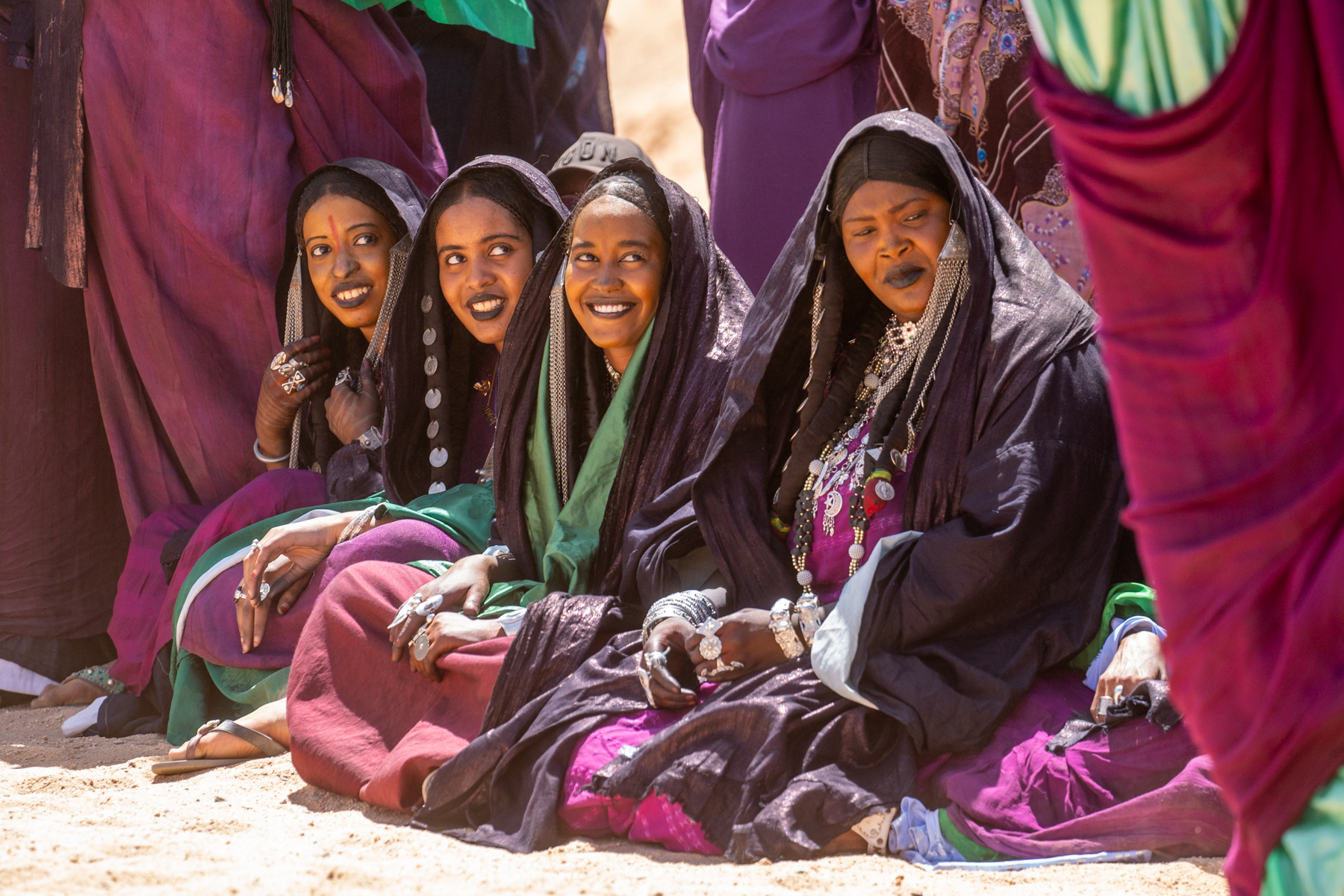
Tuareg women dressed for Sabiba (image by Inger Vandyke)

A young Tuareg boy dressed for a wedding (image by Inger Vandyke)

Tuareg women chatting at Sabiba (image by Inger Vandyke)

Sunset profile of a Tuareg man (image by Inger Vandyke)

Portrait of a Tuareg girl at Sabiba (image by Inger Vandyke)

View of Zalouaz, the least preserved Ksour in Djanet (image by Inger Vandyke)

The leader of the Sabiba warriors (image by Inger Vandyke)

Tuareg boys dressed up for a wedding (image by Inger Vandyke)

A young semi-nomadic Tuareg boy sits inside his hut (image by Inger Vandyke)

Tuareg warriors lined up to celebrate the annual festival of Sabiba (image by Inger Vandyke)
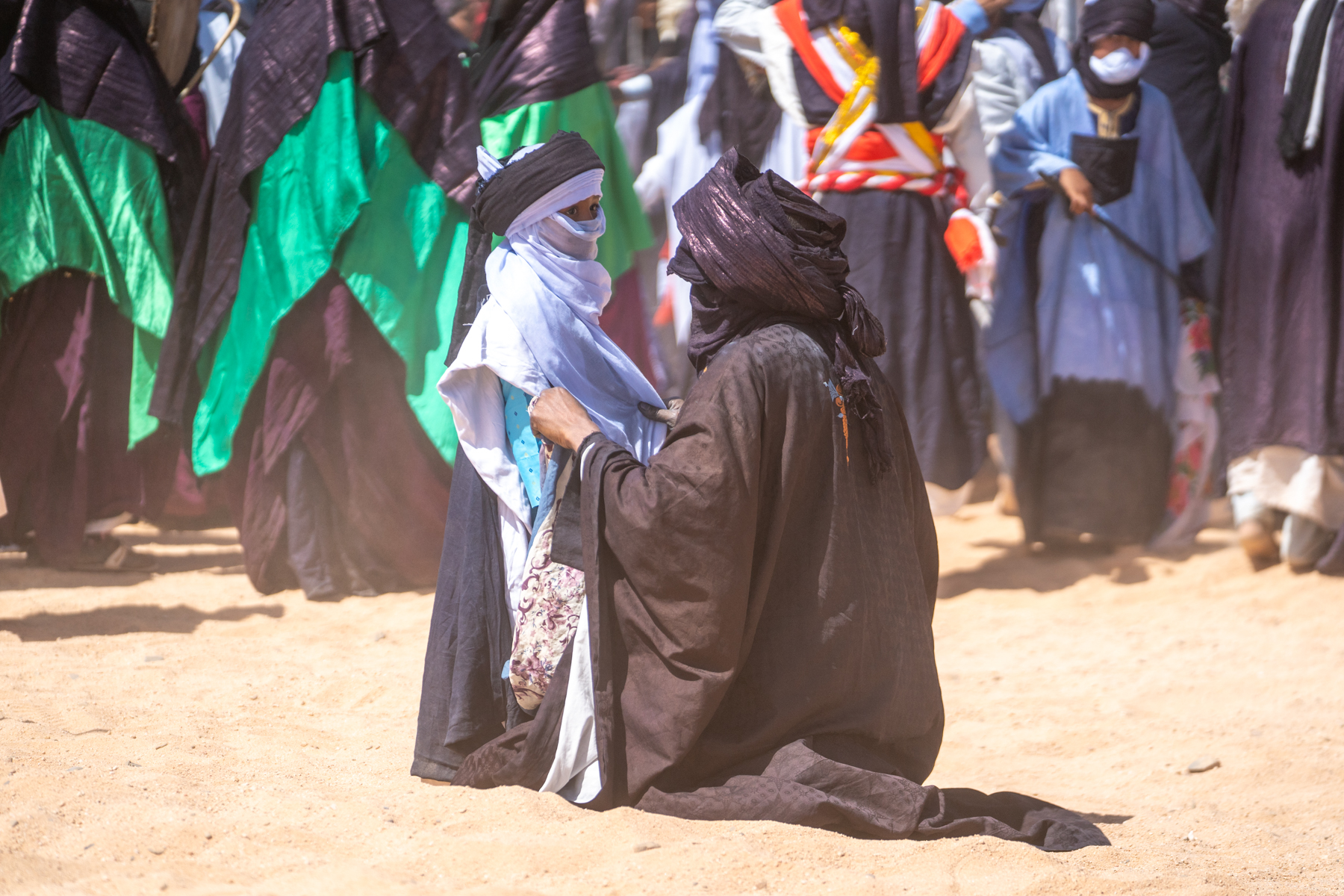
A Sabiba warrior preps his young son for the ceremony (image by Inger Vandyke)
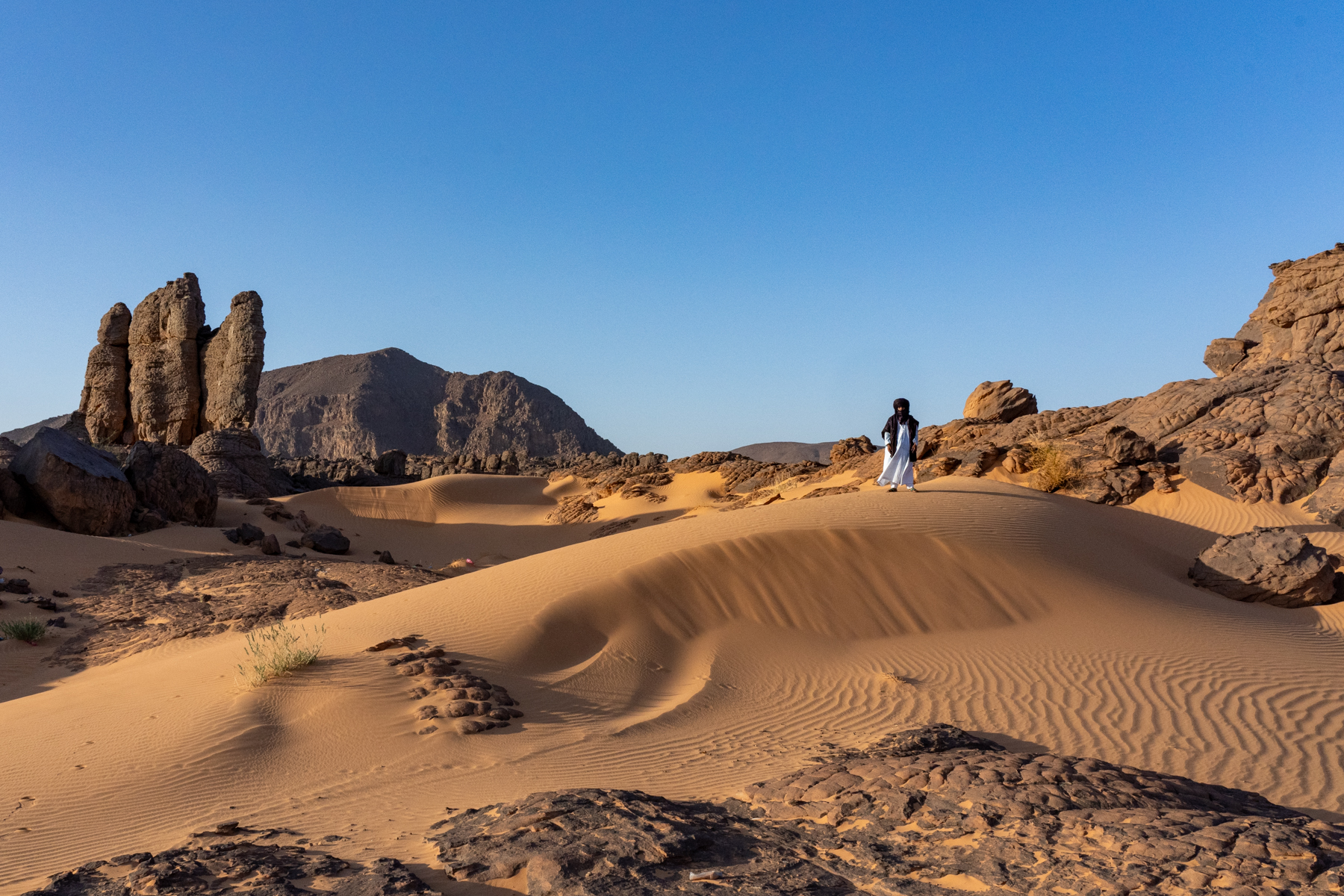
A Tuareg man dressed in a flowing Gandara and Tagelmoust for a private shoot in the desert near Djanet (image by Inger Vandyke)
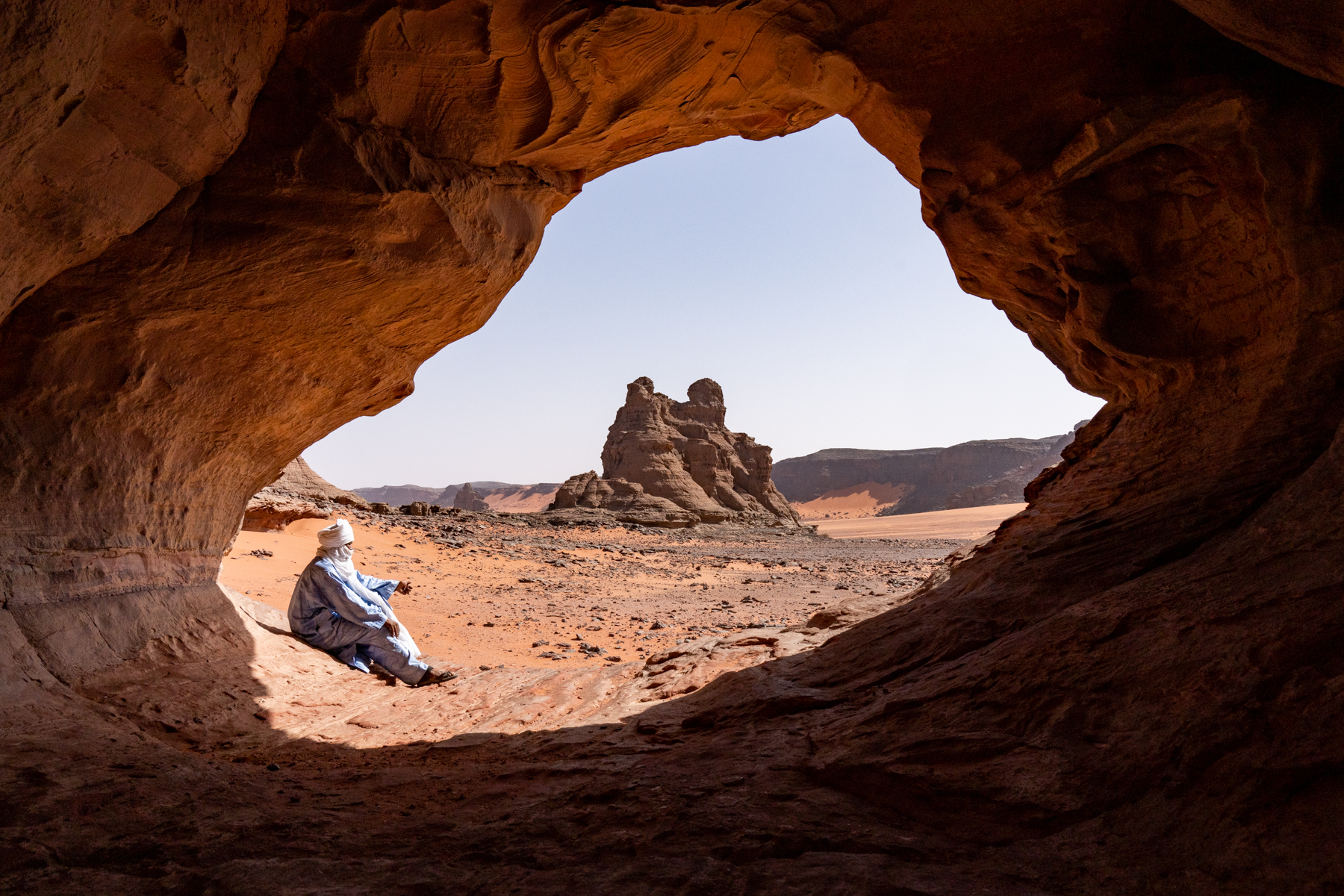
Our guide sits in one of the many rock arches we will visit on our tour (image by Inger Vandyke)
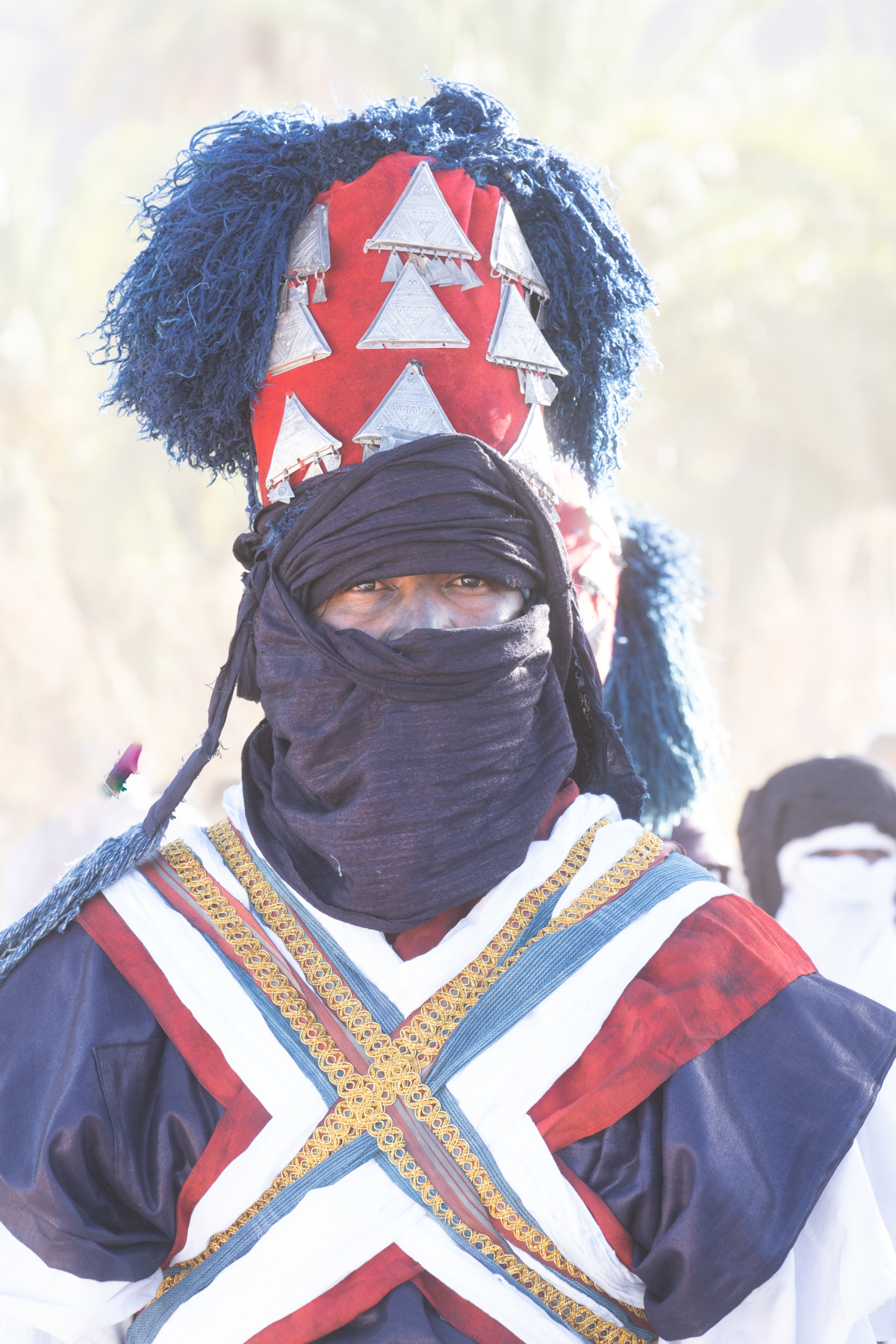
Portrait of a Sabiba warrior (image by Inger Vandyke)
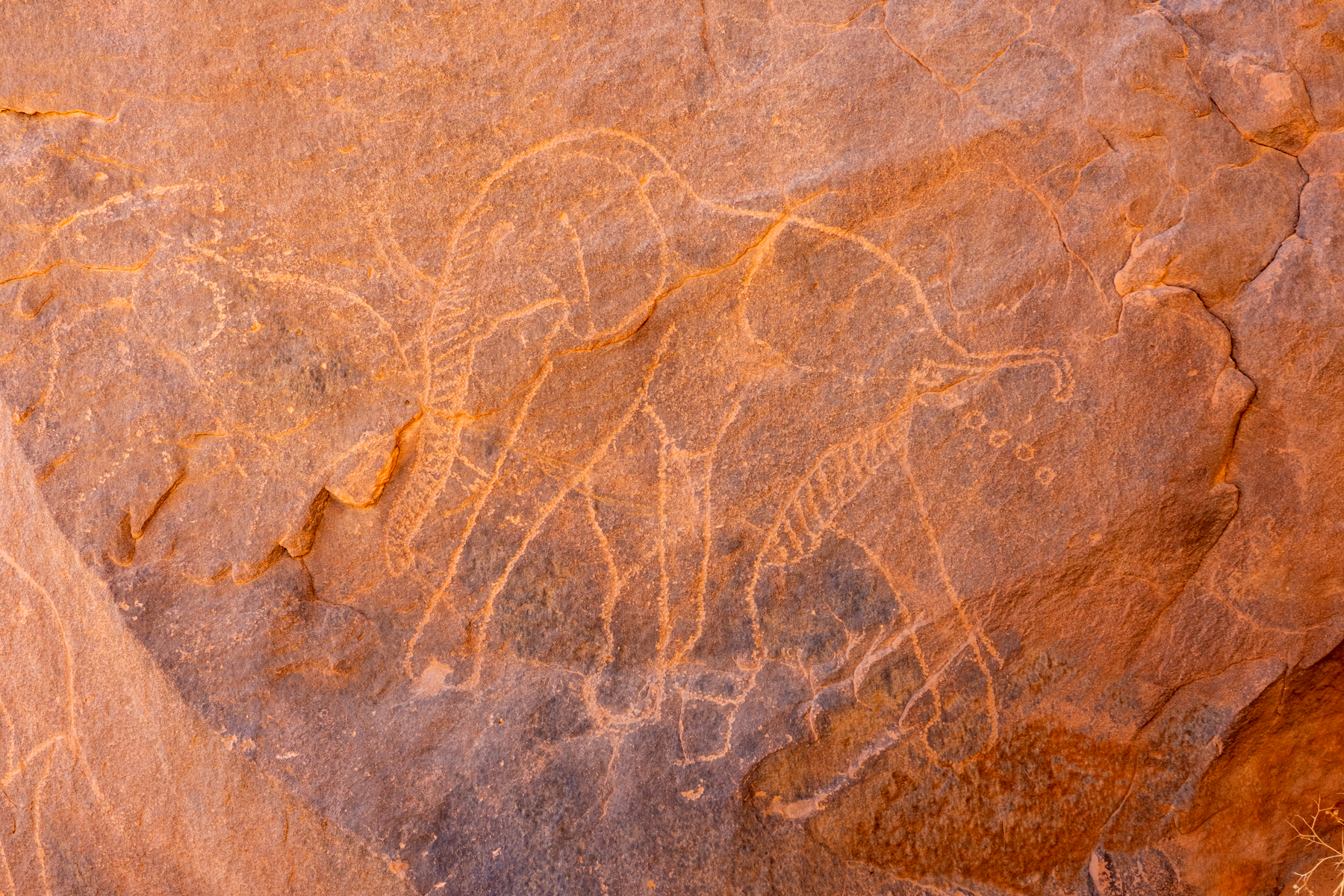
Engraving of an elephant pooping - it just goes to show that even ancient artists had a sense of humour (image by Inger Vandyke)

There is no place in the world as sensual as the Sahara. The Tuareg call it Ténéré. It beguiled me years ago and revisiting Algeria this year rekindled that love I have for the desert there (image by Inger Vandyke)

Portrait of a Kel Hoggar Tuareg man (image by Inger Vandyke)
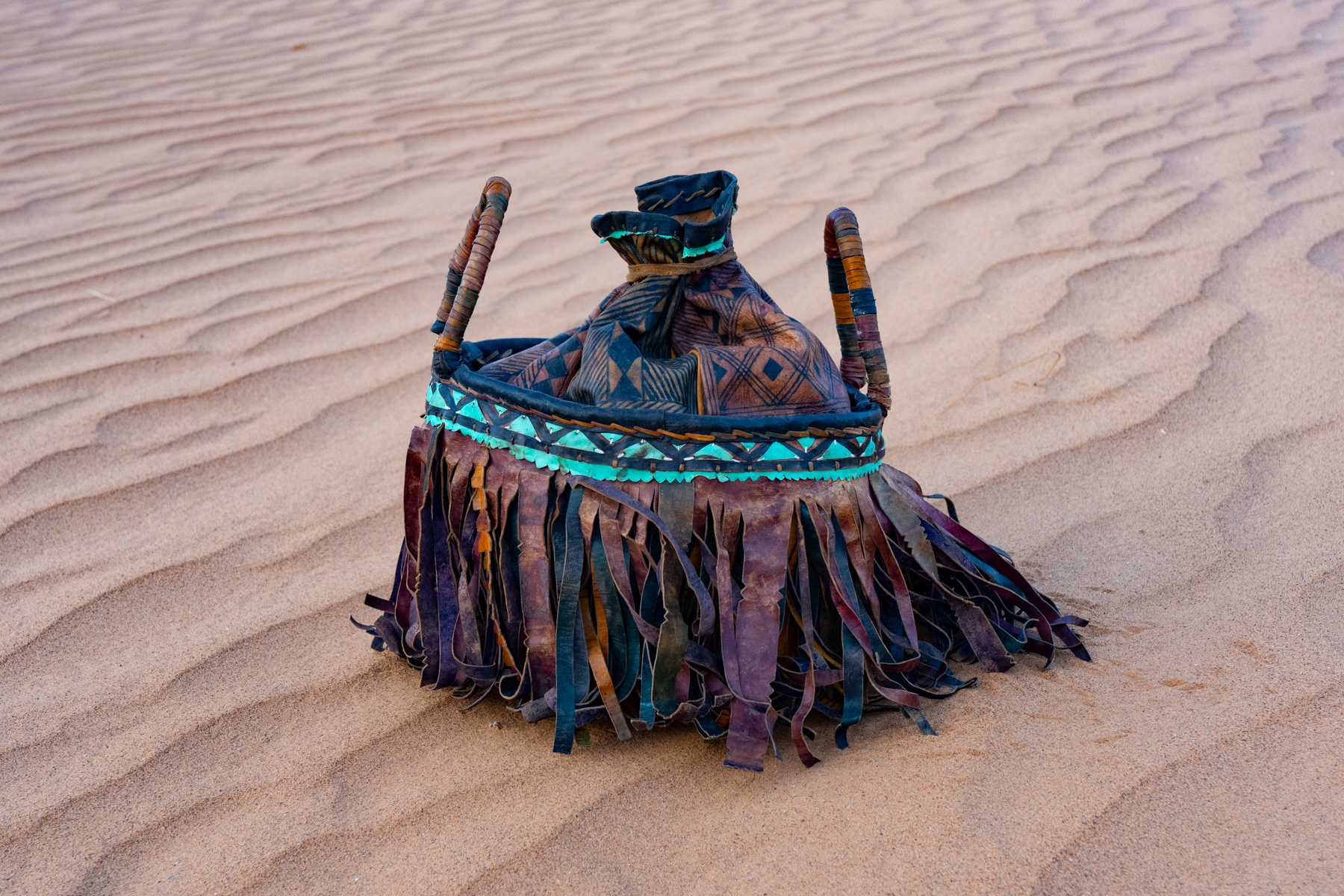
A traditional Tuareg leather tea making bag in the Sahara (image by Inger Vandyke)
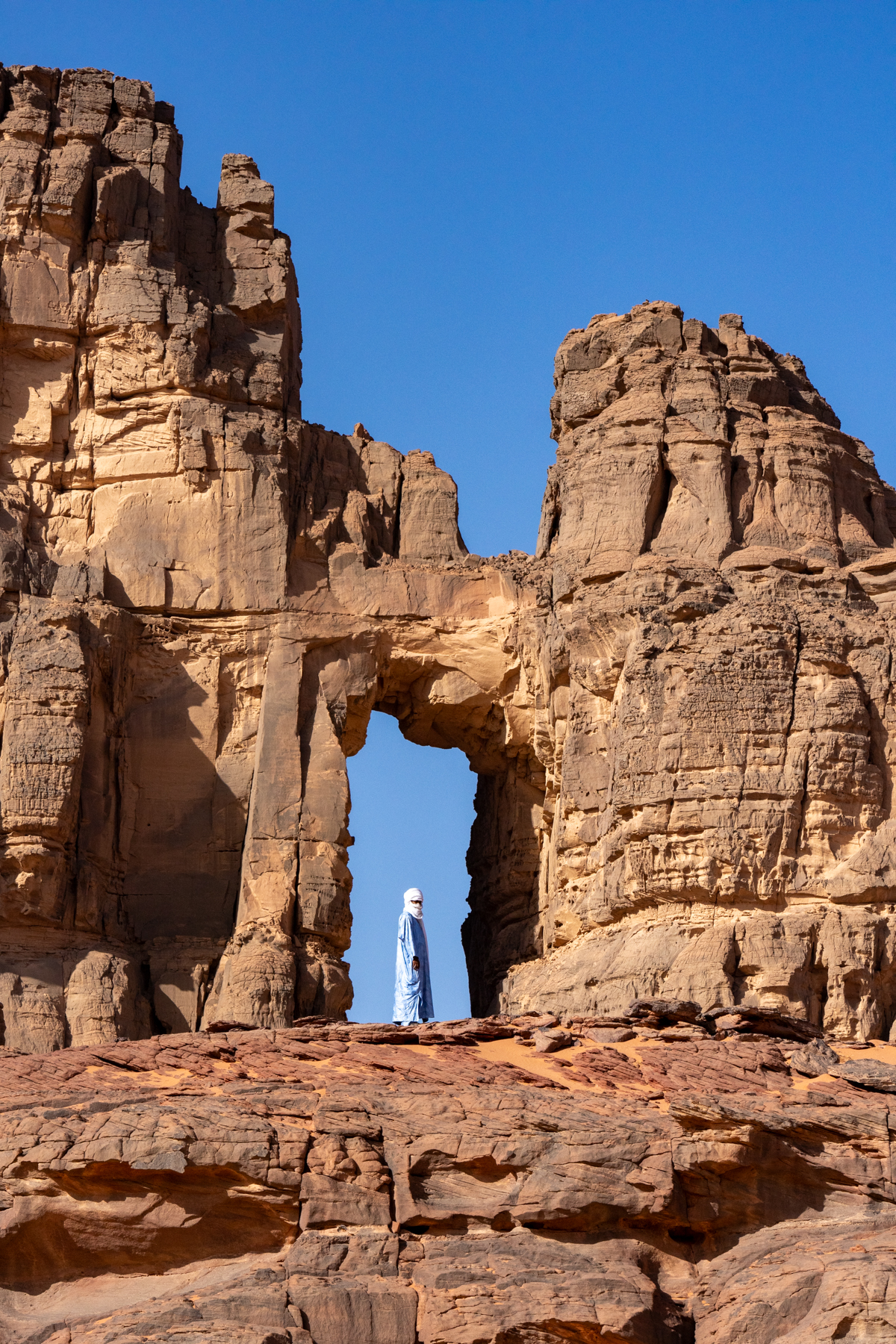
Our guide standing in the spectacular Timjadawin, the Cathedral of Tadrart Rouge (image by Inger Vandyke)

Sabiba ceremony where Tuareg warriors literally dance in the dust (image by Inger Vandyke)

Camel in profile (image by Inger Vandyke)
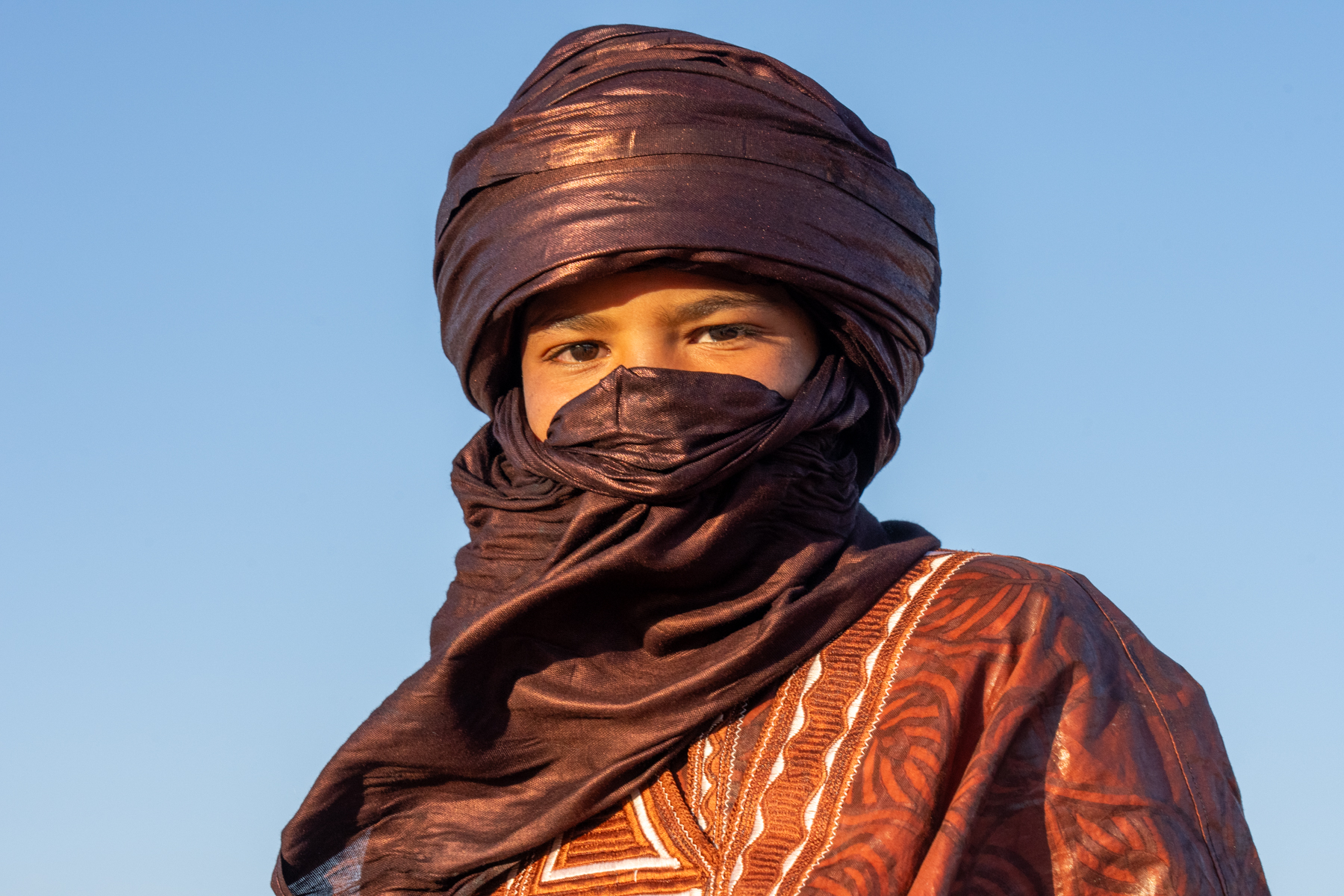
Young Tuareg boy waiting to watch the camel dancing in the desert (image by Inger Vandyke)

Portrait of a Kel Azjer Tuareg groom (image by Inger Vandyke)

Portrait of a Sabiba warrior in black and white (image by Inger Vandyke)

A young Tuareg boy at a wedding. This is one of my most favourite images from my entire professional career (image by Inger Vandyke)

Fragments of ceramics at a rock art site (image by Inger Vandyke)

One of the countless beautiful landscapes of Erg Admer (image by Inger Vandyke)
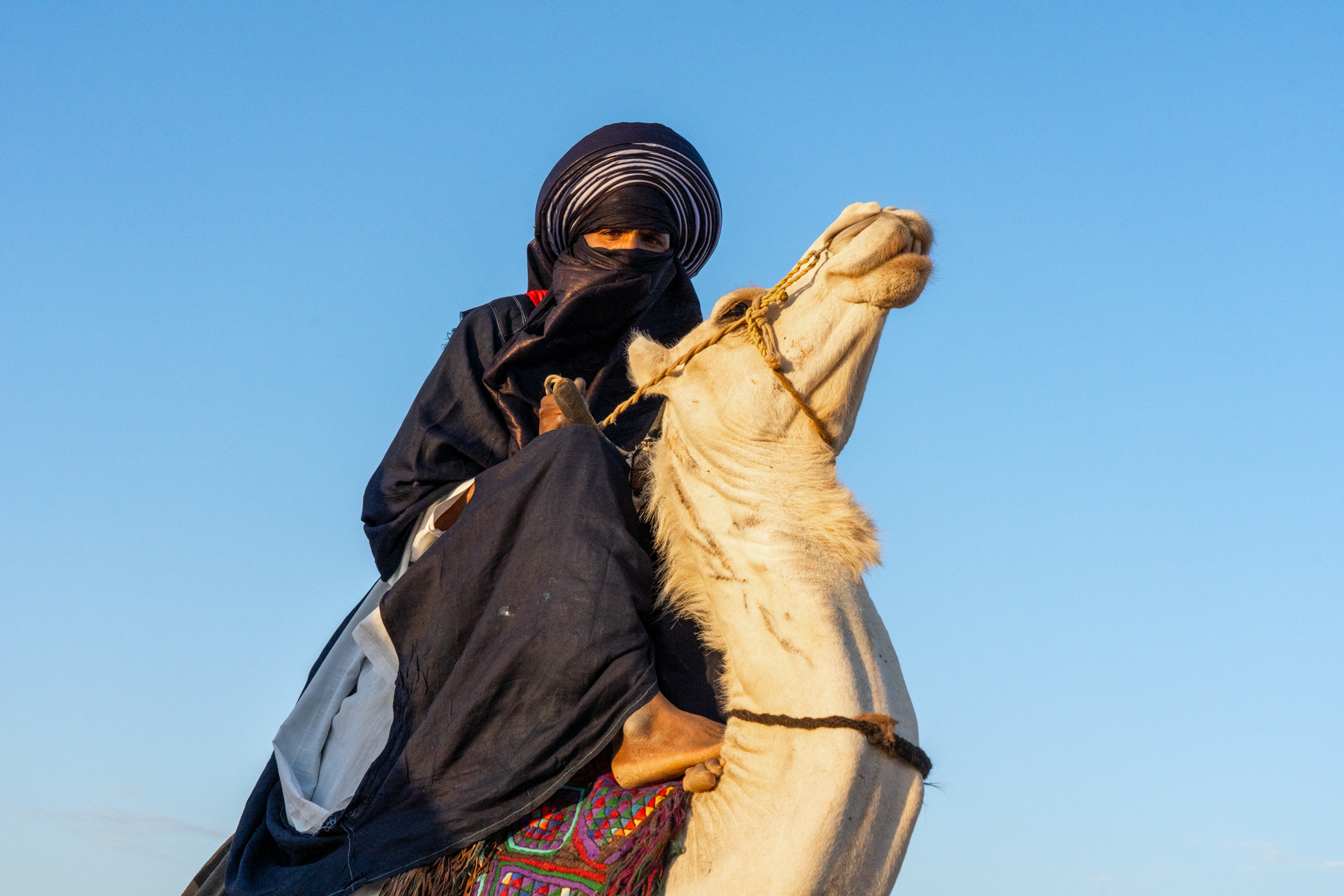
Portrait of a Tuareg camel dancer (image by Inger Vandyke)
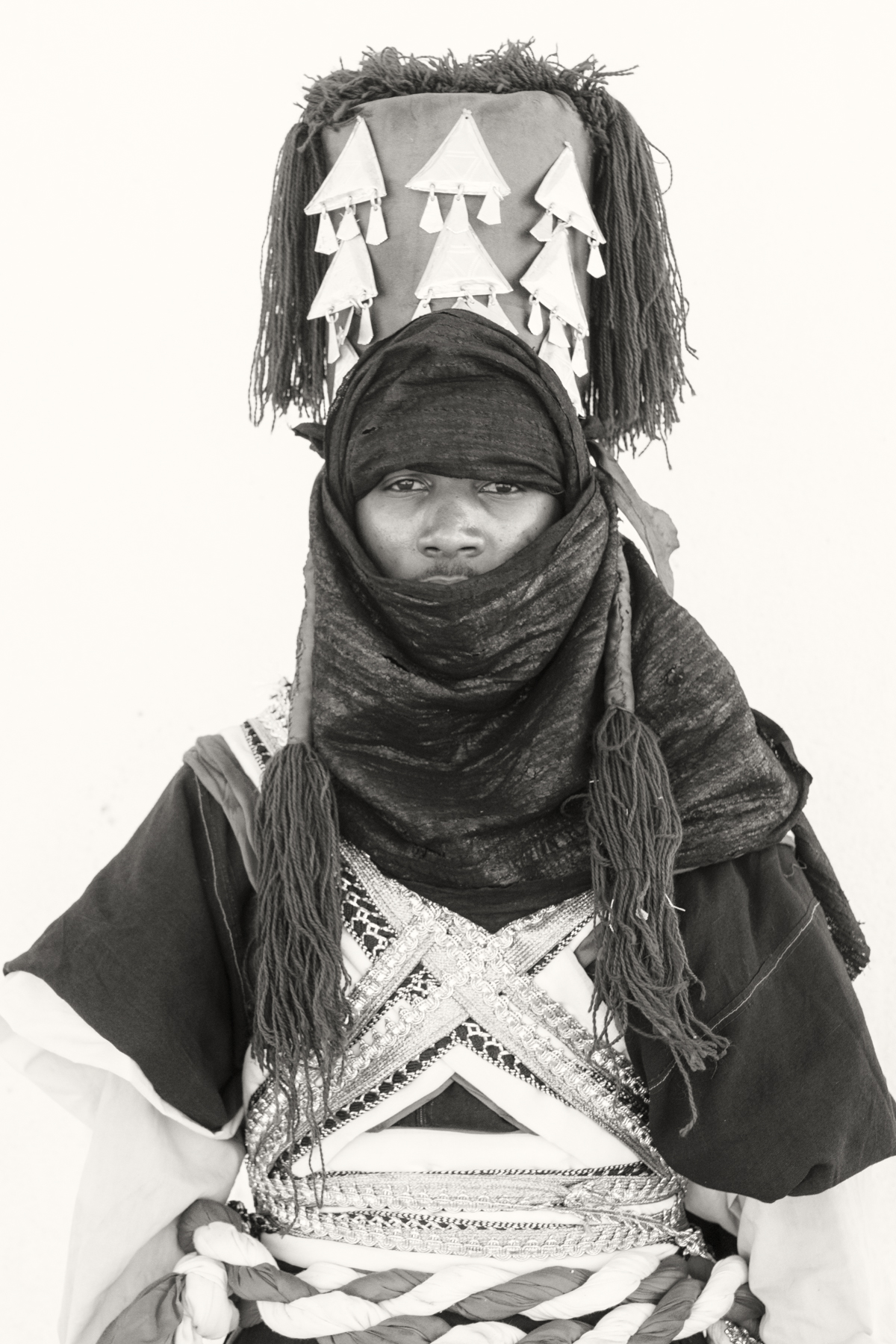
Sabiba warrior in monochrome (image by Inger Vandyke)
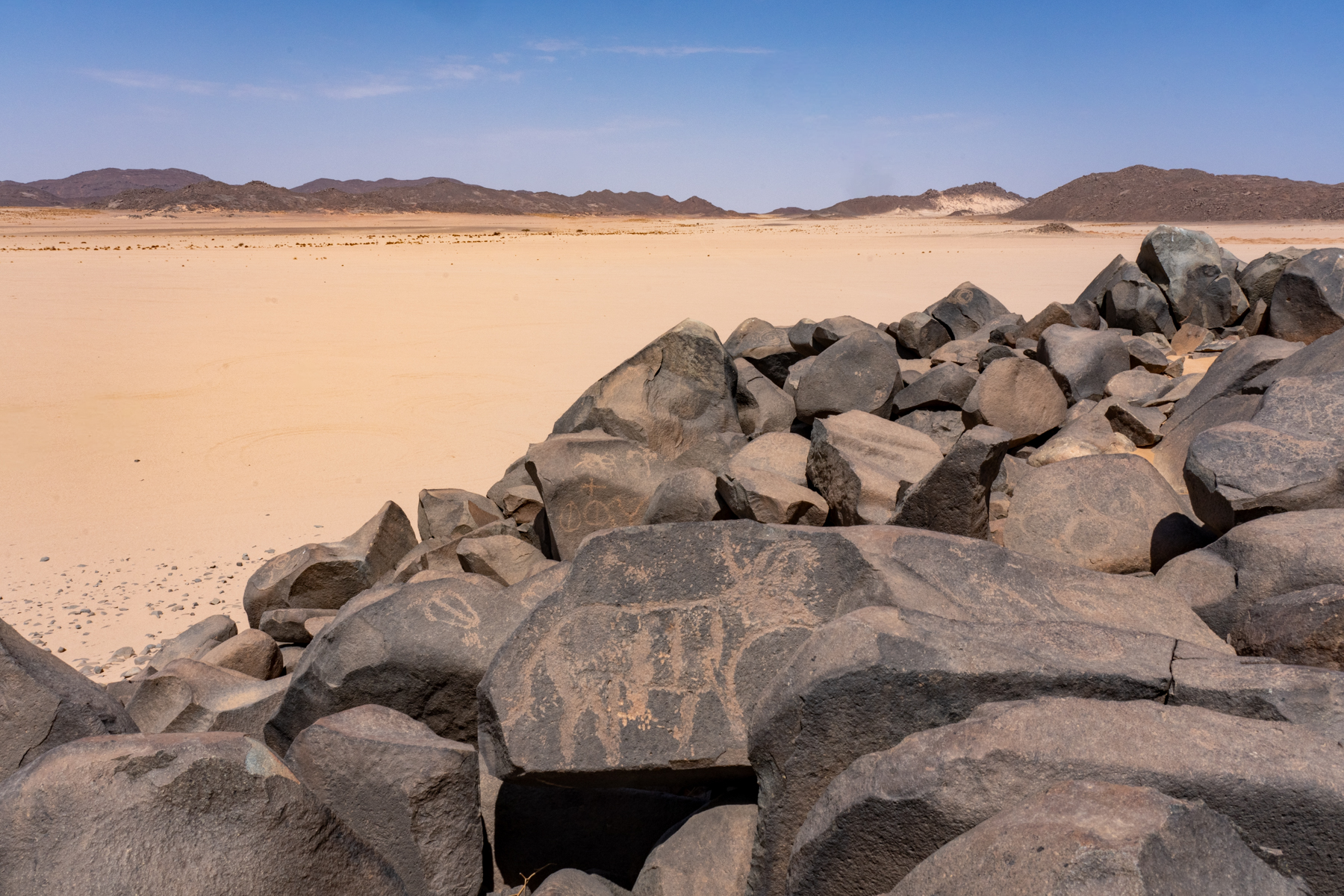
Stopping at the hillock art site of Tabogayt en-route to Tadrart Rouge (image by Inger Vandyke)

Tuareg men preparing for a wedding (image by Inger Vandyke)

Tuareg women musicians playing in the background of Timoulawine, the rehearsal for Sabiba (image by Inger Vandyke)
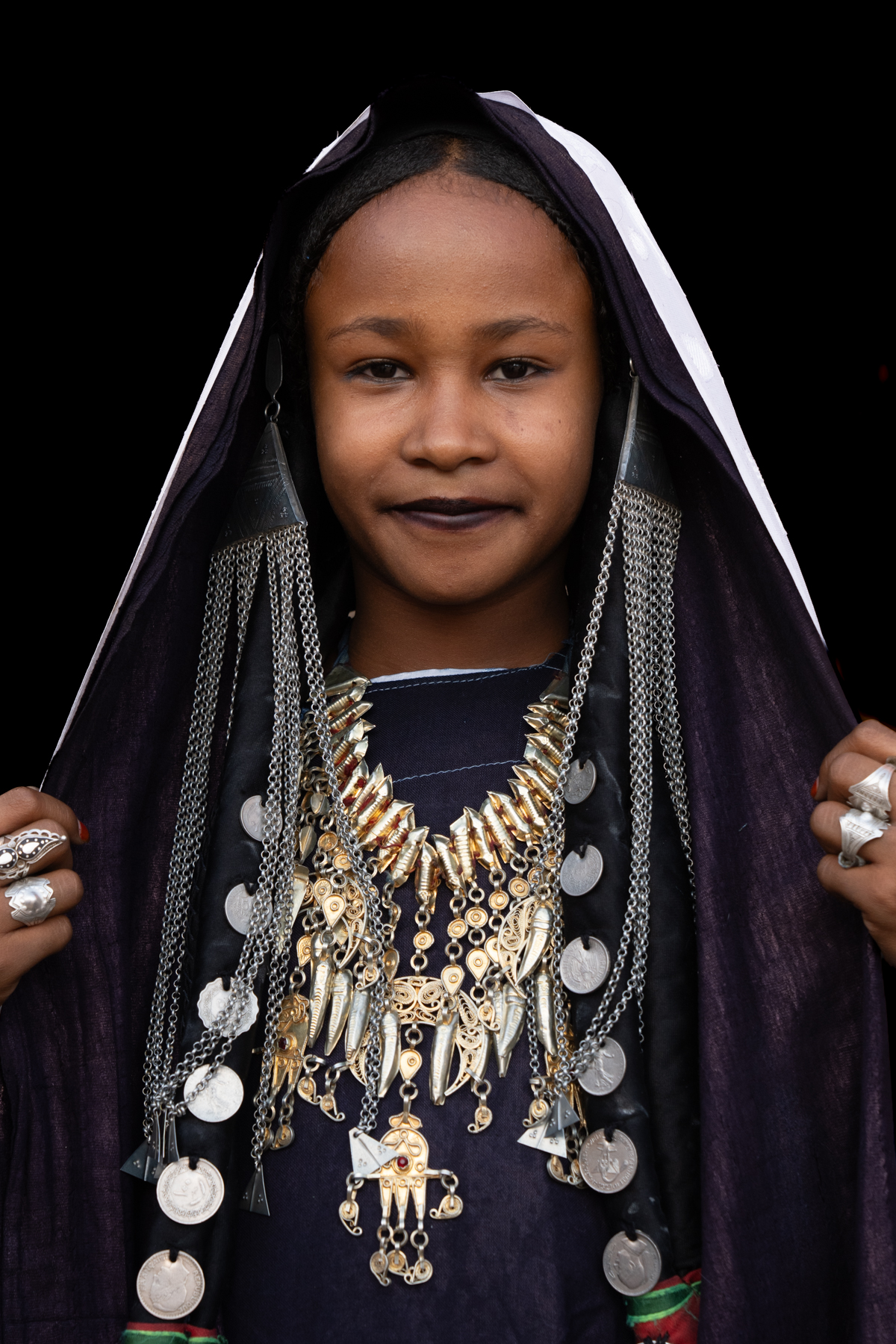
A pretty young girl adorned in silver jewellery for the Tuareg celebration of Sabiba (image by Inger Vandyke)
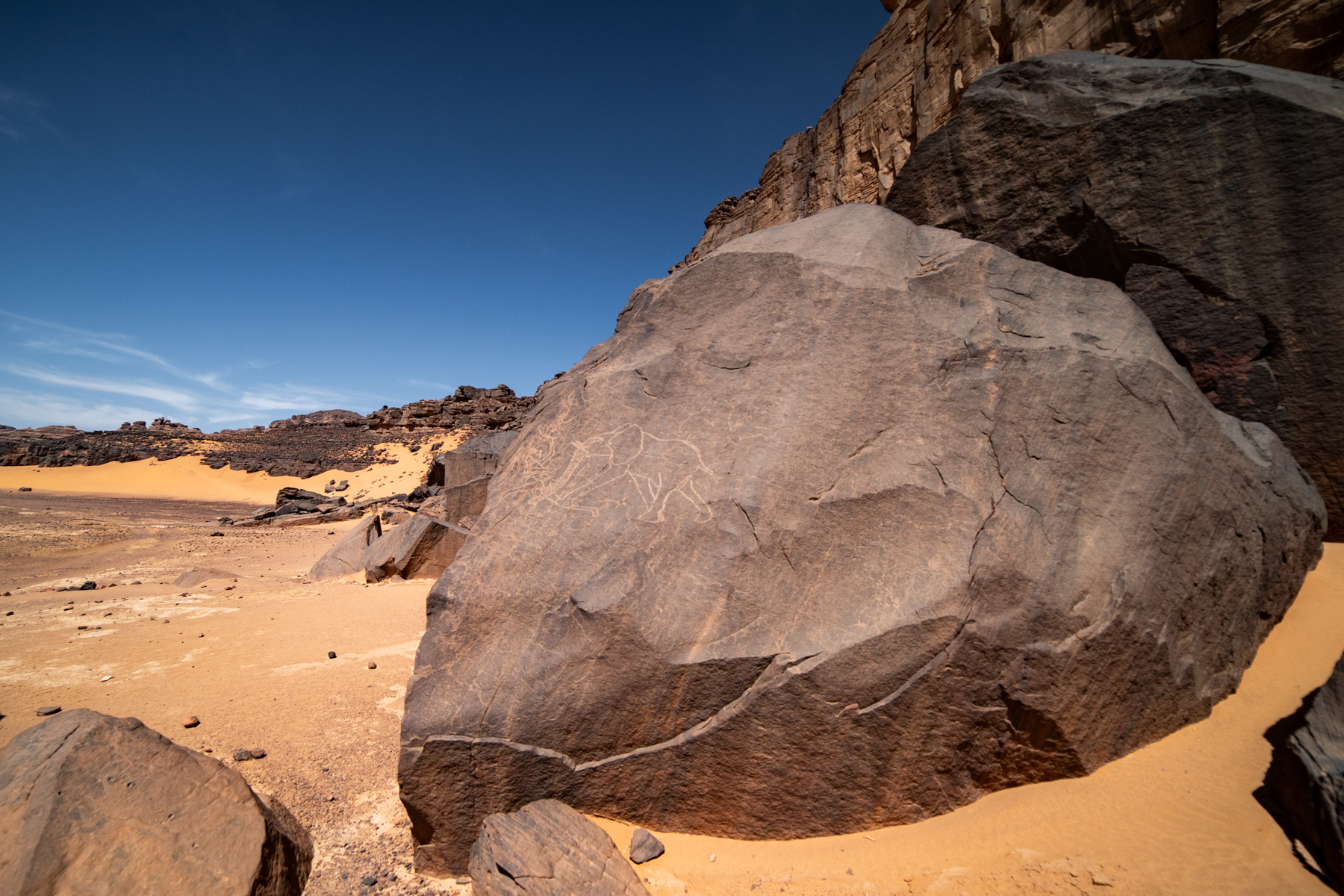
An engraving of an elephant in Tadrart is a reminder these incredible animals used to call the Sahara home (image by Inger Vandyke)
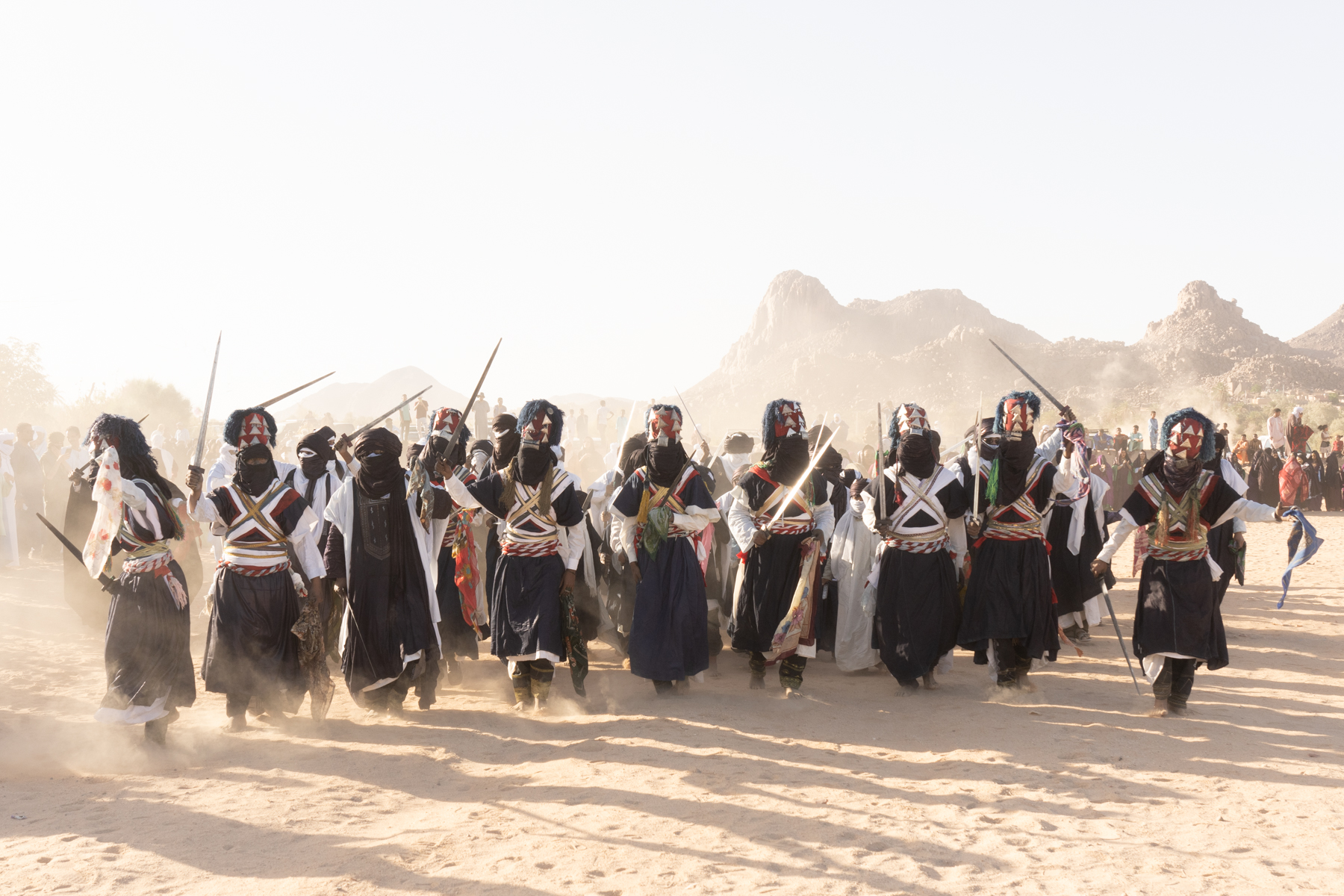
Dancing in the dust. Warriors celebrating Sabiba, a UNESCO world heritage listed event for its importance to Tuareg and Algerian culture A Sabiba warrior talks to his son to prepare him for the friendly battle of the Sabiba ceremony (image by Inger Vandyke)
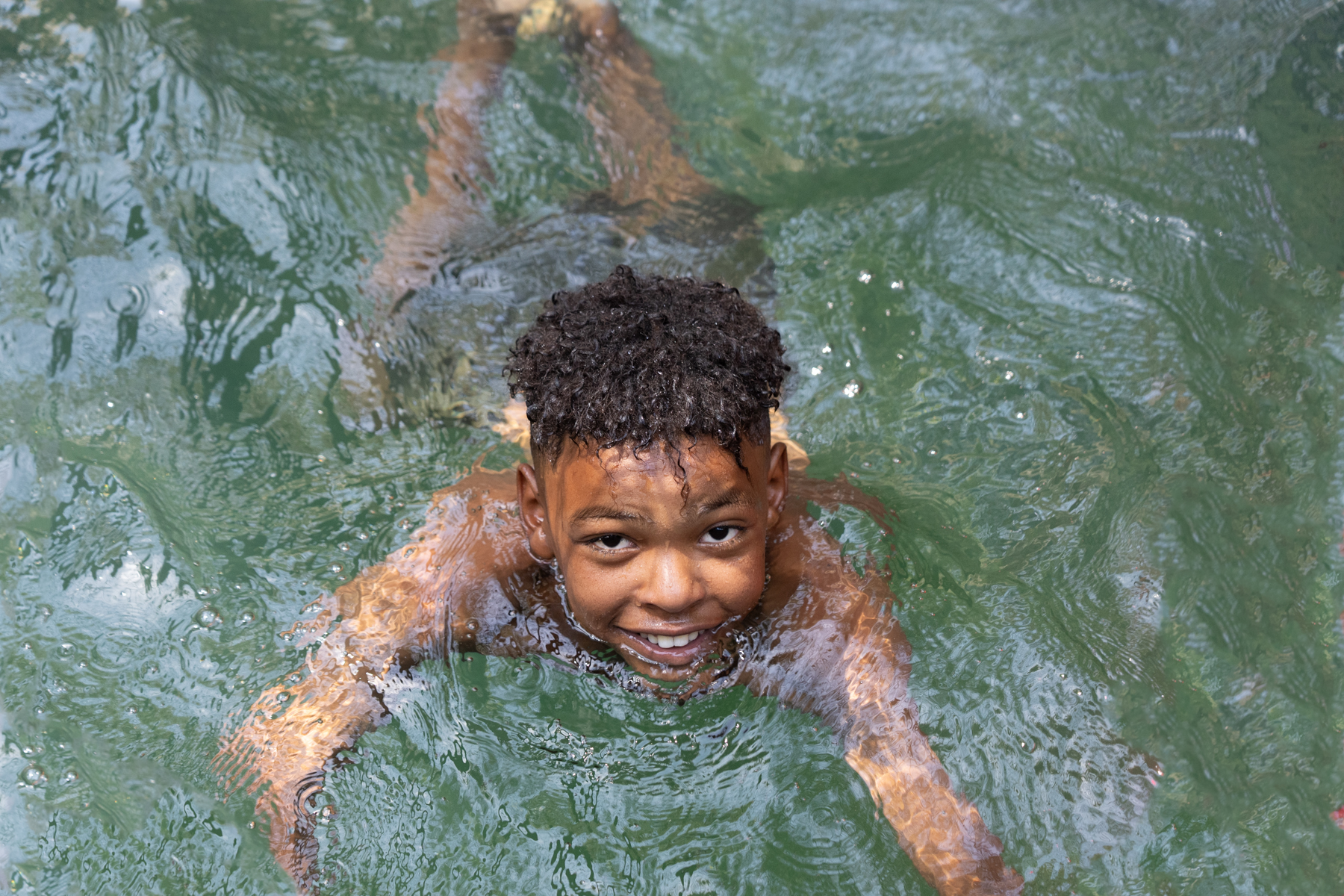
Local boy swimming in the well at the Ksour of Adjahil near Djanet (image by Inger Vandyke)
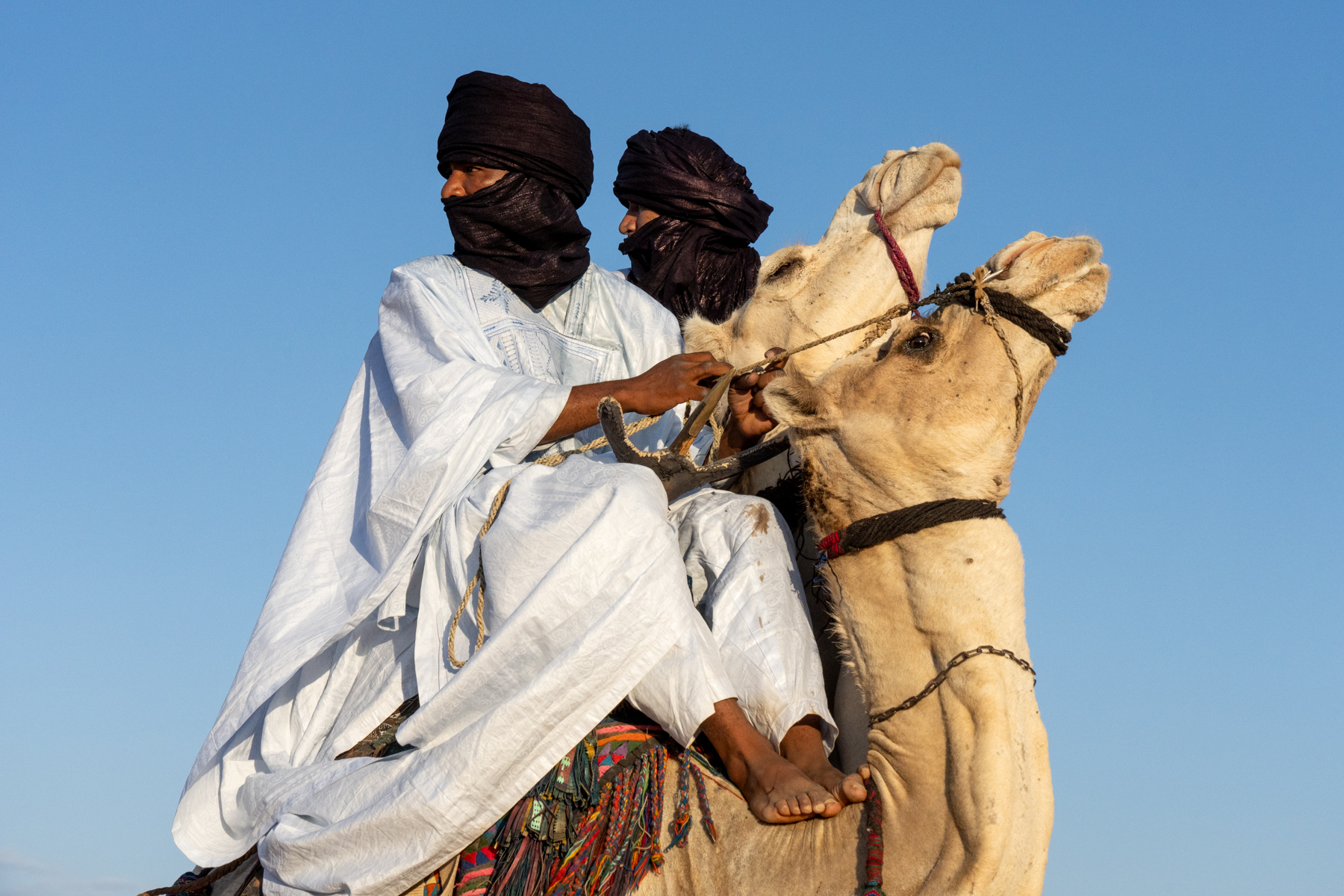
Tuareg men use their bare feet to steer their camels (image by Inger Vandyke)
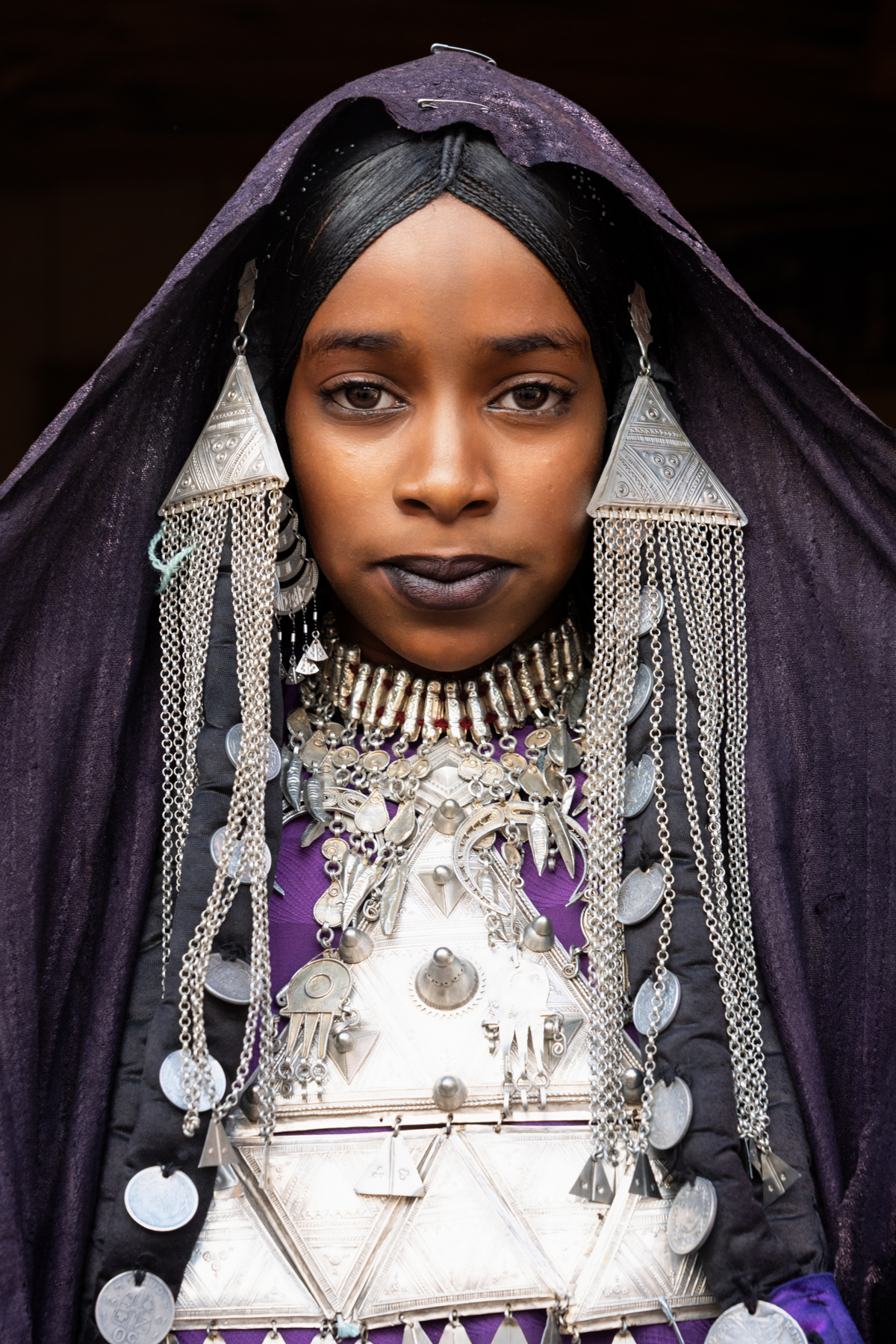
Portrait of a Tuareg girl heavily adorned in traditional silver jewellery (image by Inger Vandyke)

Exploring an engraving site in the astonishing desert of Tadrart Rouge (image by Inger Vandyke)

A double rock arch in Tadrart Rouge (image by Inger Vandyke)
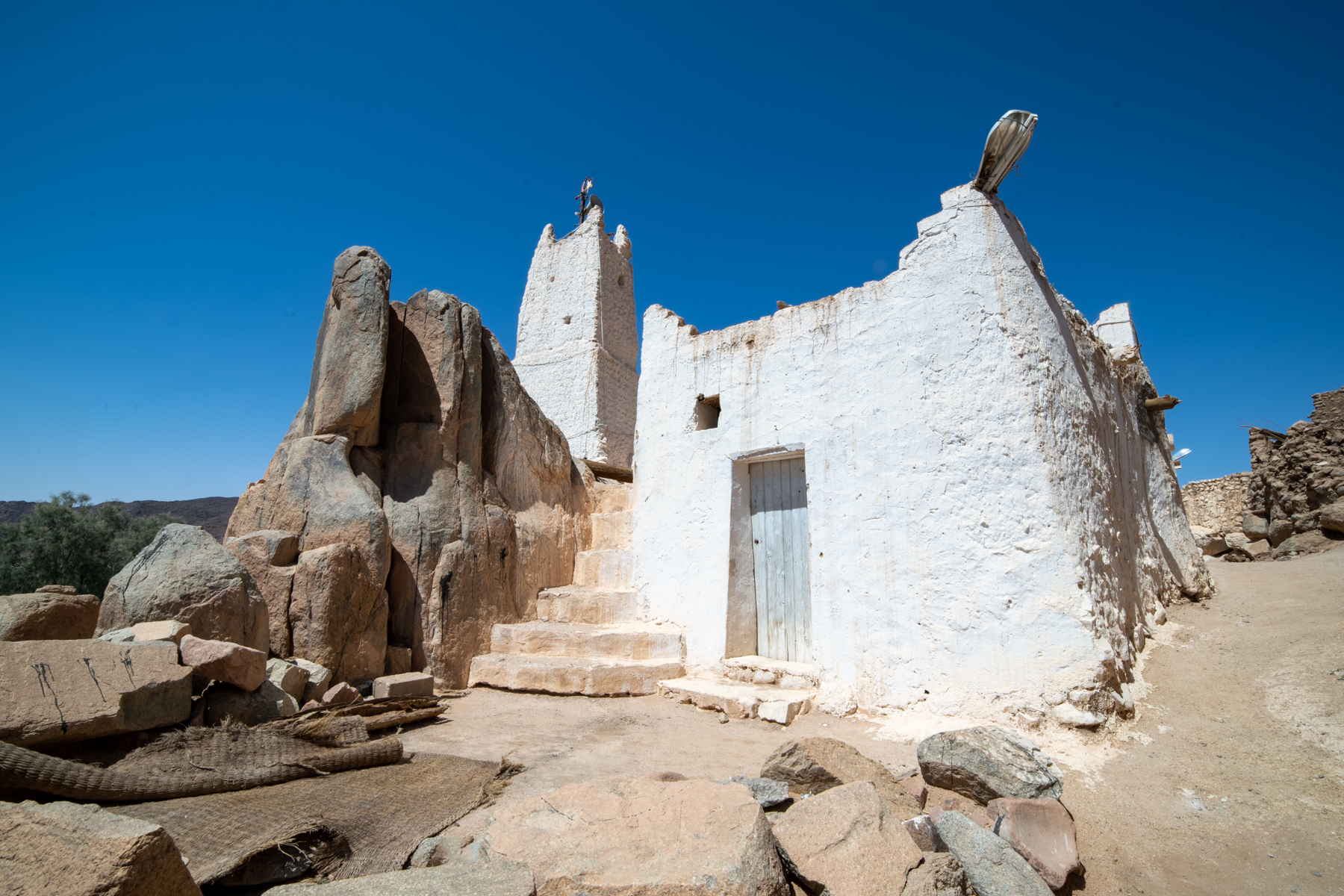
The small mud mosque inside the ancient Ksour of Zalouaz is one of Djanet's hidden architectural gems (image by Inger Vandyke)

Tuareg camel decoration (image by Inger Vandyke)
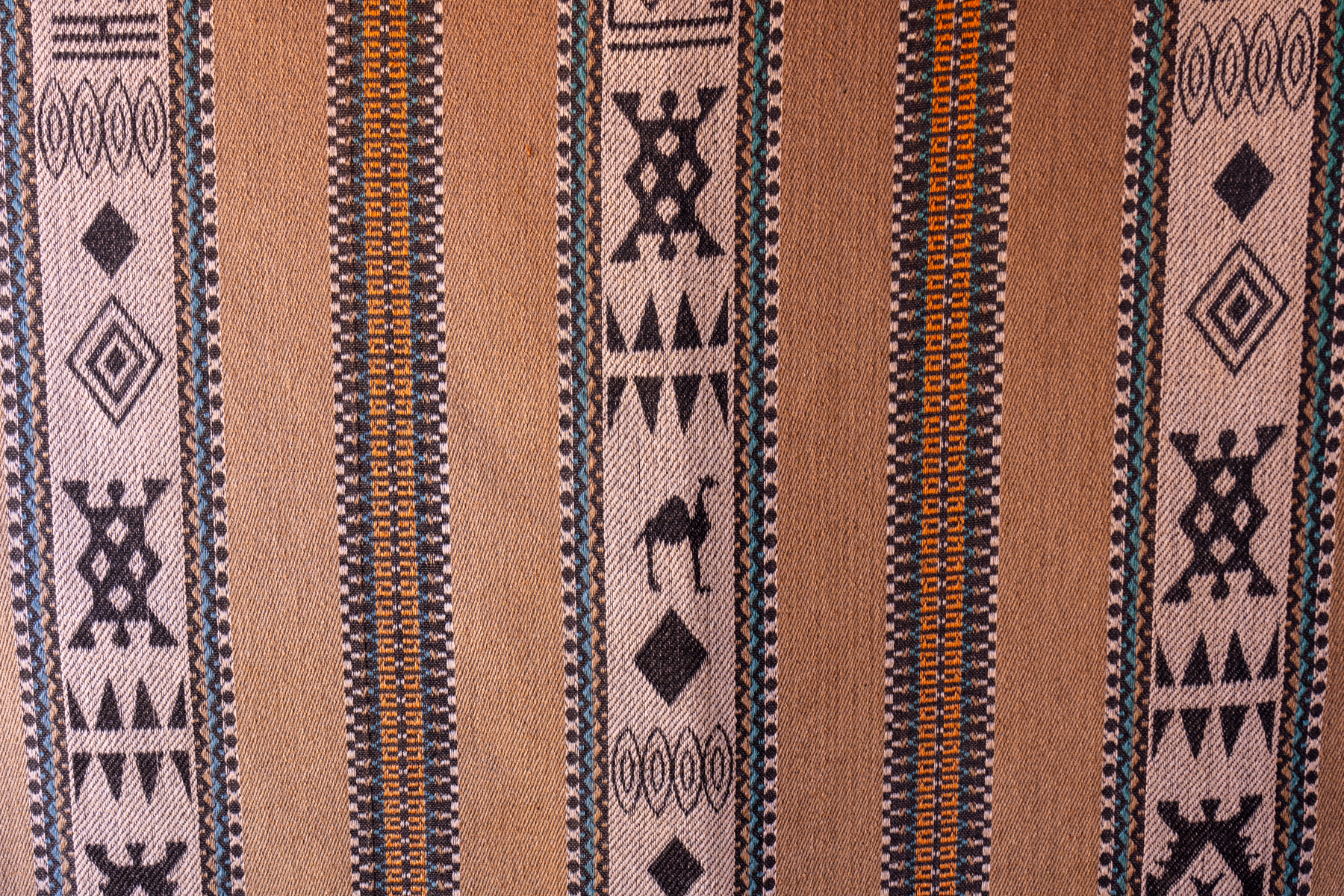
Tuareg people are famous for their silver, leather, mat weaving and textile craftmanship, much of which is sought after by collectors around the world (image by Inger Vandyke)

One of the hundreds of rock pillars in Tadrart Rouge (image by Inger Vandyke)
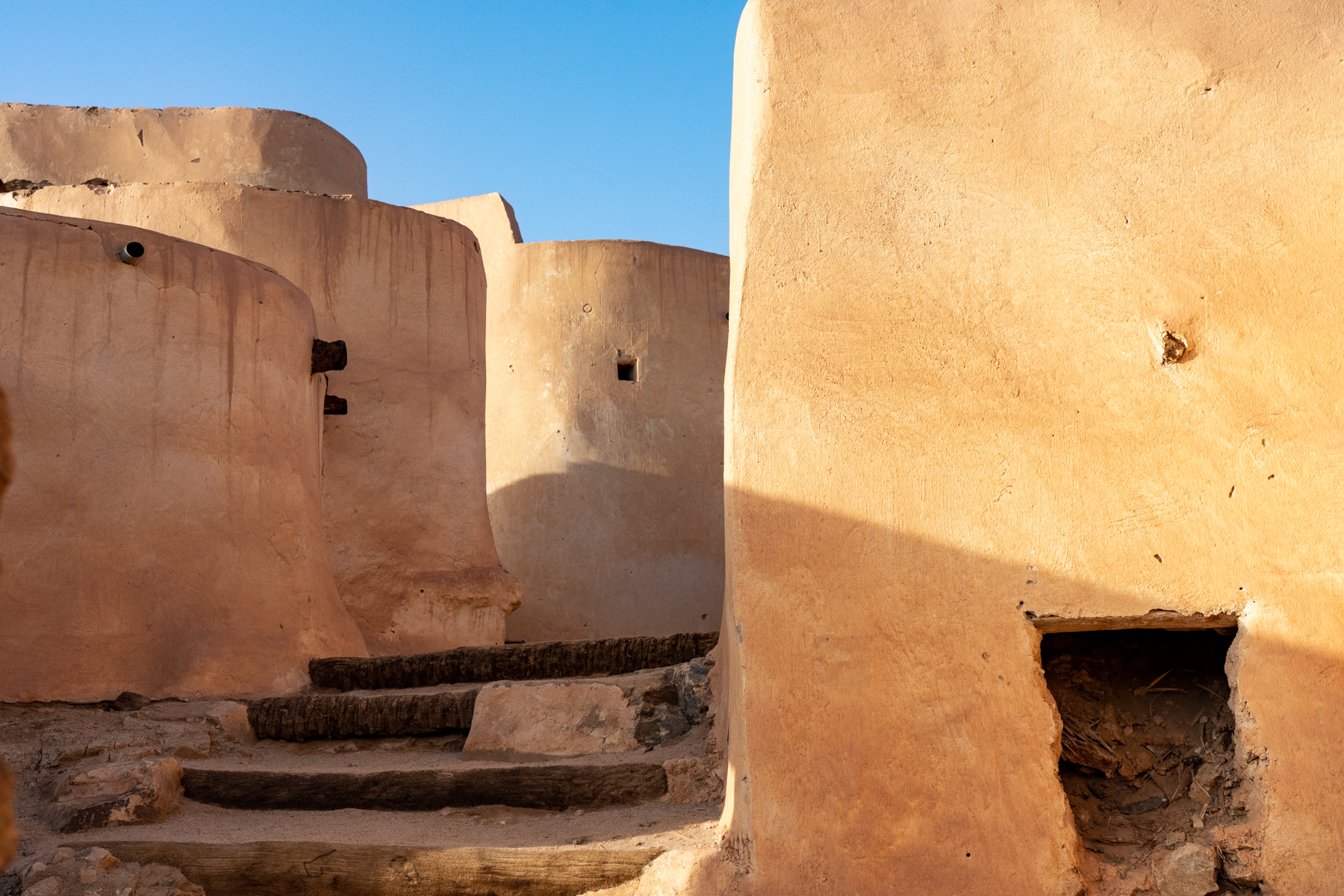
Inside the beautiful preserved Ksour of Taghorfit (image by Inger Vandyke)

Our guide explaining the history and story behind the Crying Bulls (image by Inger Vandyke)
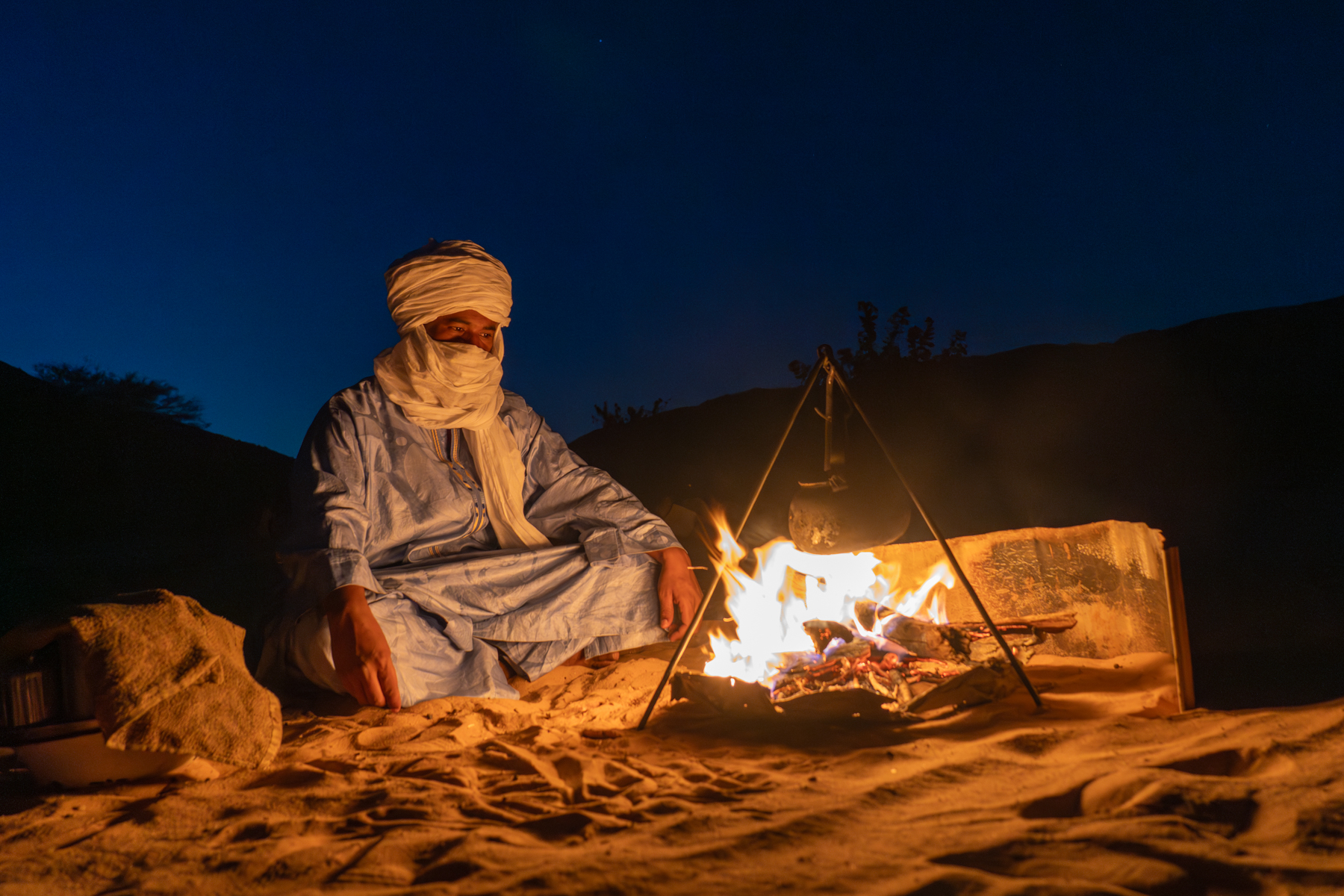
Tea in the Sahara (image by Inger Vandyke)
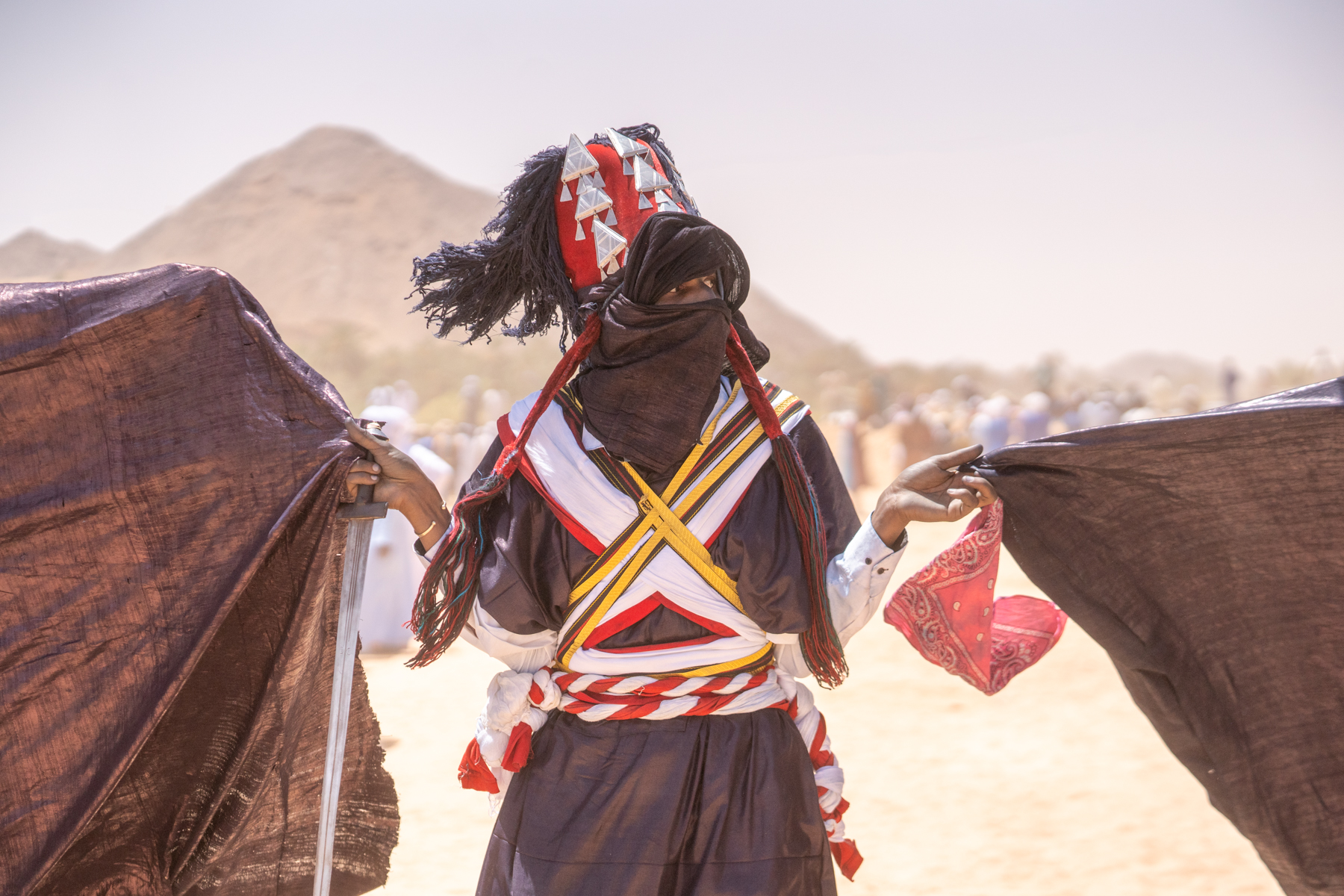
A Sabiba warrior holds swathes of indigo-dyed fabric as part of the ceremony in Djanet (image by Inger Vandyke)
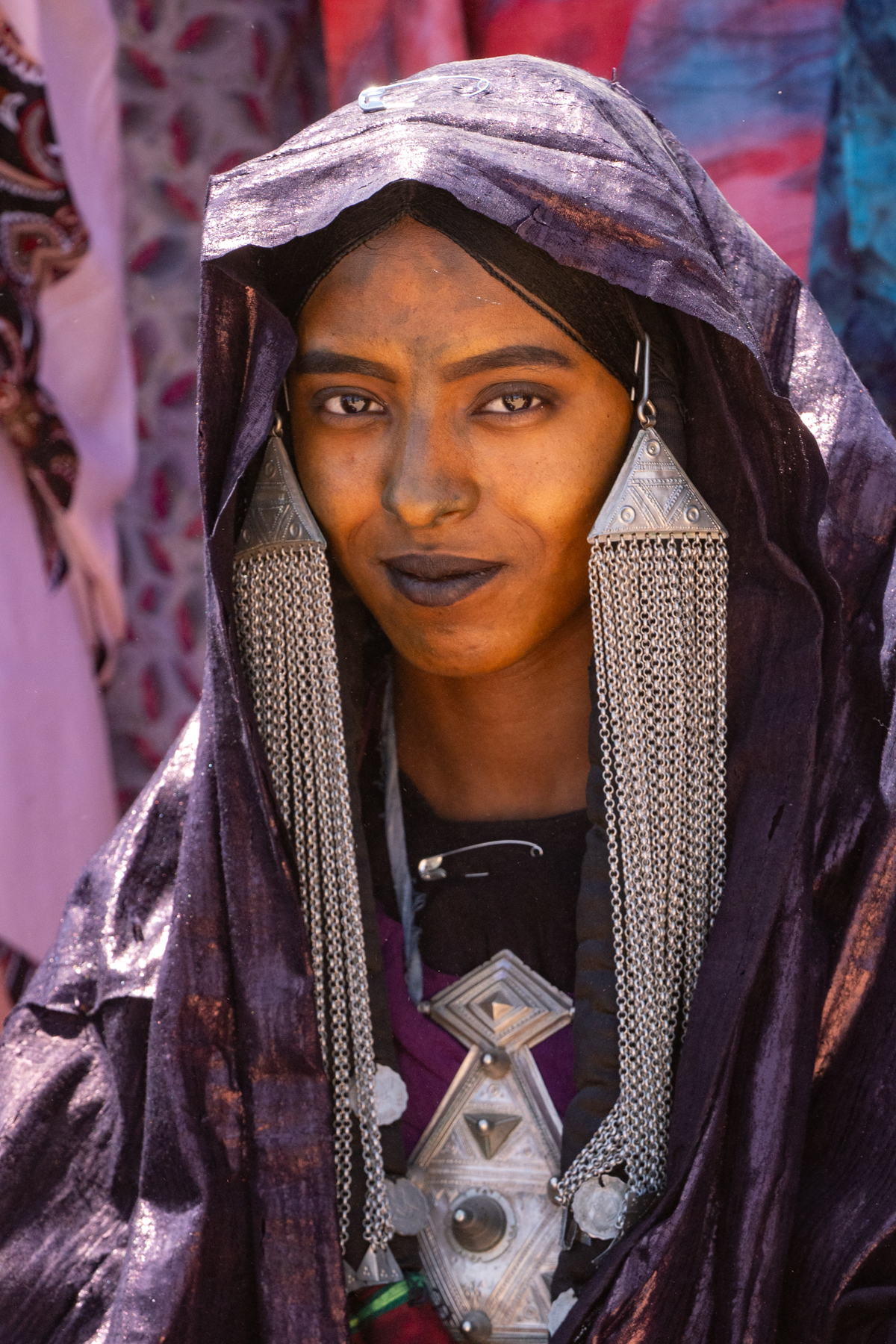
A beautiful woman dressed in indigo and silver for the annual Tuareg celebration of Sabiba (image by Inger Vandyke)
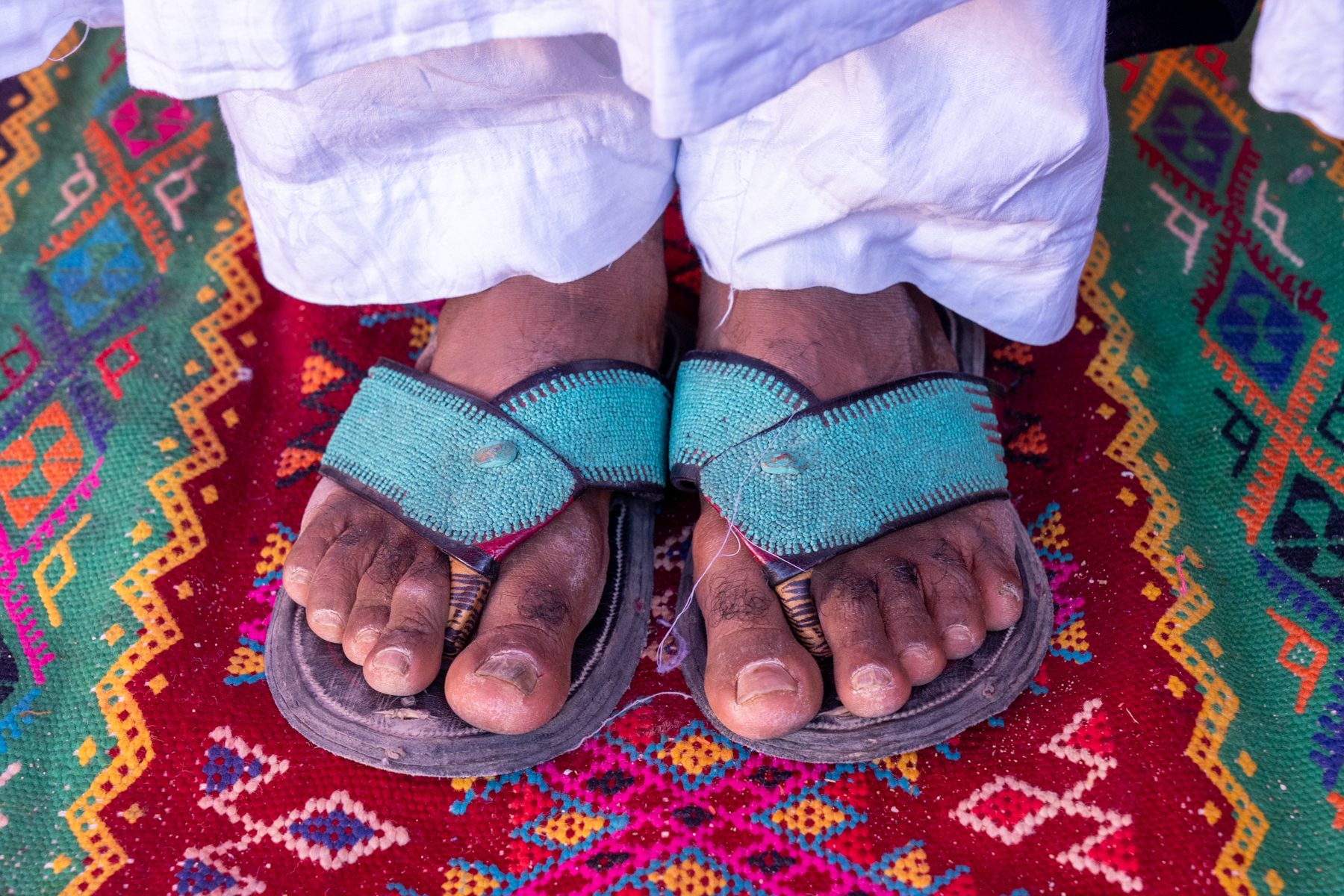
The beautiful turquoise beaded Tanba shoes worn by Tuareg men in celebrations (image by Inger Vandyke)

Exploring a gigantic slot canyon in Tadrart (image by Inger Vandyke)

Exploring one of the many rock art sites in Tadrart (image by Inger Vandyke)
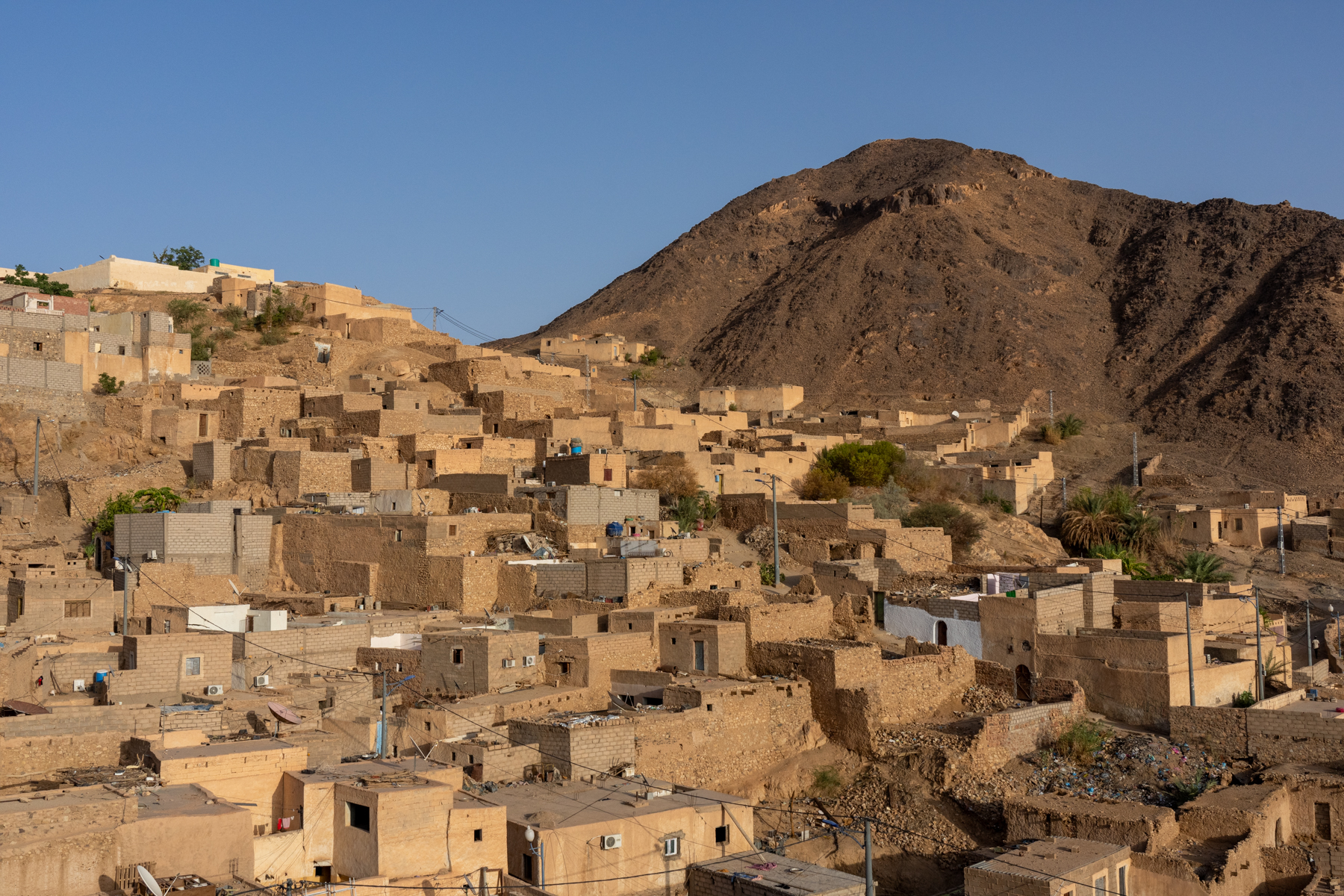
The newer buildings of Taghorfit are constructed over a neighbouring hillside to the Ksour of the same name (image by Inger Vandyke)

Tuareg Grooms and page boy. They are holding swords to frighten off any evil spirits or jinns (image by Inger Vandyke)
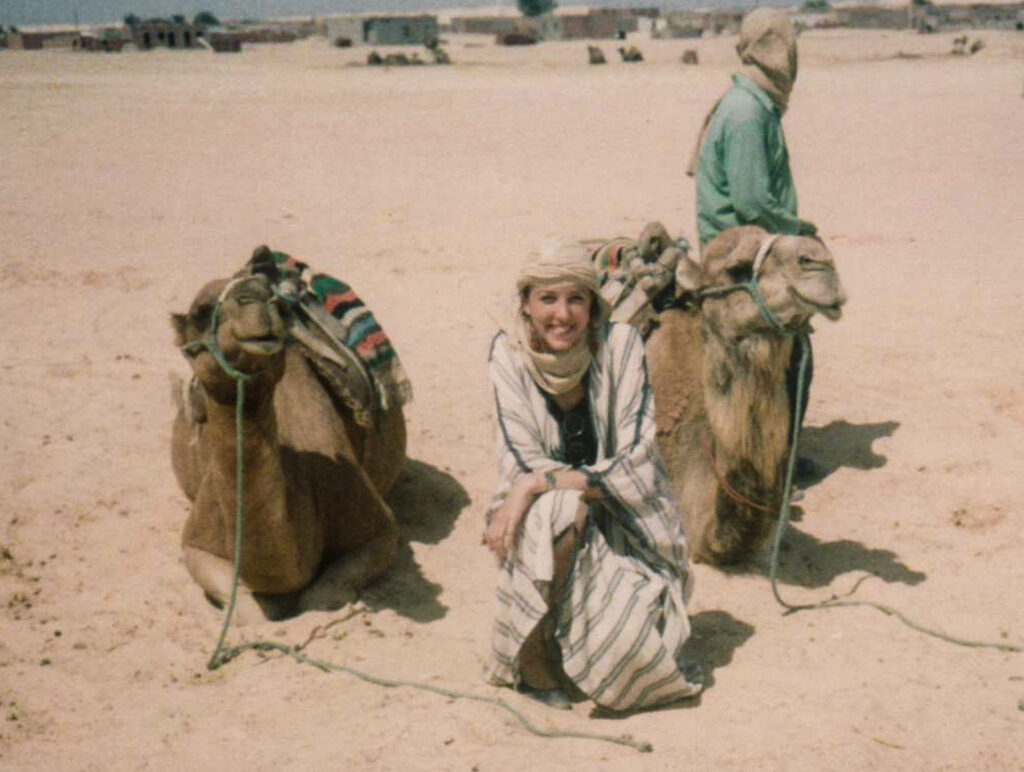
Me riding camels outside of Tamanrasset in 1990 (image by Inger Vandyke)
Algeria. It was the first African country I ever visited and the one that was responsible for birthing my love affair of the entire continent.
It was 1990. I was 19 years old and I decided to visit Algeria for a fairly inane reason. After a few months of living in one of the coldest places you can imagine, northern Norway, I wanted to see one of the hottest, so I chose the Sahara Desert of Algeria. I had always wanted to see the rock art there so in that year I found myself arriving in the desert town of Tamanrasset, my backpack filled with everything I needed to survive and a sturdy pair of hiking boots on my feet. Off I went to explore the spectacular Hoggar region with only a map, compass, optimism and a sense of curiosity.
Back then I was around three days walk into the mountains when a noise woke me up one night. I cautiously opened my tent door to find a bunch of people wondering why I was alone and camped in the desert. It was a family group of Tuareg people who, after finding I was on my own out there, decided to put down camp near to me. Through broken English I worked out that they were worried to see me out in the desert. This meeting with them turned out to last almost five weeks as they accompanied me around the desert, worried that the region was too difficult to navigate for a person who didn’t have any prior knowledge of the area.
And so began my love of Tuareg people. I never forgot the kindness they showed me. I was travelling in Algeria at the cusp of a civil war. Although the war itself didn’t really kick off until 1992, even when I was there, the whole of Algeria was edgy and filled with tension. Eventually I was encouraged to leave because several Algerian people advised that it wasn’t safe for me to be walking or travelling there on my own. I fled north and crossed the border into Tunisia, wondering if I’d ever get to see Algeria again or meet up with my Tuareg friends.
Back then there was no internet. My only way of finding out what was going on in the country was through a trusted short-wave radio where I could pick up the BBC World Service occasionally. That, and an instinct developed from years of growing up in the wild, guided me through a lot of remote places back then. The obvious lack of communication and the fact that my newfound Tuareg friends lived an ‘address-less’ existence as nomads in the Sahara, meant I lost touch with them after a while. I have thought about them often since, hoping they had not been caught up in the war, but it was impossible to find out any news of them at all back then.
Fast forward to 2021 and, after around 14 years of effectively being cut off from the outside world, with tourism closed in the Algerian Sahara due to the threat of Islamic violence, I watched carefully as the entire region cautiously opened its doors and began to welcome tourists once more. A beefed up military presence on the border between Algeria and Libya signalled to me that I might finally be able to return to this place that was once so special to me. I began planning a trip back to the Tassili art sites with the hope of visiting Sabiba, the UNESCO World Heritage listed celebration of Tuareg warriors in the southern Algerian town of Djanet. Plans were hatched, flights then booked and myself and one of my wonderful intrepid guests arrived in Algeria in July 2023.
Algiers
To me there has always been something quite classy about Algeria. The whole country has escaped the glitzy tourism scene of its neighbours Morocco and Tunisia and therein lies its appeal. I arrived in Algiers a little shocked to find a much bigger city than I remembered but it still had all the charisma. It’s the sort of place you can imagine Yves Saint Laurent (who was born in Oran and is perhaps one of the most famous Pieds Noire to have ever lived), sitting in a street side café in a crisp white linen shirt smoking a filtered cigarette and drinking coffee while sketching his next collection. It has a kind of classy grunge chic that probably sparked my own love of Francophone Africa all those years ago.
We stayed at a hotel right next to the pretty Hamma Garden in the city. Sadly, due to various flight issues, we didn’t get out to do a lot of sightseeing. Rather we simply enjoyed a wonderful meal of Algerian food with a lovely Algerian friend of mine who came to the city to meet us.
Djanet
The next morning, we boarded our flight to the Sahara. Algeria is almost 90% covered by the Algerian Desert, a large part of the Sahara itself. After a brief transit stop in El Oued, close to the border of Algeria and Tunisia, our flight continued south. I watched, mesmerised as the fertile plains of the north transformed in to the vast yellow expanses of the desert below the plane. As we neared Djanet those expanses blushed into a warm terracotta with black islands of stone. Seeing the desert transform was a breathtaking introduction to our trip.
We travelled in the Algerian Sahara during the time of Sabiba, the start of the Islamic new year and a time of great celebration for Tuareg people, when many weddings take place.
When we disembarked the plane we saw our first Tuareg groom whose appearance made us stand in awe. He was dressed in a white tagelmoust (the multi-layered cloth worn by Tuareg men), adorned with leather and silver ornaments of his Kel Hoggar clan. He had arrived in Djanet to celebrate his wedding and he was stunning! Statuesque and regal, we felt humbled by his presence.
Arriving in the terminal of Djanet’s tiny airport we were warmly greeted by our Tuareg translator and guide. Something washed over me and tears began to well in my eyes. “You’re emotional” he said. “Yes! I never imagined I would ever return to southern Algeria. I had always wanted to come back and I can’t believe I am here”. He smiled, and so began our odyssey of exploring a different part of Algeria for me, Djanet and the stunning regions of Erg Admer and Tadrart Rouge.
Djanet’s population consists almost entirely of Tuareg people. Their culture dominates almost everything you see and experience there. It’s a pretty little town lying in an oasis valley with a grove of date palms at its heart. There is very little tourism infrastructure in Djanet and the little that exists is quite rustic. The whole town is dry. You cannot buy even a beer there as the local people are mostly muslims who also worry about the effects that alcohol might have on their community.
Semi-Nomadic Tuareg
Through a combination of geopolitics and climate change, there are hardly any truly nomadic Tuareg people living in Algeria. These days many of their once regular water supply areas of the desert have dried up, forcing many people to either move to towns or to find a place with a well so they can live in access to water.
Our guide asked if we would like to spend our first night with a semi-nomadic family of Tuareg. One never has to ask me these questions. Of course we said “Yes!” and after kindly accepting his invitation he woke us from siesta with a snack of sweet local dates and milk before we jumped in the cars and headed into a pretty stretch of desert close to Djanet.
To entertain us, our driver and guide began playing the incredible music of Tinariwen in our car. We hadn’t even arrived in the true desert and already we were both enthralled.
This playground for the local Tuareg people whetted our appetite for the entire trip. Our first impression was the beautiful landscapes that local people regularly visit for picnics and family outings. We stopped in placed where Tuareg children had formed a slippery slide down a rock; another where there was a hole in the face of a boulder, and the belief exists that if you can curl up and fit your entire body into the whole you will find true love. Our last amusing stop was at a rock pillar which, if you threw a stone on to the top of it and the stone stayed up there, it would bring you good luck!
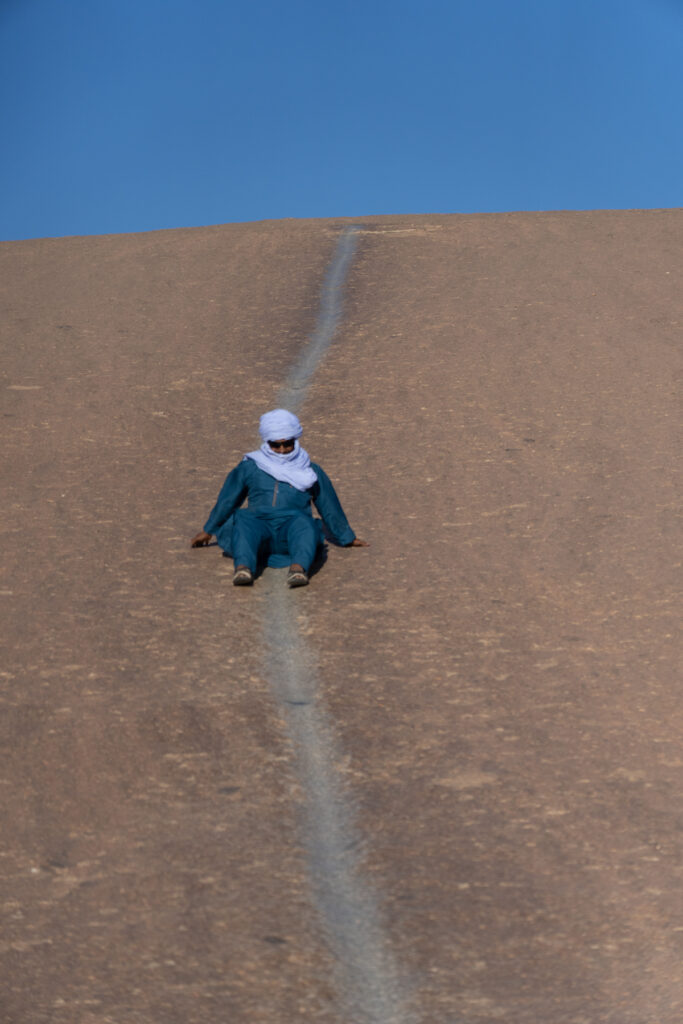
Desert slippery slide (image by Inger Vandyke)
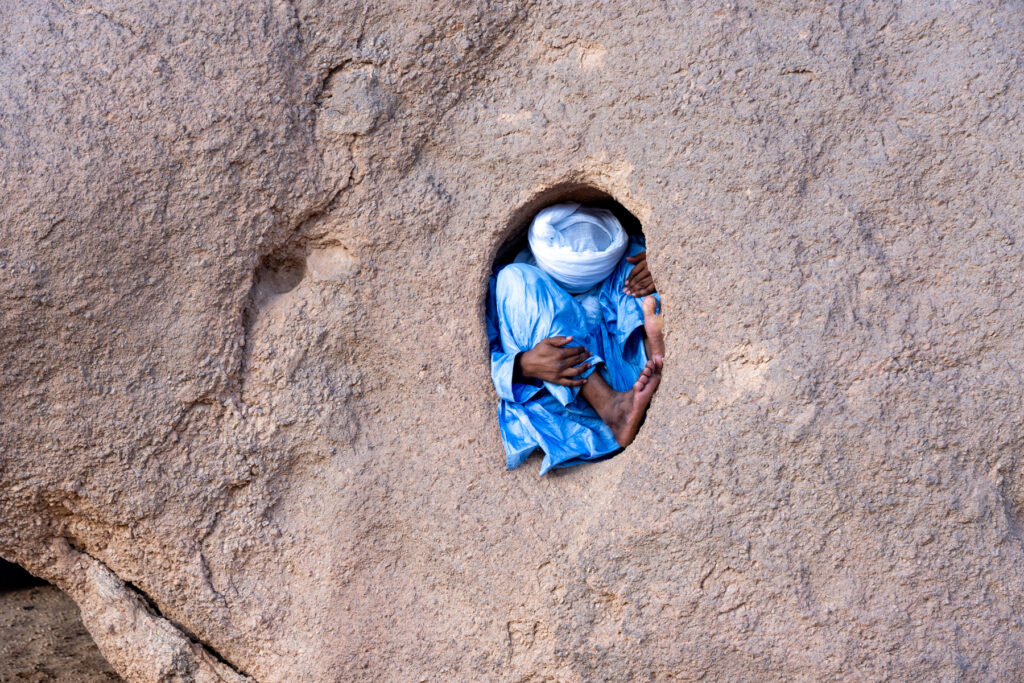
Legend states that if a person can get their whole body inside this rock hole, they will find their life partner (image by Inger Vandyke)
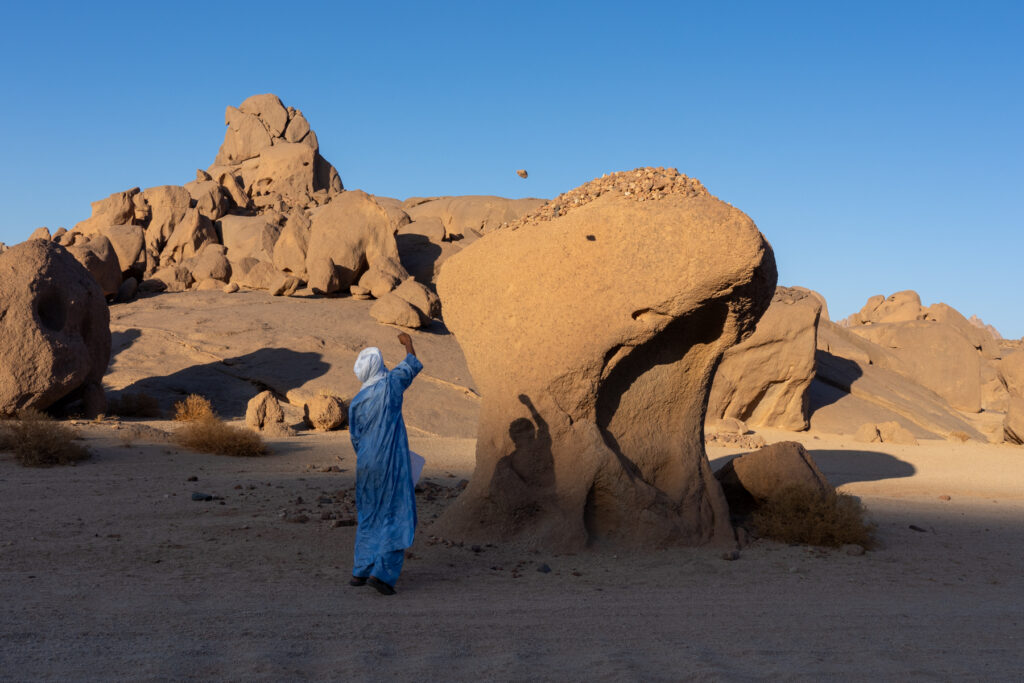
Our guide throws a rock on top of a rock pillar for good luck (image by Inger Vandyke)
We continued driving until we reached a small community of semi-fixed huts on the sheltered side of a mountain. When we stopped the car, I saw a diminutive and beautiful old lady emerge from one of them. I asked if it was OK for me to go and say hello. Our guide said yes and I went over to introduce myself to the matriarch of the family we stayed with. At once I was taken aback by her. She was remarkably elegant despite her advancing years and her finely wrinkled face told a million stories of the desert. Ashamed of her every day dress she asked us to wait until she went and dressed up a bit if we were going to take photos. To me it didn’t really matter what she wore in the end. She was such a beautiful and engaging person that her personality made everything look so beautiful.
We settled down to camp, opting to sleep on simple mattresses out in the open rather than staying in one of the huts. It was a fantastic night where we tried our first Tuareg tea, ate a delicious meal cooked over the campfire and enjoyed our first celestial photography in a stunning night sky with the lights of Djanet our only real source of ‘light pollution’.
The next morning we woke at sunrise to visit the local livestock holding pens of our host family’s livestock in pens and the well that keeps them all going in this semi-remote place. We enjoyed a breakfast with our host family and embarked on a slow drive back to Djanet, stopping to learn about some of the local vegetation and medicinal plants of the area.
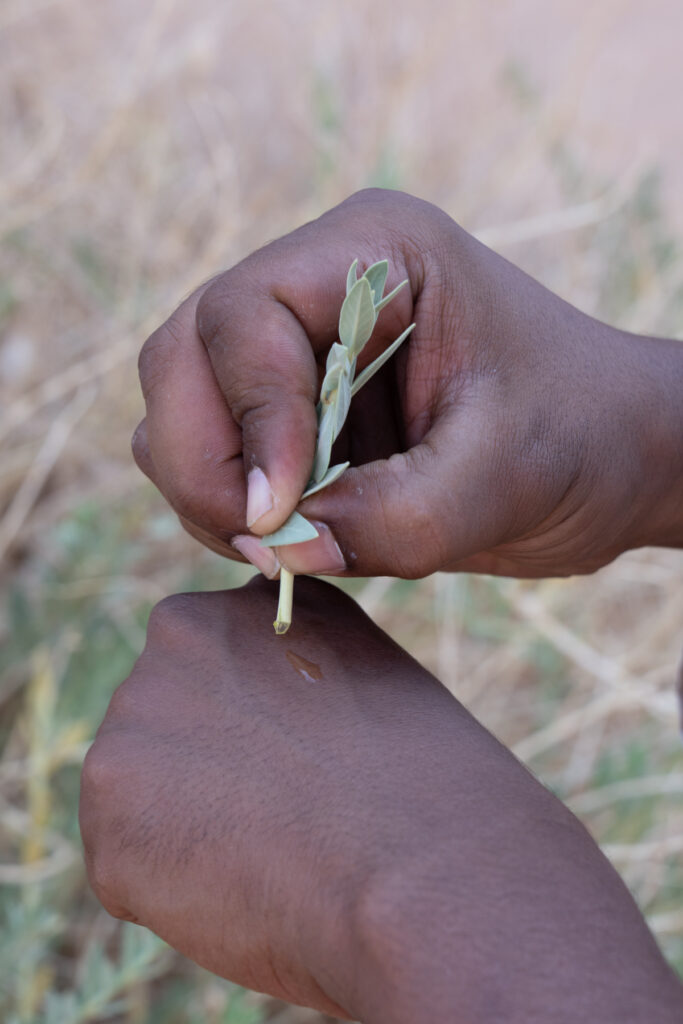
Learning about medicinal plant use in the desert. This is Arelechim which, if you cut a branch, the sap will stop a wound from bleeding (image by Inger Vandyke)
Tuareg Silversmiths at the Souk
When we got back to town we went into the local souk. I had been telling my guest about the incredible silversmith work of Tuareg people so this short visit gave us a chance to visit some local Tuareg silversmiths and buy some of their handmade items.
Afterwards we made a brief visit to a nearby hill mansion where we could get a view over the entire town of Djanet before we returned to our guest house for a break.
The Crying Bulls
After a long siesta we drove out into the desert to begin exploring the first of what turned out to be around 30 different rock art sites we would see on our entire tour, the famous Crying Bulls, or ‘La vache qui pleure’ in French. Legend says that an ancient cow shepherd brought his animals here in the hope of finding water to quench their thirst. When he arrived there was no water so the cows began to cry and as they died, one by one, he engraved motifs in a gigantic rock pillar to commemorate their lives.
Our first glimpse of this extraordinary site also allowed us to enjoy its desert landscapes taking wide-angle photos, experimenting with sun bursts and shadows. We also visited two other sites close to it, one also with engraved bulls and another with the first giraffe engraving we’d see on our trip.
We stayed out until sunset with the final blush of day washing the entire area with a rosy glow.
On the way back we stopped to photograph the silhouetted rocks of the desert with the crescent moon while our guide and driver took a moment to pray.
That night we joined a wonderful group of local women who were beginning to celebrate a wedding, joining them for dinner. Afterwards we were invited to join them in a night of celebrations with ululations, more food, singing and music played on traditional Tinde drums.
Oasis Farming
The following morning we went out to visit a local farming area where local Tuareg families keep small plots to raise animals, grow produce and keep their camels. It was a lovely flat walk through numerous thatched palm enclosures and we met one of the village elders who was the legendary guide responsible for putting many of the Tassili rock art sites on the map. Stopping at the farm of our guide’s family we tried some delicious sweet figs while watching some of the women in his family harvest fodder for their animals.
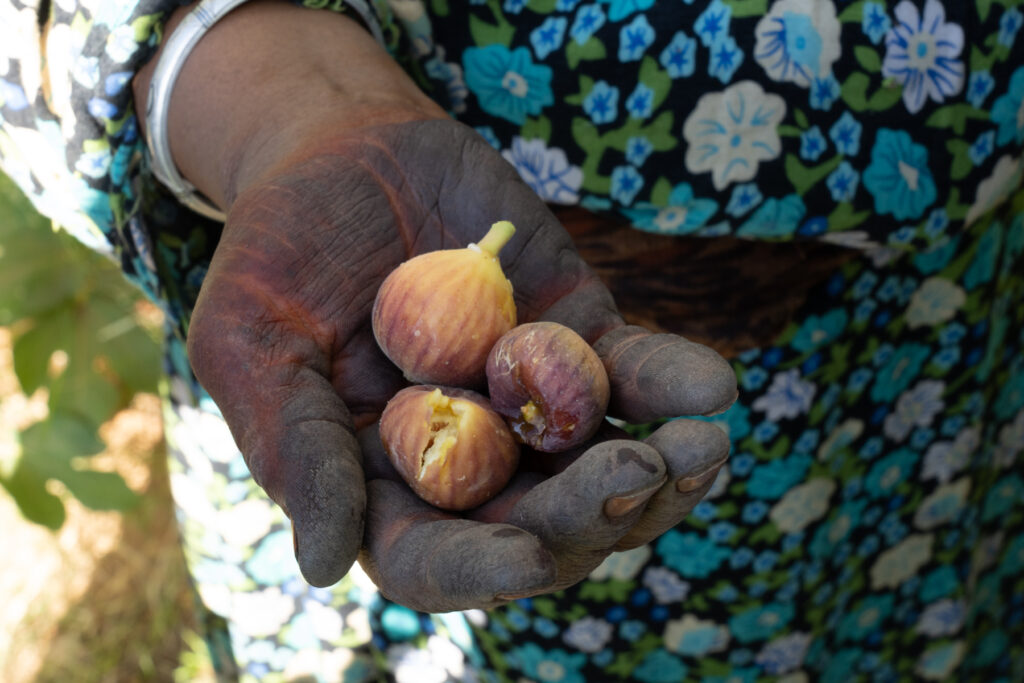
Fresh figs from a local Tuareg farm. Delicious! (image by Inger Vandyke)
Tiffnagh
Returning from the farm, our guide kindly invited us to visit his grandmother to learn a little about the Tamahaq language of Tuareg people.
In its written form, Tamahaq is part of the Tiffnagh group of languages spoken by Berbers and other people across the Sahara.
It is beautiful and is written in a similar way as Arabic, from right to left.
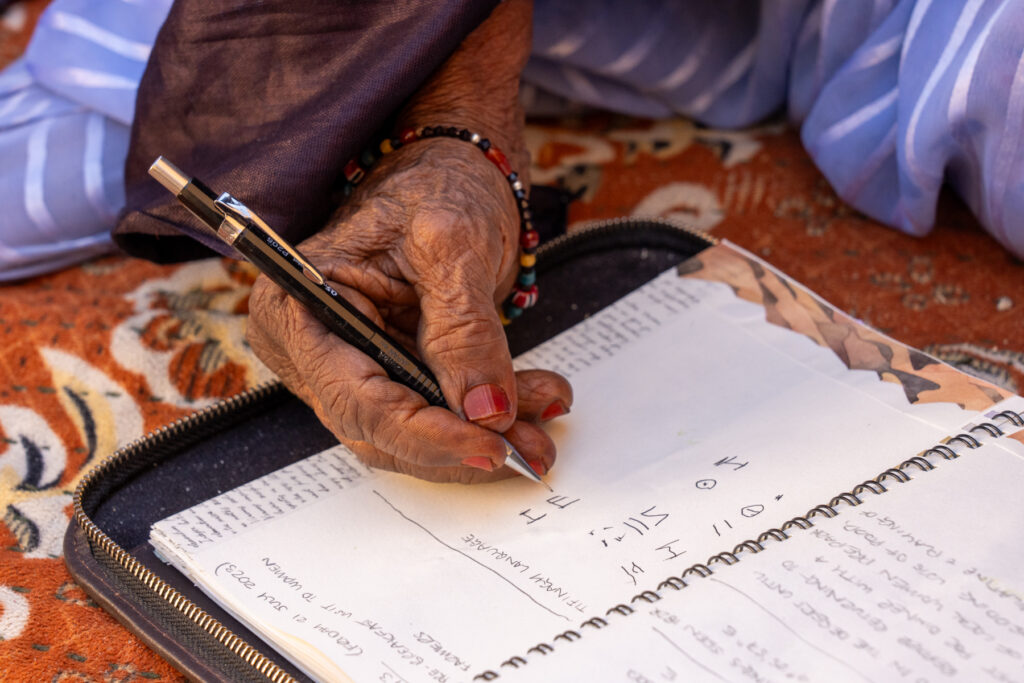
Learning Tiffnagh language with an elderly Tuareg lady (image by Inger Vandyke)
Sadly it is also a very troubled language. The Algerian school system doesn’t include the teaching of it in school curricula so the responsibility of documenting and teaching this beautiful language lies with elderly people who can still speak and write it, hopefully handing it down to younger generations, before it is lost forever.
Tuareg Wedding
That afternoon we were invited to a Tuareg wedding and our excitement about attending was palpable, to the point that neither of us could really sleep during our siesta.
After our language lesson we went off to join the same group of women from the night before and spent time with them celebrating the wedding of two brides, while singing and enjoying lunch.
On average a Tuareg wedding lasts around three days and usually they are strictly off limits to the public. We felt very honoured to be a part of the guest list.
Given the expense of weddings, often Tuareg families will marry two or three couples together to share the cost. At our wedding we met two beautiful Tuareg brides as they prepared for their meeting with their future husbands later that day. We were a bit surprised to see them both carrying knives, until we were told that each had to carry something to fight off any evil spirits, or jinns.
Although we were allowed to take photos, we were not allowed to publish them without permission due to the intense privacy surrounding this event. All of the images you see here were kindly allowed to be published after we asked.
We stayed until lunch before taking a brief break back in our room to cool off.
Later that day we were then kindly allowed to visit the Tuareg grooms preparing for their big event. We arrived to watch each of them being attended to by male groomsmen who engaged in wrapping multi-layered white and indigo tagelmousts on each man. It was time consuming and wonderful to see this cultural fingerprint of Kel Azjer Tuareg men as they embark on this next phase of their life. We stayed for a while photographing the grooms and male guests as they wrapped young boys in chech (plain cloth turbans) to prepare for the evening.
At one point we made a brief outing into the local desert with one of the men wearing indigo tagelmoust. He was a lovely friend of our guide, who we jokingly called our ‘Tuareg Supermodel’ after our brief photography excursion in the desert. It was an incredible and unexpected highlight of our afternoon as it was just us, our guide and this stunning man in such a wonderful art landscape.
When we returned the women of the wedding had arrived so we settled down to join this immensely special and vibrant ceremony which lasted well into the evening.
After a minor sleep in the next day we went off to visit two ancient Ksours, the former historical centres of Djanet.
Crowning the neighbouring hillsides of the town these ancient Ksours, or fortress-like hill settlements, lie in various states of preservation. Visiting all three of them on one trip isn’t common but each is a stunning example of the vernacular architecture of the Algerian Sahara.
Zalouaz
Our first Ksour visit was to Zalouaz, probably the least preserved of the three. While we waited for our local guide, I couldn’t help but admire the way it was built. Even though it had not been renovated Zalouaz was like a labyrinth of tumbledown stone walls at the base of a beautiful mountain koppie. The light was growing harsher by the minute so I resorted to one of my photographic tactics in these situations and I took some black and white photos of this charismatic place.
We spent around an hour and a half wandering the small alleyways of Zalouaz with a wonderful local guide and our own guide who generously shared information about its history while we took photos.
The highlight of our visit was the unexpected tiny mud mosque of Zalouaz, built in the boulders and the only real building that is maintained there. It was hidden down a ‘back street’ of Zalouaz, and built in the same Sino-Sahelian architectural style to mud mosques in neighbouring Mali and Niger, but on a much smaller scale.
Adjahil
We then went off to visit the second Ksour of our stay, Adjahil. Lying on the opposite side of the valley from Zalouaz, Adjahil was constructed at the base of a mountain with two natural springs. The buildings here date back to the 1600s when a Chadian trader from the Tibesti, region named “Ghawen” was heavily involved in founding Adjehil so we visited the springs, a watering pool and a well where local children had decided to swim. Afterwards we visited its ancient cemetery before returning to our guest house for lunch and a siesta.
The Dancing Camels
That afternoon we were invited for yet another wonderful behind-the-scenes visit to watch some young Tuareg men prepare for a camel dance. An important part of wedding celebrations, camel dancing involves traditionally dressed Tuareg men marching beautifully decorated camels out into the desert where they meet with local women singing and playing Tinde drums. It happens usually at sunset so we went out to watch young Tuareg men decorating their camels with colourful saddles and brass bowls while wrapping their indigo tagelmousts in time for the event.
We then walked out into the desert with them, stopping to take photos. It was so incredibly beautiful to watch this, and really very moving.
The rest of the afternoon was spent enjoying the ceremony with local people until sunset, photographing racing camels and the final highlight where cameleers encircle a group of singing women in the desert.
Tantalising Tadrart
For all of the wonderful experiences we had enjoyed with local Tuareg people in town, it was finally time to go to the desert so the next morning we left for the breathtaking reserve of Tadrart Rouge, lying east of Djanet close to the border of Libya and Algeria.
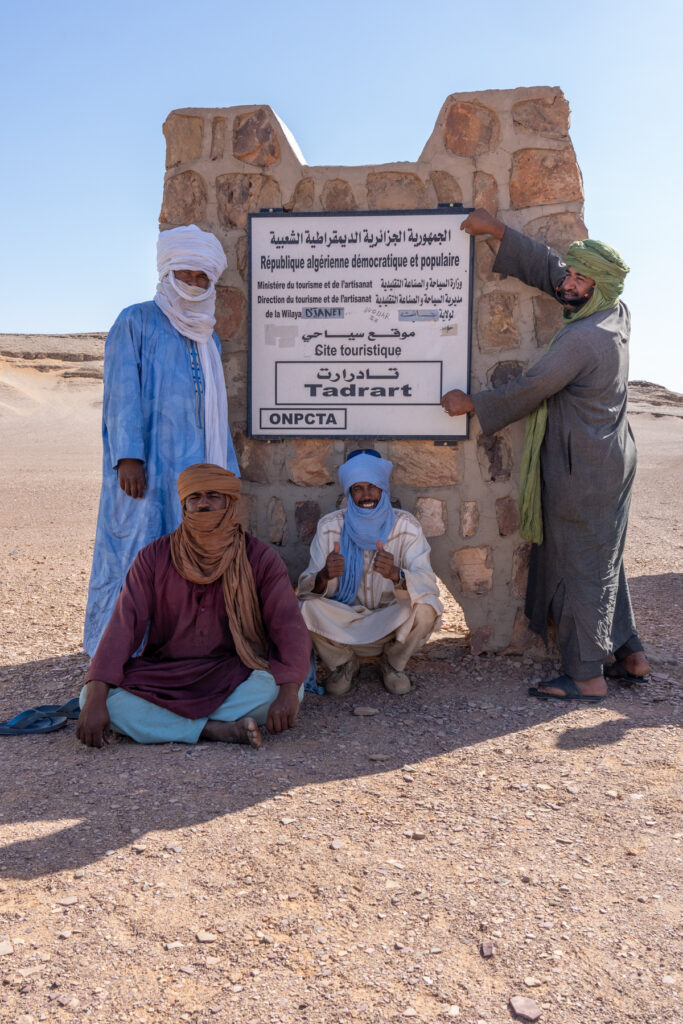
Our Tadrart team at the entrance to the reserve (image by Inger Vandyke)
Tadrart is one of the most beautiful desert landscapes on earth and our excitement about embarking on the drive down to it was barely containable.
It is an incredibly harsh place. Tadrart has little to no water and supports virtually no life. With the exception of one location (a valley at the entrance called Injaran that actually had quite a bit of vegetation), the only living souls we found were itinerant camels, urchin and scarab beetles, hardy little White-crowned Wheatears and a yet-to-be-identified species of Solifuge, or wind scorpion.
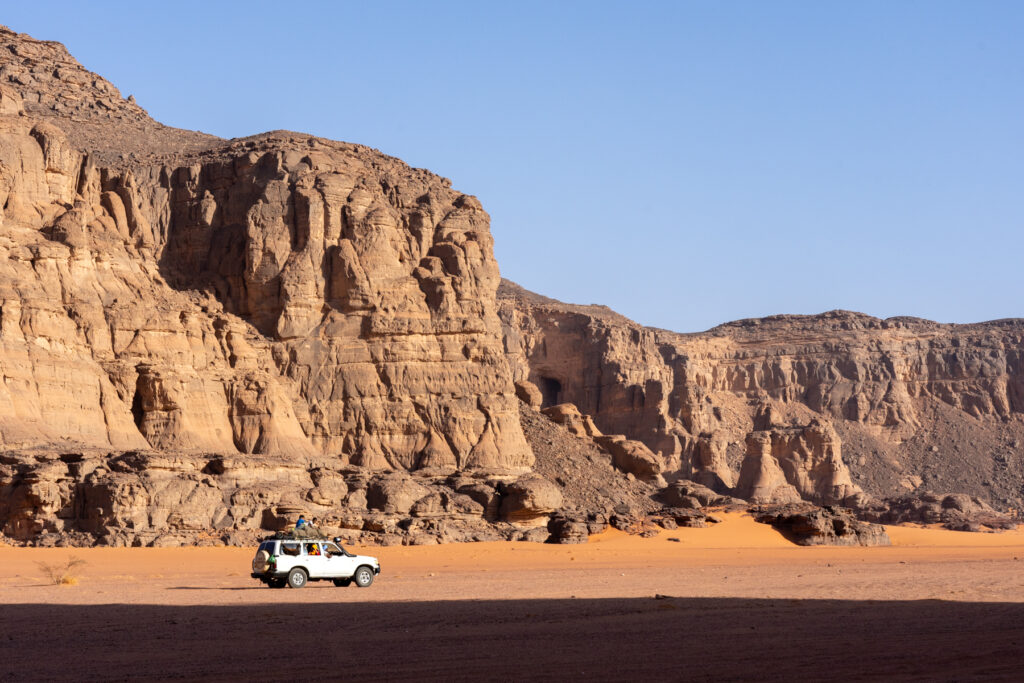
One of our expedition vehicles in Tadrart (image by Inger Vandyke)
After making sure our vehicles had all the necessary items to survive the next five days we stopped briefly for fuel and drove out to a site that would be our first introduction to the myriad of rock art sites we would see in the following days, the low slung hillock of Tabogayt. Here we scrambled over a boulder hill looking at engravings of grave markers, bulls, antelopes and giraffes, photographing many of them and recording their extraordinary details.
We enjoyed lunch and a siesta in a nearby rock arch close to an oued (gully) where there was some shade, before we drove out to Injaran, the entrance valley of Tadrart.
Imagine a great big dragon with a snake-like body whose mouth breaths fire into the unknown. Driving down the serpentine road that leads to Injaran, the valley that leads into the red sands of Tadrart, feels like you are travelling down a dragon’s oesophagus.
After traversing a section of rock desert we plunged into Injaran and found our first camp of the stay. The Tuareg will generally choose to camp away from rocks during the night, to avoid encounters with uninvited creatures like scorpions. After it got dark we started to be visited by several urchin and scarab beetles so I took a UV light over to see if I could find any scorpions. Sadly I didn’t find any but the next morning we woke up and went on a light trek at sunrise only to discover the footprints of numerous insects and small mammals in a perpendicular direction to where I looked. I made a note to myself to explore that area next time I go.
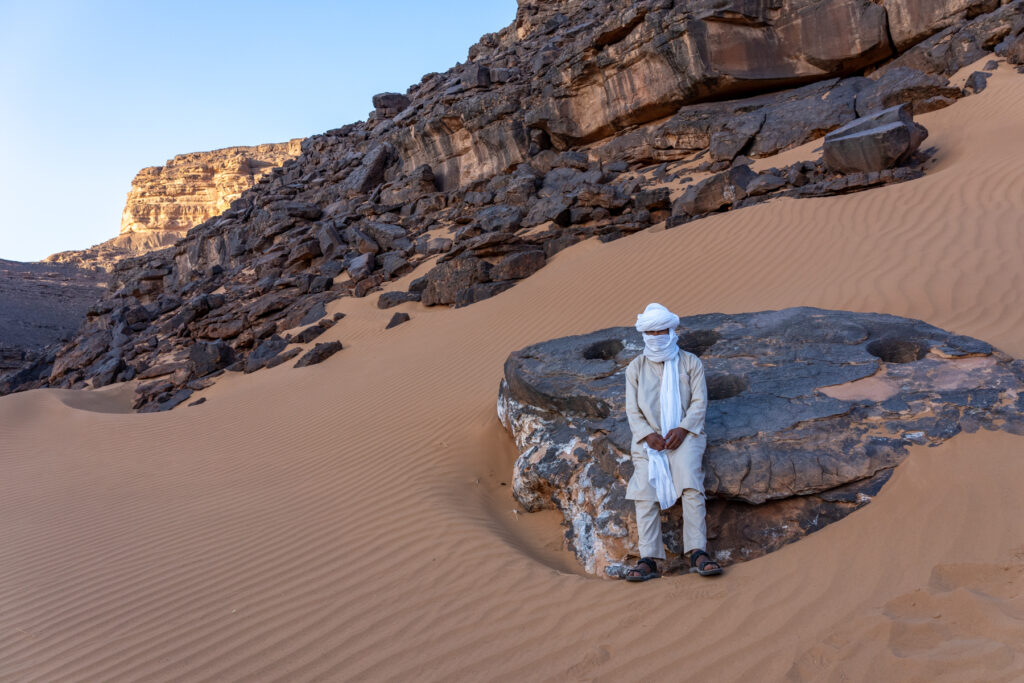
Our guide sitting at our campsite at Injaran (image by Inger Vandyke)
It’s easy to think about Tadrart as just being home to pretty landscapes. I naively thought it was going to be that – until we got there.
Over the next few days we were completely enthralled by visits to numerous rock art sites with stunning paintings and engravings. Fossilised forests of plants and the footprints of animals, ancient grave sites, slot canyons, caves, dunes and rock pillars all featured highly during our time in Tadrart. Literally every corner we turned introduced us to yet another sublime view.
We saw so much that I could write an entire tour report simply on Tadrart and skip everything else!
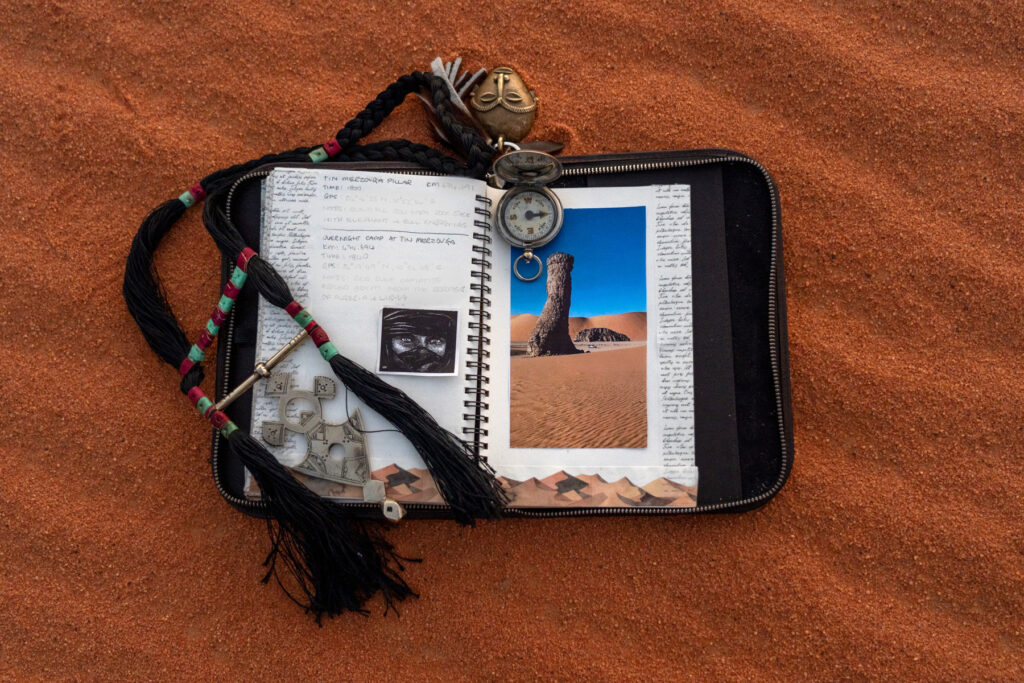
My desert diary complete with my old and trusted compass, a silver Tuareg necklace bought from the souk in Djanet and my zip-pull Waaba mask from Benin (image by Inger Vandyke)
Some of the many highlights of our time there including visiting Timjadawin, the gigantic cathedral of rock arches that is famous in this area; camping in Moul-Ennaga in a cradle of crescent dunes that warmed our bodies as we slept; visiting the stunning red dune landscapes of ‘Le Cirque’ and it’s molten-like rock caves and unbelievably clear night skies. Curiously while we camped in the site pictured below we actually saw Elon Musk’s Starlink Satellite Train powering its way across the night sky. Neither of us knew what it was at first, we only found out when we got back to ‘civilisation’.
Of more interest to us were the countless art and historical sites included the incredible giraffe engravings at Wan Ahar, the famous ‘pooping elephant’, fossil sites for footprints and even the grave of a smuggler who died when trying to cross Tadrart from Libya to drive to Niger.
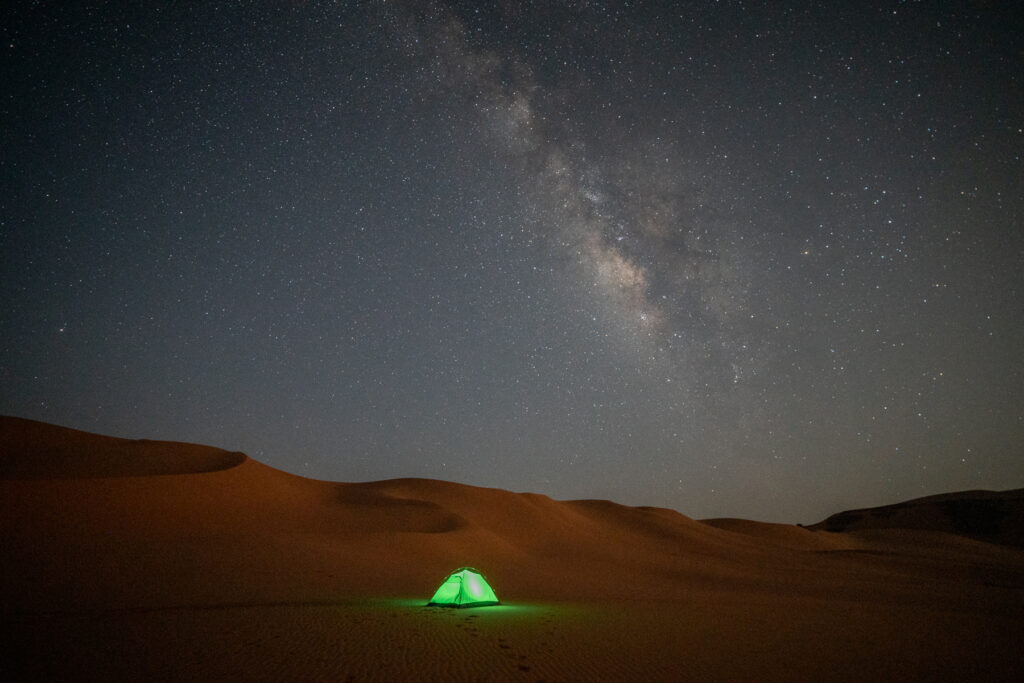
The Milky Way and our camp at Moul-Ennaga (image by Inger Vandyke)
Finally, just when we thought we had seen every possible beautiful thing we explored a lengthy slot canyon with parts of it that are so tight we had to squeeze through them!
Neither of us wanted our Tadrart excursion to end. There is just something really magical about spending time there. Maybe it was the stunning silence. Or the sensuality of the geography that flowed like the curves of a woman’s body. It was all so magnificent, enough to move even the most jaded traveller to tears.
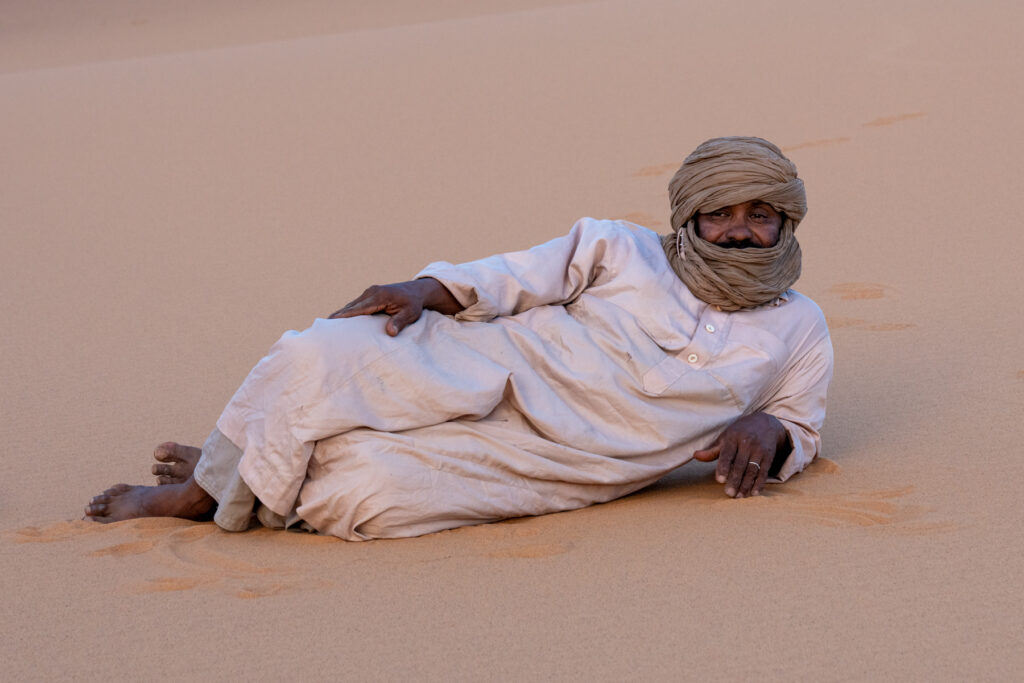
A bed of desert sand. Not only do the Tuareg understand sand, they flop down and rest on it at any opportunity (image by Inger Vandyke)
We travelled with a magnificent group of Tuareg drivers and guides in Tadrart. I cannot speak highly enough about what the experience is like to explore somewhere like this with the Tuareg, who follow its tracks like tracing the lines of your palm. To sit at night eating traditional Tagella and drinking their customary three cups of tea cooked over an open fire is just wonderful. Falling asleep at night the only sound you will hear in Tadrart are the laughs and melodic Tamahaq conversations of your team. At sunrise you can lie half asleep listening to “Allah u Akbar” calls of prayer in the otherwise silence of the sunrise. They make you feel instantly at ease and safe in their world. I’ve always felt that whatever harshnesses life might throw at you in the desert, alongside Tuaregs you are in good hands.
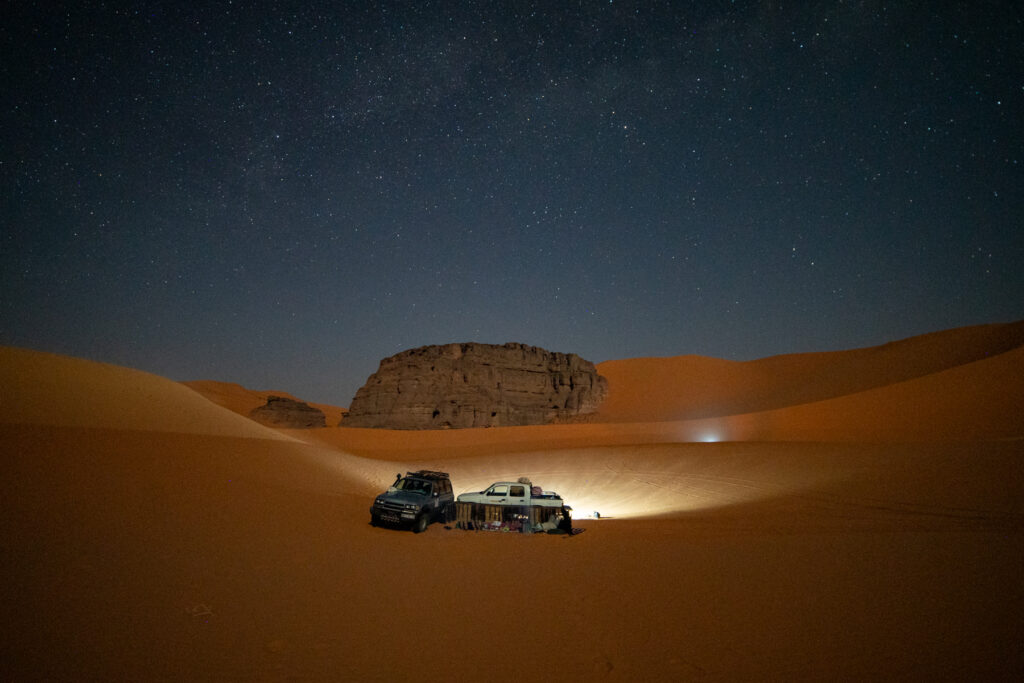
Sleeping in a cradle of warm sand, covered by a blanket of a million stars. This was our camp at Moul-Ennaga in the Algerian Sahara. Dinners are served sheltered from the wind by Tuareg mats and are delicious! (image by Inger Vandyke)
As we were leaving and saying our final farewells to Tadrart we stopped at a natural local chalk pit for our driver to collect raw chalk. He planned to take some chunks of it back to his children so they could use them on blackboards as part of their studies.
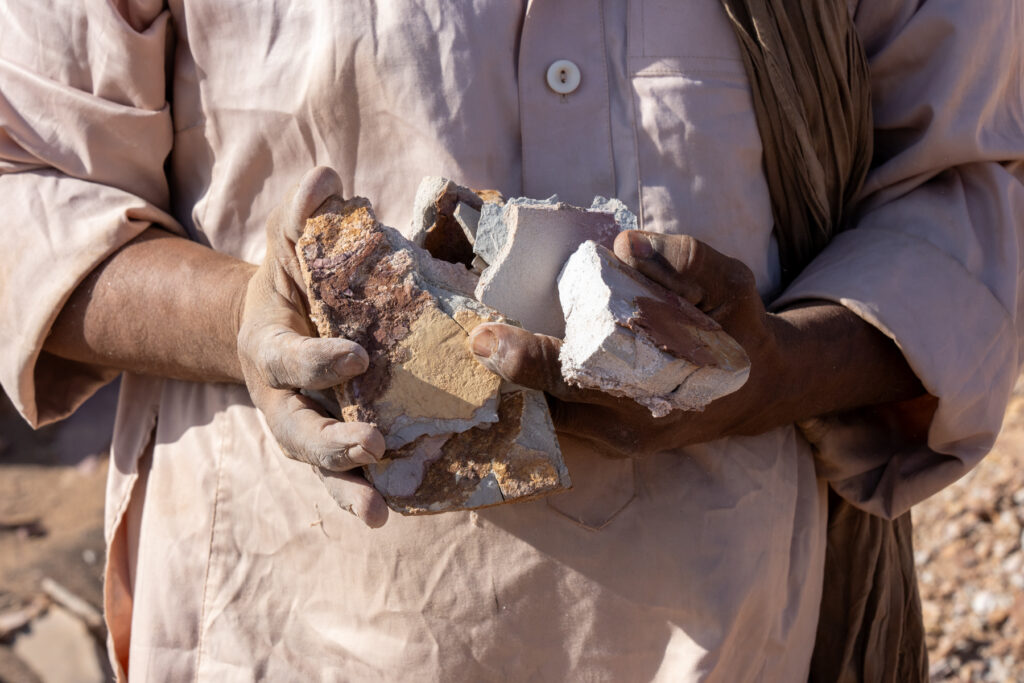
Collecting chalk. Our guide gathers raw chalk to give to his children who will use it on blackboards as part of their schooling (image by Inger Vandyke)
Towards the end I never wanted it to finish. “Surely there’s more” I found myself thinking. I never wanted to return back to our world filled with noise, internet, air conditioning and cars. By the time we got back I’d had an hour of all that and I was ready to turn around and go straight back out there.
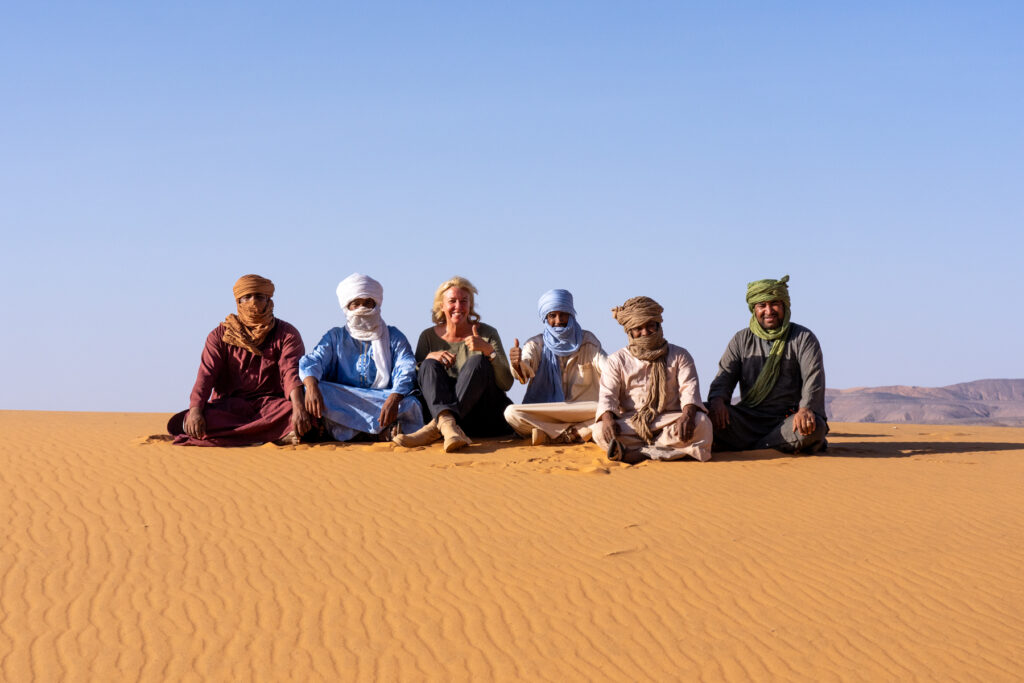
Team Tadrart at the end of five days in the desert. The best group of guys you could dream of to travel through the desert (image by Inger Vandyke)
Taghorfit and Traditional Tuareg Dress
Still, the remainder of our tour lured us out of the desert and when we arrived back in Djanet we took some much needed cool showers before enjoying a break.
That afternoon we visited the local souk to buy some more Tuareg items including lengths of cloth to wrap as chech. We also tried to buy a leather bag that Tuareg people use to carry their tea making goods but we had no success.
As the sun became lower we went to visit the third of Djanet’s three ksours, Taghorfit. This stunning place is the best preserved of all three of the ksours in Djanet with its adobe walls regularly renovated to preserve it. The main architecture of Taghorfit is similar to adobe with mud walls and stairs supported by old date palm logs.
Exploring it until sunset was wonderful. The air was still warm and the light was beautiful. We were getting closer to the annual ceremony of Sabiba and while we were in Taghorfit a small exhibition was taking place to show visitors more about Tuareg culture in Djanet. The highlight of this was spending time with two elaborately dressed young Tuareg girls, each wearing loads of silver jewellery and indigo robes. They were both ethereally beautiful and we both found it hard to stop taking photos of them! What a magical and unexpected highlight of our visit to this otherworldly ksour!
Timoulawine – The Night Rehearsal for Sabiba
After dinner at our guest house we went into Djanet to witness Timoulawine, one of the rehearsal sessions for the annual Tuareg ceremony of Sabiba. Due to the intense heat we experienced during our trip the local people waited until around 11pm before starting this important event that forms a part of the leadup to the main Sabiba ceremony.
The first Timoulawine we went to was at Elmirhan and we arrived with a throng of local people who gathered to both watch and perform at it. Plain clothed Tuareg people came from everywhere and the rehearsal began with women singing and beating drums. Shortly afterwards the men arrived waving their decorated Takouba swords in the air and dancing the same moves that they would do if they were performing at Sabiba.
Although the light was difficult for photography the atmosphere was wonderful and after the main event started to finish at Elmirhan, we went over to the second one at Zalouaz. In the end they didn’t finish until around 1am!
Erg Admer – Djanet’s ‘other’ Desert Wonderland
The next morning we embarked on our last early start of the trip to explore the nearby desert wonderland of Erg Admer, that lies to the west of Djanet.
It only took a few hours to explore this smaller region but it was no less enthralling than its larger cousin of Tadrart.
We visited a number of fantastic rock art sites here including one that had some ancient fragments of clay pots on display.
It was here that the Chadian trader Ghawen (who founded Adjahil) was chased into the desert by local people after years of torture and enslavement. He was eventually killed by the people of Djanet and they buried him where he fell.
Erg Admer is a somewhat different desert landscape than that of Tadrart. We navigated narrow tracks in our car and drove through countless islands of rock in a sea of sand.
Due to the tight turnaround between the late finish of the previous evening and an early start we decided to retreat back to Djanet for a longer than normal siesta to escape the heat.
Tuareg Leatherwork and Crafts
Aside from silver, the Tuareg people are known for their brightly coloured leatherwork, their woven mats and also their textiles. In the afternoon we had a delightful visit to a local cooperative where Tuareg women were making items by hand in a small museum. Some of them were for sale so we bought a few things to encourage this wonderful initiative aimed at preserving these vital artisan skills in Tuareg culture.
Riding Camels in the Desert
After our brief shopping session we both embarked on a fantastic camel ride with local Tuareg cameleers in the desert. Many years ago, when I went to Tamanrasset I had also done this (pictured above) and I really loved it so when the chance came up to do it again we jumped at it and went for a wonderful ride late that afternoon with some local Tuareg cameleers.
Mechaoui
For dinner that night, we had a wonderful experience of dinner in the desert accompanied by Tuareg music. These evenings, called Mechaoui, are a fantastic way to introduce you to some of the more popular Tuareg music including the famous group Tinariwen and lesser known musicians like Imarhan and the local singer Nabil Baly Othmani. It truly was a lovely way to spend the eve of Sabiba in the warm air of the desert night with our newfound Tuareg friends
Sabiba
On our final day of the trip we celebrated Sabiba. The biggest annual event on the Tuareg calendar, Sabiba was inscribed on the UNESCO Representative List of the Intangible Cultural Heritage of Humanity in 2014. The ritual and ceremonies of Sabiba are practised by two communities of Tuareg people living in Djanet during ten days in the first month of the Islamic lunar calendar.
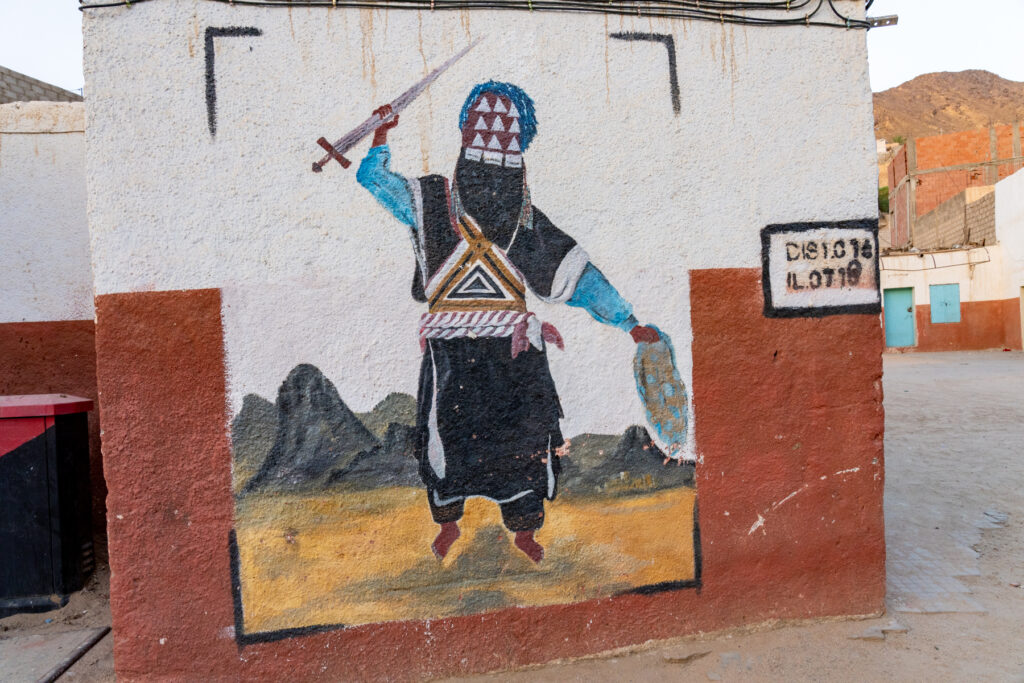
Sabiba street art in Djanet (image by Inger Vandyke)
Tuareg male dancers, dressed as warriors, and female singers walk to a place called a ‘Loghya’ for the performance of the ritual. Once there, the male dancers parade and present their weapons, while they walk a ritual circle rattling their swords continuously as the women sing traditional songs to the rhythm of the drums. At the end of the day, the participants disperse. Knowledge related to the ritual and ceremonies is transmitted directly from older to younger members. Local craftspeople produce and repair the uniforms, weapons, jewellery and musical instruments required for the ritual and ceremonies.
The day is split into two sessions, one in the morning and another in the afternoon, with a break in the middle of the day. The timing of it makes photography a little challenging but once the action kicks off and the dancers swirl dust into the air the atmosphere can become quite magical.
We arrived around the same time as Tuareg women gathered in all their finery to play music for the warriors. The warriors then entered and danced around in circles as part of the ‘friendly battle’ between clans at Sabiba. Towards the end of the morning the male dancers unwrapped huge swathes of indigo dyed cloth to dance with it which was a true highlight.
After a break in the middle of the day we were invited for a privileged, behind the scenes look at a group of young Tuareg men getting dressed up for the afternoon ceremony of Sabiba. This alone was beautiful and it gave us the chance to spend some private time with the performers away from the crowds of the public. After a few photos of individual dancers and a group photo of one clan I was amused to discover that, dressed up Sabiba warriors are unable to fit into a car! So we watched in amusement as they tailgate rode 4WD vehicles into the Loghya to perform the final act of the ceremony.
The afternoon ceremony appeared to attract a few more people than the morning session and a highlight was two highly decorated cameleers who rode their steeds into the crowd, exciting the local children. Occasionally the cameleers would break away from the crowd, race their camels into the desert only to be followed by crowds of over excited children running behind them in the dust!
Sabiba continued until dusk and we finally tore ourselves from the event when the light was becoming difficult to take photos.
On our final night of the trip we enjoyed our last dinner in the desert with our Tuareg friends under the light of the full moon. It was a tremendous end to this wondrous journey that brought back so many fond memories for me. The Tuareg of my youth have changed a lot but their magical hospitality, warm charisma and way of life is still there, even with their shift in geography.
Now as I sit at home writing this tour report, I am publishing it after confirming my 2025 tour back to Djanet. It filled in almost a record time for Wild Images, and stunned me. Maybe it was my enduring love of Tuareg people that showed in the photos I took there or my guests saw it as window of opportunity to enjoy a uniquely Tuareg designed trip in one of the most beautiful landscapes on earth. Either way, I’m looking forward to returning in a couple of years with a wonderful group of guests.
After all, you might be able to shake the Saharan sand from your shoes, but it’s hard to shake it from your soul.
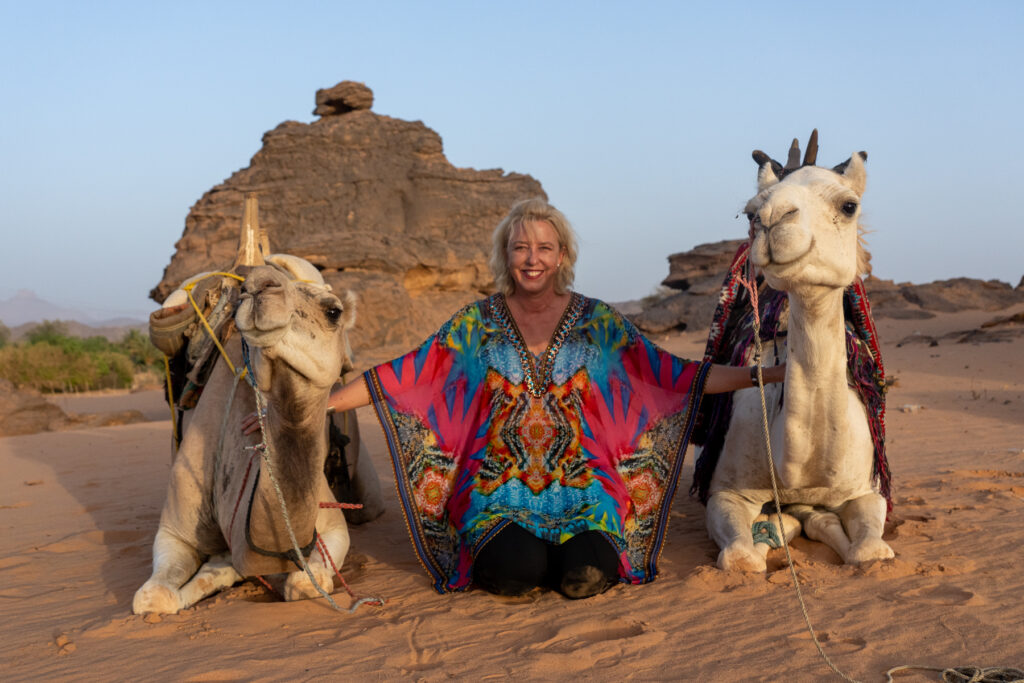
Me riding camels outside of Djanet in 2023 (image by Mojgan Arashvand)















































































































